Francesca and Henk-Jan's Backpacking Trip!
Thursday, September 2, 2010
Patan
On September 1st, Henk and I decided to hire a taxi from the hotel and head out to three places – Swayambhunath, (also known as ‘Monkey Temple’ because of the (duh) abundance of monkeys on its grounds) the Natural History Museum, and the National Museum before heading back to Kathmandu’s Durbar Square to witness a festival going on there in honor of Krishna’s birthday. Unfortunately, we soon learned (after driving there) that the museums were both closed since it was a national holiday. Thankfully, Swayambhunath was close by and we were able to do something on our ‘list’ for that day, arriving around 1:30 PM. The taxi dropped us at the entrance and waited in the parking lot while we climbed the steps up.
One thing to note – the spiritual concepts of Hinduism and Buddhism are often mixed in Nepali religious belief. While most people self-identify as Hindus, they also accept many Buddhist ideas as their own and vice-versa with the Nepali self-identified Buddhists. Thus many of the sites Henk and I explored in and around the Kathmandu Valley included both Hindu and Buddhist aspects. Swayambhunath is a Buddhist site, specifically special to Tibetan Buddhists but at the same time the site is sacred in Hinduism as well, so we saw plenty of Hindus there.
Henk and I viewed the ‘World Peace Pond’ complete with Buddha statue in the center before we walked up the right-hand stairway, making sure to walk clockwise, keeping the stupa on our right side. And of course there are the monkeys – which happen to be holy monkeys! According to Wiki: “They are holy because Manjushree, the bodhisattva of wisdom and learning was raising the hill which the Swayambhunath Temple stands on. He was supposed to leave his hair short but he made it grow long and head lice grew. It is said that the head lice had transformed into these monkeys.” We maneuvered our way past them, bought a bottle of water, and continued until we could see an amazing view of the valley below.
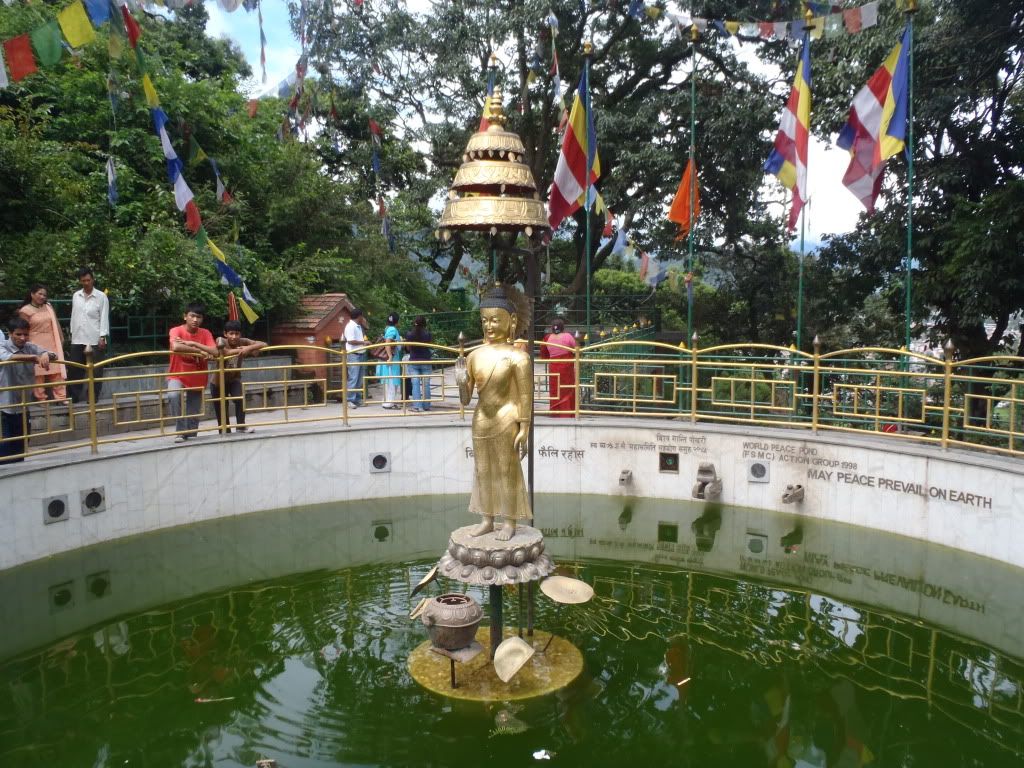
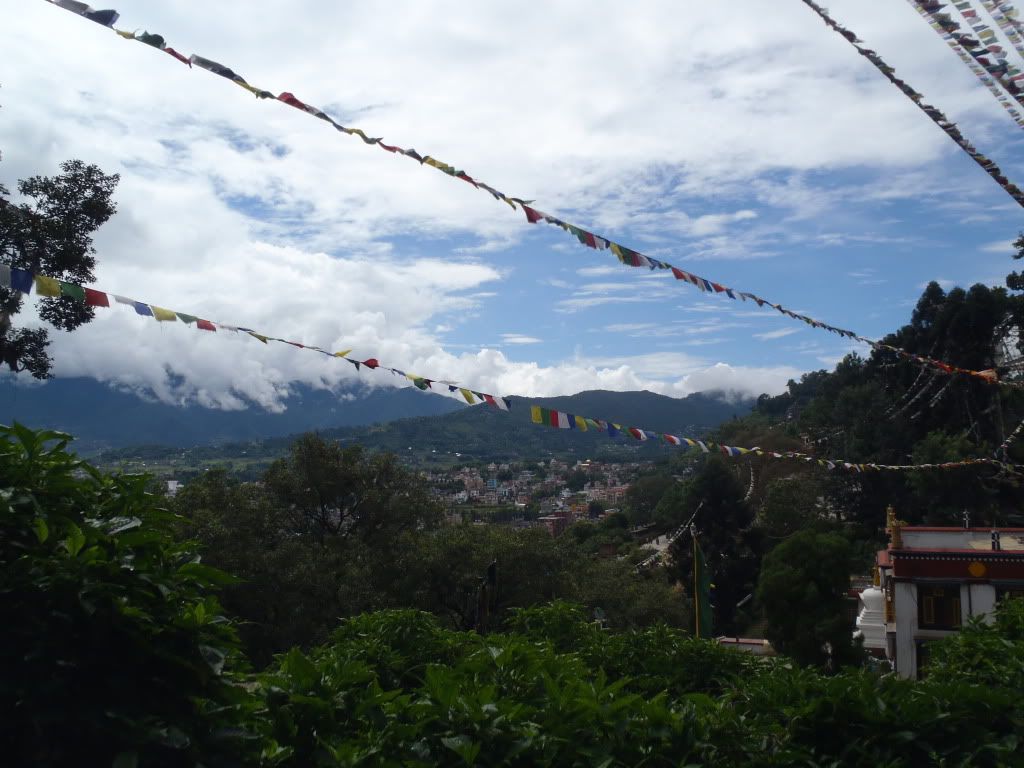
First we explored the grounds, walking to all corners of the complex and noticing an interesting game called “Tiger Moving” for sale involving a game-board and miniature tigers and goat figures. The object of the game is for the ‘tiger player’ to be on the offensive with the ‘goat player’ on the defensive. While we wanted to purchase one the prices, even after haggling, were still too high – but we did find out they are manufactured somewhere on Freak Street and made a mental note to try and get one later. The one purchase we did make at the temple was miniature versions of ‘Buddha’s Eyes’ necklaces for our collection of little charms from different countries.
There was a tiny museum at the temple which housed some statues which we ducked into first, but the main ‘event’ at Swayambhunath is a large, white stupa sitting in the center of the raised platform. The stupa has both “Buddha’s Eyes” and the swirling symbol of “Unity” in Nepali in between the eyes. While we had seen these Buddha Eye stupas quite a few times now in Kathmandu, this was particularly striking because of its size. It was quite eerie to know that no matter where you walked in the complex, you could look back and see the ‘all-seeing’ staring back at you. The large dome recently had 20 kgs of gold added to it, as part of a renovation project.
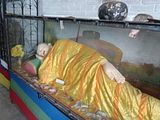
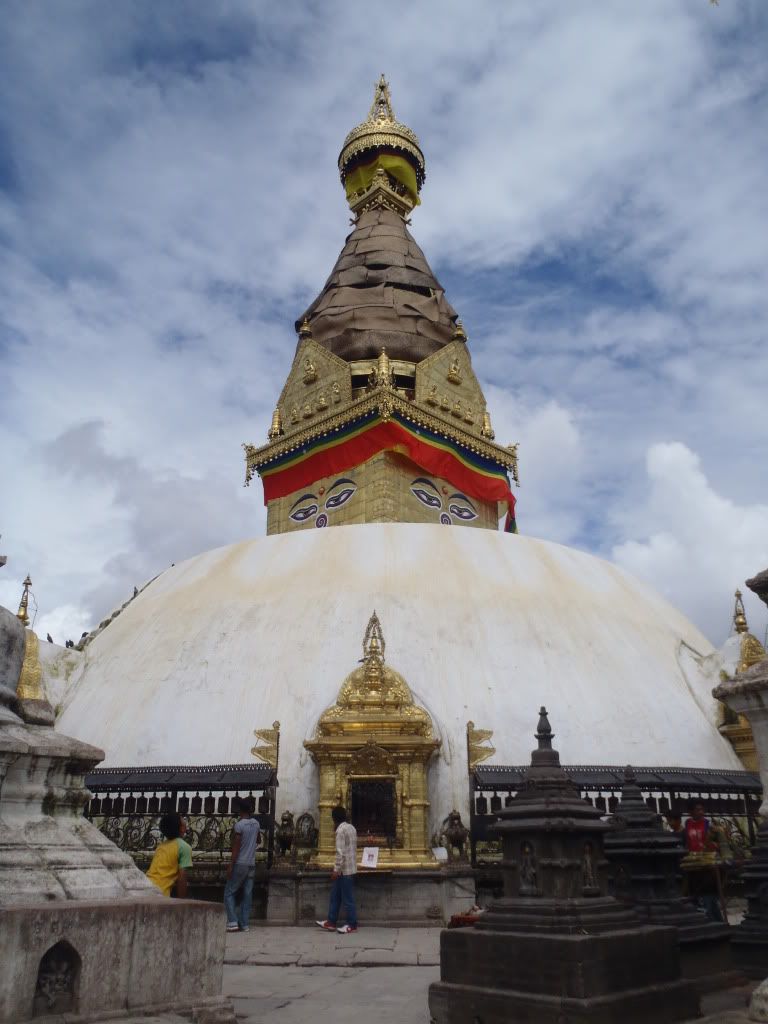
As we walked around the stupa, we noticed a bunch of ‘mini stupas’ to the side… an entire army of them! On our way to explore them we came across a curious monkey who was trying to get inside a large, white bag. Another monkey joined the first and they managed to rip a hole to get to the contents inside. As we were taking pictures of the valley below, we encounter monkeys yet again. One decided to jump onto the banister separating everyone from the long drop down, which caused both us tourists and local Nepali to jump back a little. But thankfully, someone managed to satisfy the monkey with a cucumber slice and he soon let everyone return!
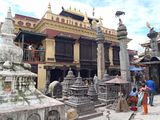
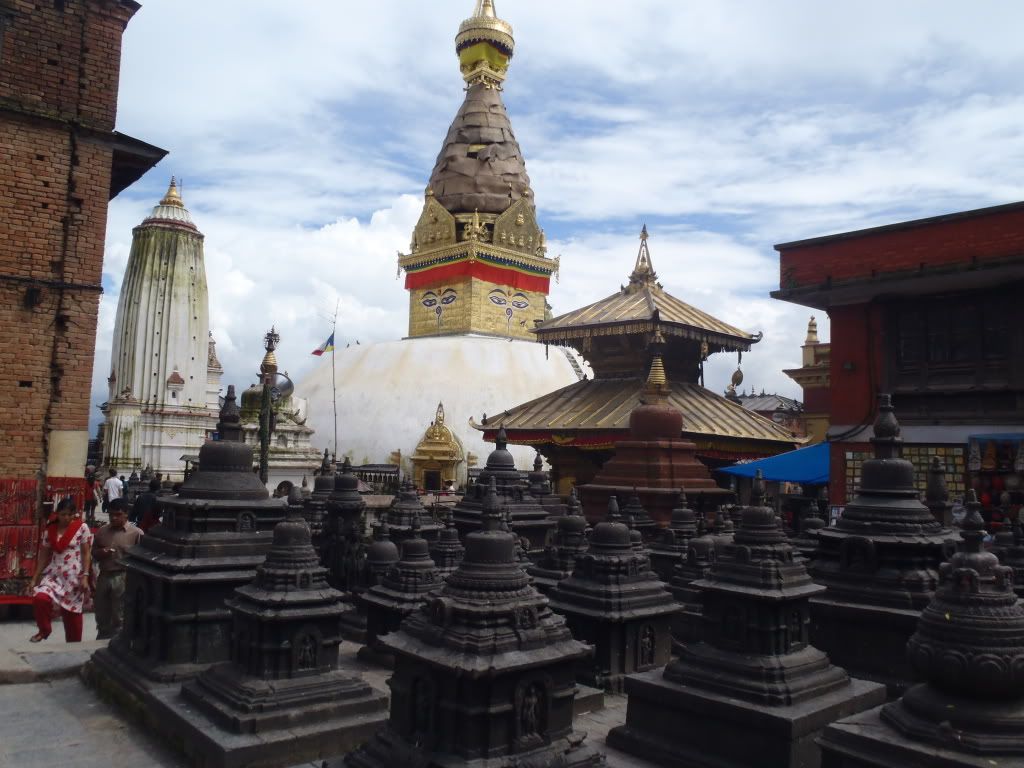
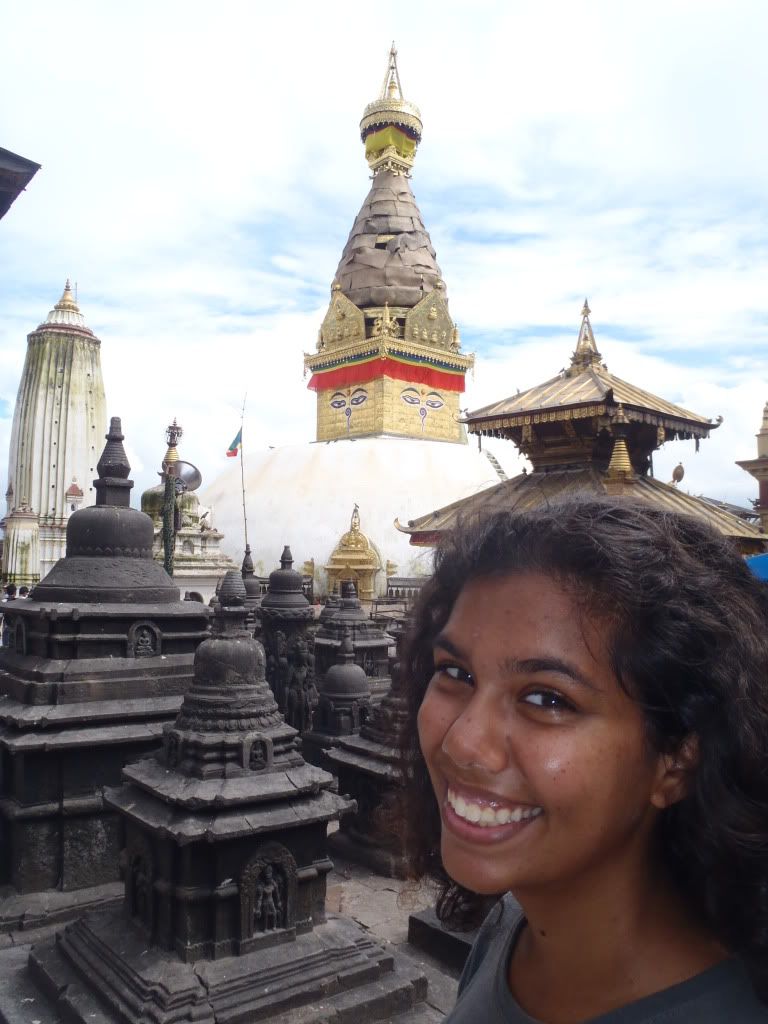
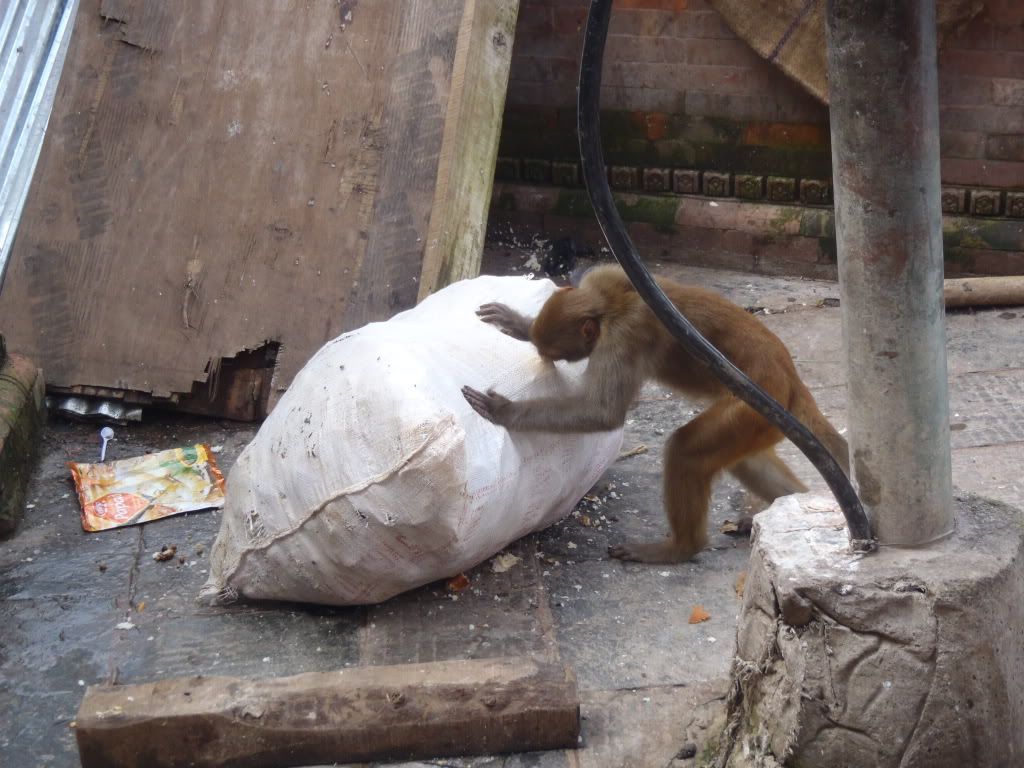
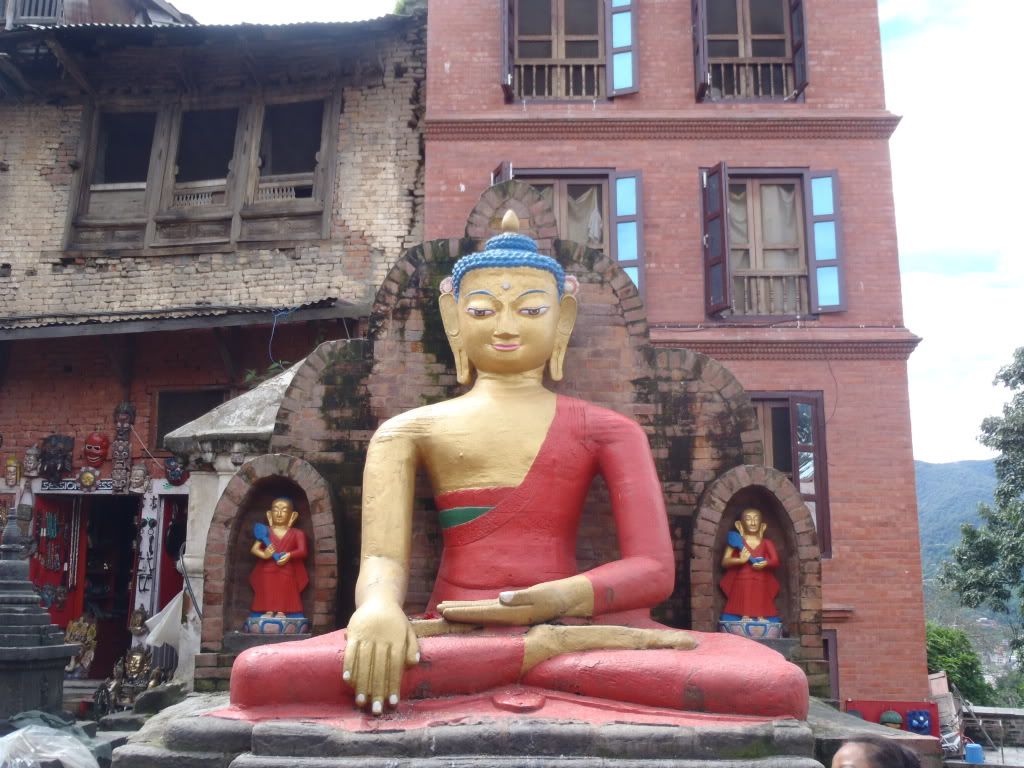
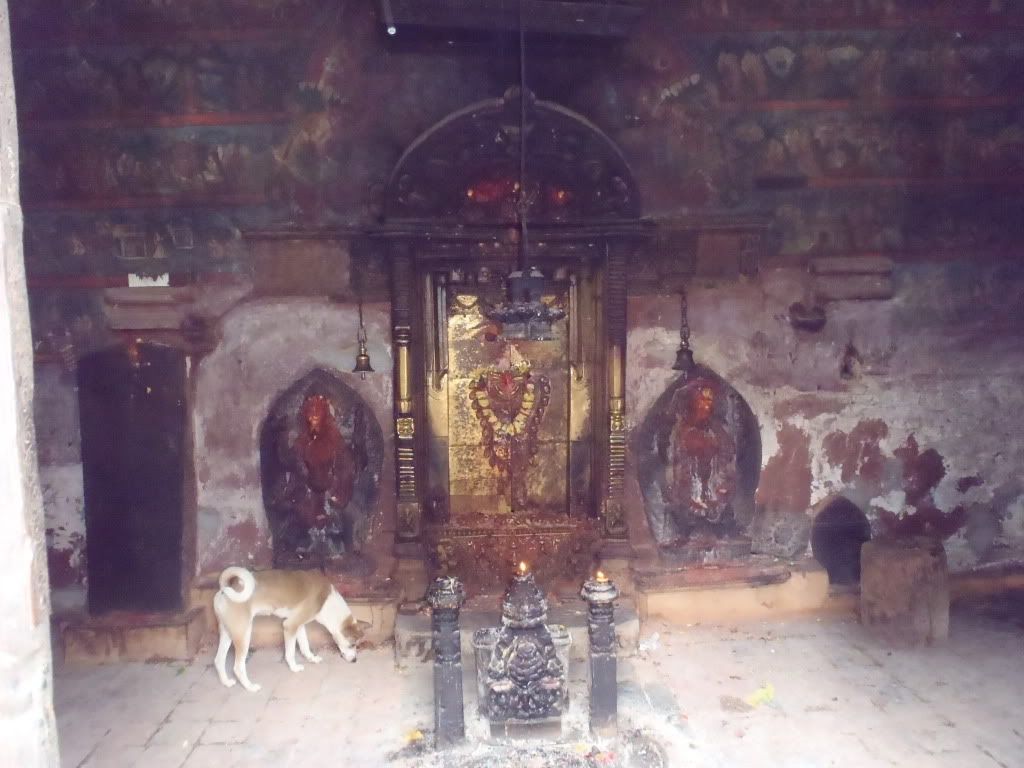
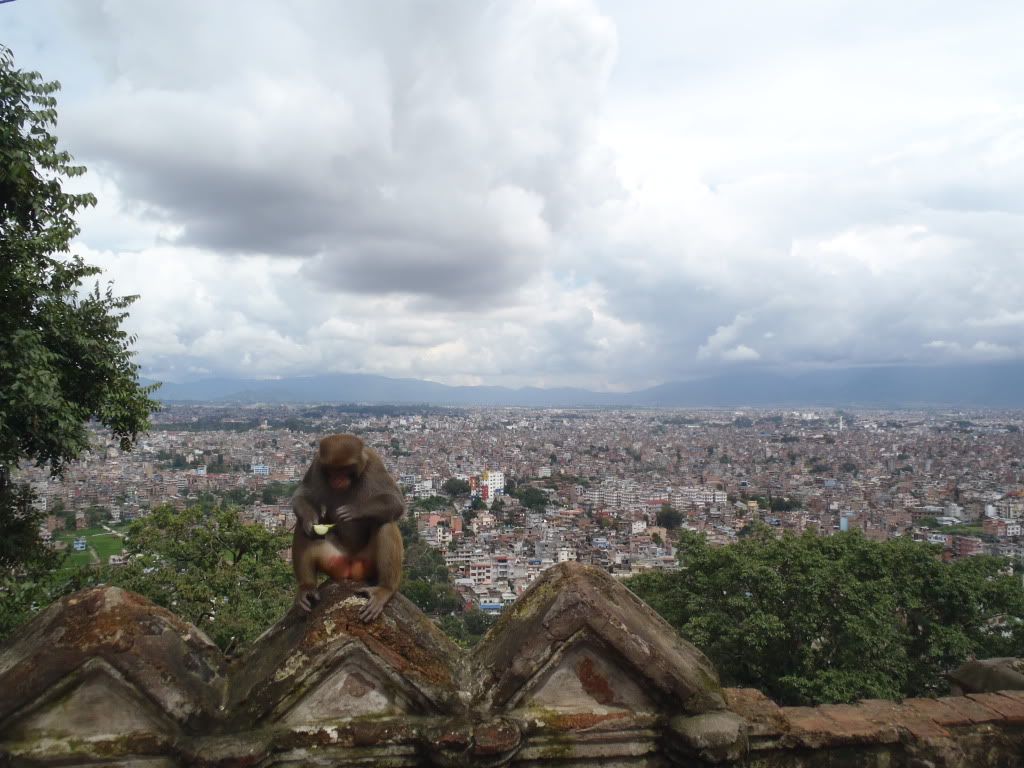

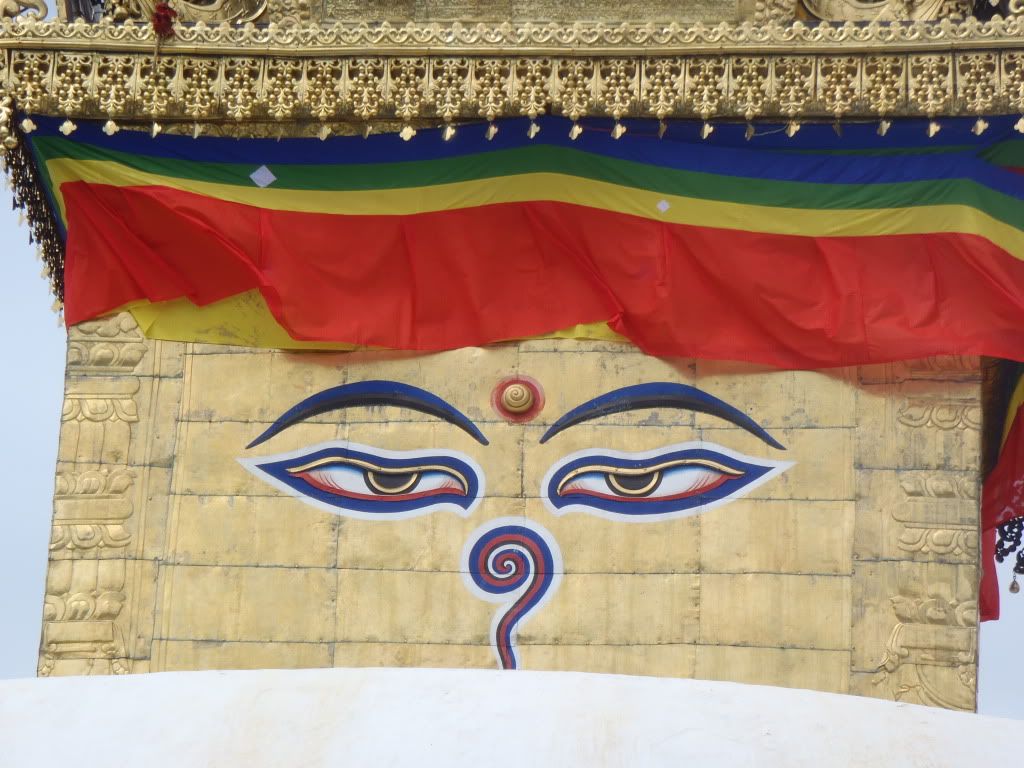

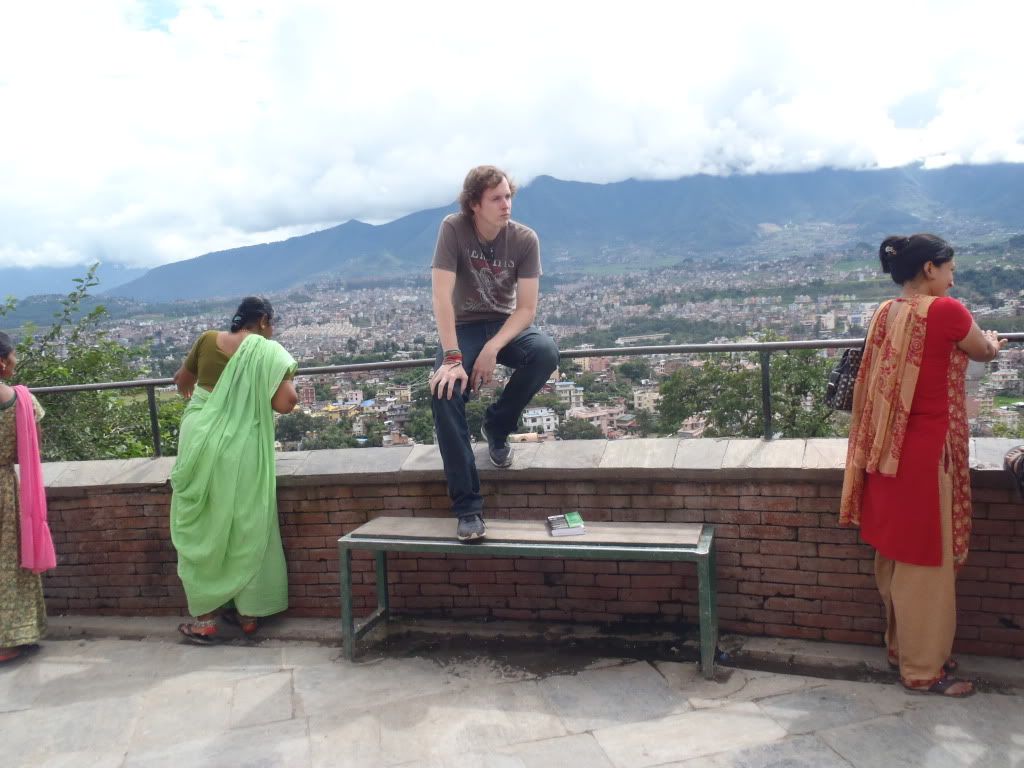
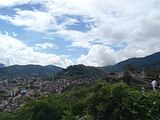
Once we finished at the temple, Henk negotiated with a taxi driver to take us to Durbar Square for the day’s festival. We weren’t really sure what to expect, but we knew the festival was going to be going on all afternoon and it would be cool to see some of it. Nepali, like Filipinos, are infamous for their huge number of festivals – pretty much something going on every other week during the ‘busy’ times – and we wanted to experience some of the fun! Once the taxi dropped us off in the square, we immediately noticed a difference from our first visit to the square; first of all everyone was decked out in beautiful, colorful clothing, especially the women in their bright red, sparkly saris! Every single one of them had jewelry – rings, earrings, necklaces, bangles! Walking around without anything dangling off or jingling on yourself would seem quite plain in Nepal! All of the action was located at Krishna’s (an avatar or incarnation of Vishnu) temple in the square where colorful strings of banners had been put up.
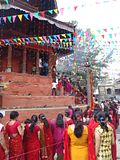
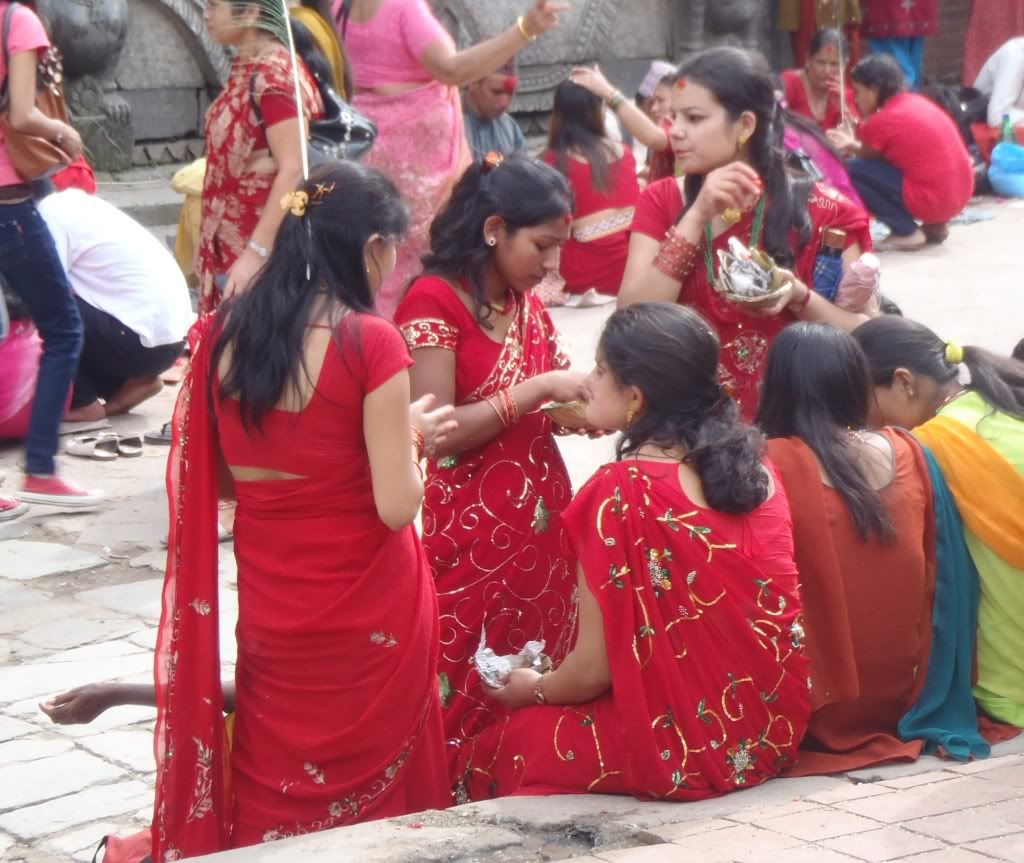
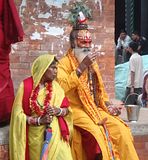
There were men sitting on the streets with sheets laid out in front of themselves and women surrounded them. Once we saw colorful bowls, we figured out that they were men who could apply a ‘fancy tika’ (the red marking over the third eye) to those who wanted one for the event. And of course, in front of Krishna’s temple, was a long line of people waiting to give their respects to the divine on his birthday. They would enter the temple, go up the stairs swinging a basket, perhaps for the god’s attention or well-wishes, and then leave offerings before the image inside. After watching the line of devotees for a while, we followed the sounds of music to a spot across from the temple where tons of local Nepali were gathering together to dance. People would just get up randomly to start a dance or join in and it was entertaining to watch those in the colorful outfits dance traditionally along with the music. But the people dancing in jeans the T-shirts – well, that wasn’t so special, so we soon moved on.
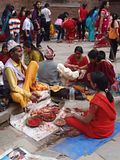
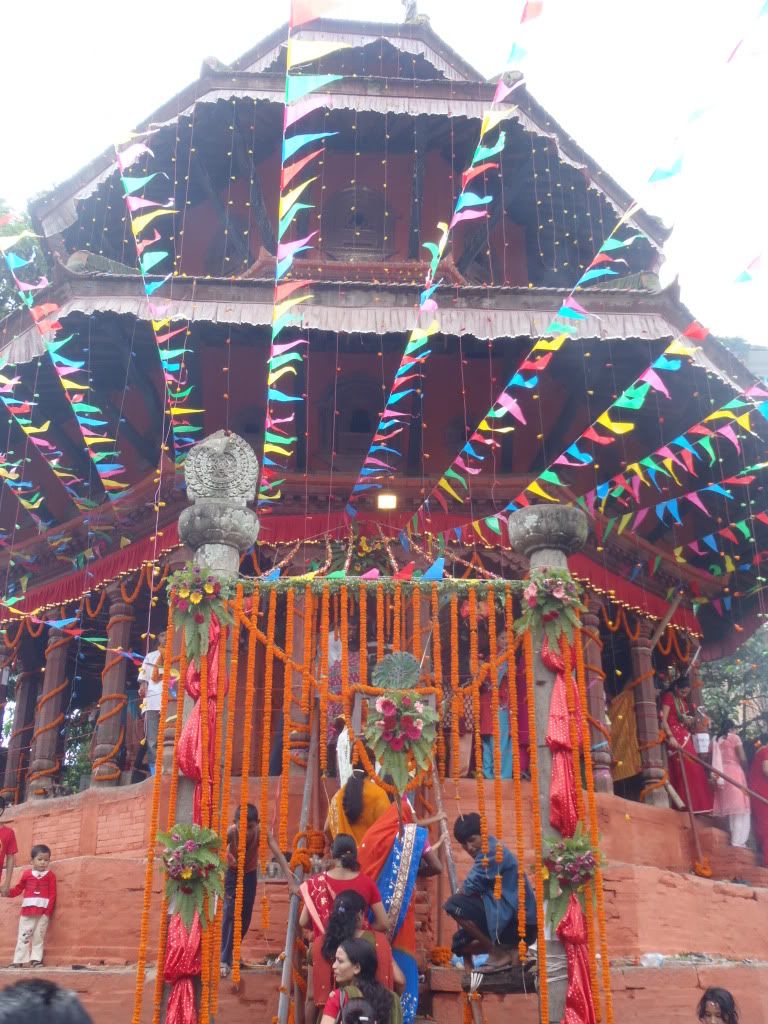
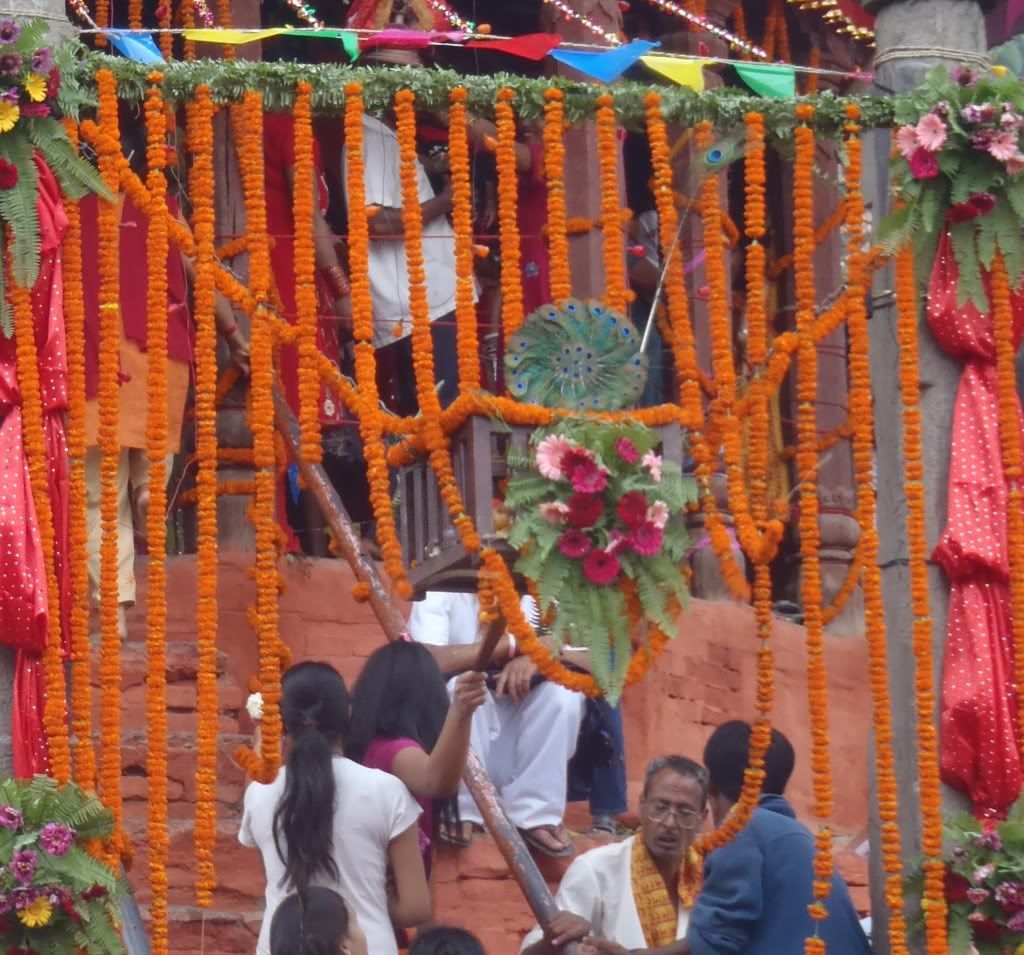
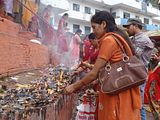
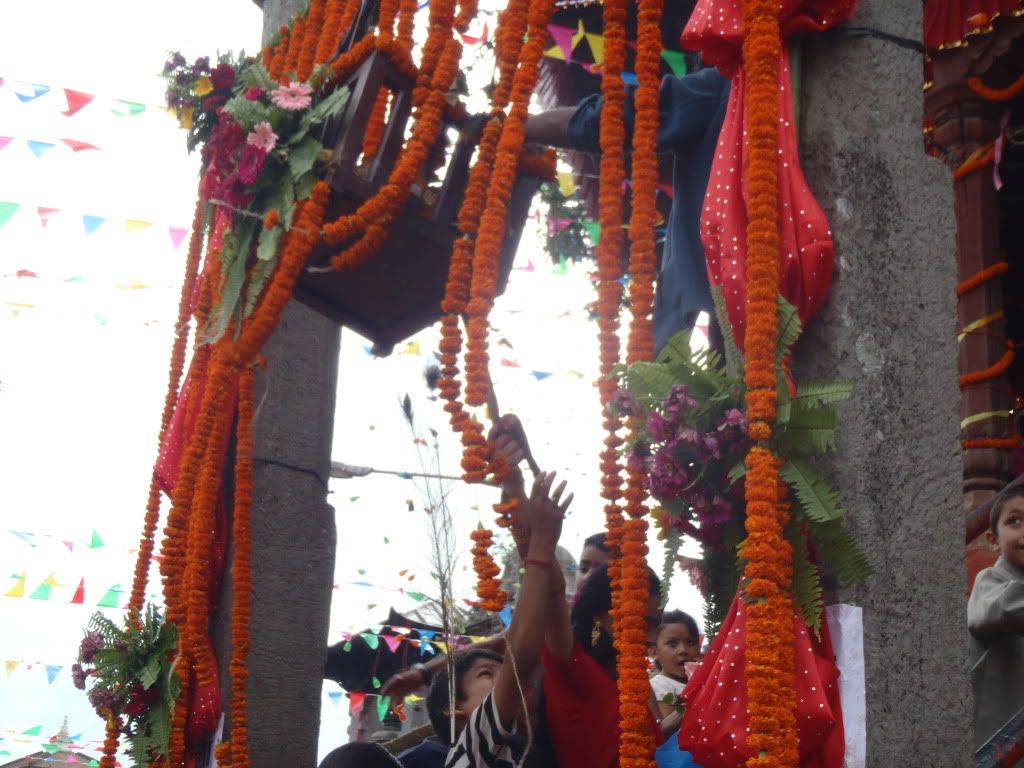

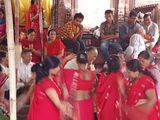
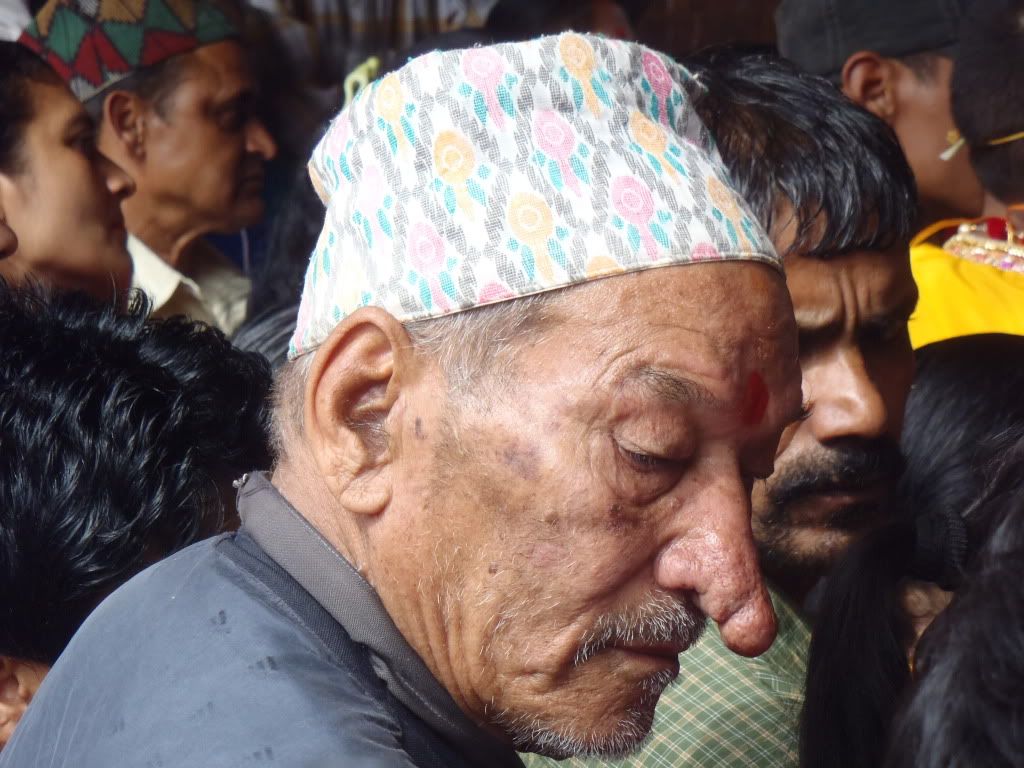
We then took a rickshaw from Durbar Square back towards our hotel before walking the rest of the way in search of a Tibetan flag. Not seeing anything we liked, we picked up some falafels (well, they are actually the chicken wraps) from the Or2k stand outside their restaurant and some groceries. Once we got back to our room we simply chilled out for the rest of the evening.
September 2nd was the day to explore the last of the 3 former city-states which competed for power back in the day: Patan. After another sumptuous breakfast that morning, we had a taxi drop us off in the heart of the city, and rather than get a guide, we decided to follow the Lonely Planet’s walking tour advice. Listed as a World Heritage Site, Patan’s entire make-up is of 16th century+ buildings that are jaw-dropping in their completeness. Much like Bhaktapur, this ancient city really gives visitors a glimpse back into Nepal’s glorious past and rich culture. Most of the Palace Complex monuments are located in Patan’s Durbar Square, having been built in the early 1600’s by King Siddhi Narsingh Malla. King Malla conquered the city, which had previously been ruled by local noblemen.
Henk and I decided to visit the popular Patan Museum first, and then after walking around the square, head out on our tour around the rest of the city. Well, the Patan Museum deserves its famed reputation for sure! It was extremely detailed in its description of various Hindu Gods and Goddesses, while at the same time clear in its explanations and informative. After going through this museum, I really feel like I have both a far better understanding of the pantheon of deities Hindus worship and the ability to look at a stone or bronze carving and actually understand what is going on without a guide or book! In fact, most of the motifs used in Hindu art are quite repetitive, so once you get the gist of the characters it isn’t too hard to recognize them once you see them again. Most characters have the same ‘position’ they are usually in (sitting a certain way or standing; fierce manifestations take active poses whereas peaceful manifestations hold meditative poses) plus the same objects in their hands or the same ‘vehicle’ (usually an animal companion they ride on) accompanying them. The way the figures’ hands are positioned is so important (since it conveys that deity’s particular emotions or personality) that it has a special name: mudra.
The stone slabs were the first items we saw, which had some ancient stone documents describing various dedications by rulers or donations by rich ancients. These have been in use, we read, since the 5th century in Nepal. One interesting example we saw was of a stone document inscription with a shivalinga, and a cow suckling her calf. This section wasn’t too interesting though, so we moved on to the Buddhist/Hindu deity section which informed us of the positions and descriptions I noted above. I’ll give an example of how to put such information to use when you look at a statue:
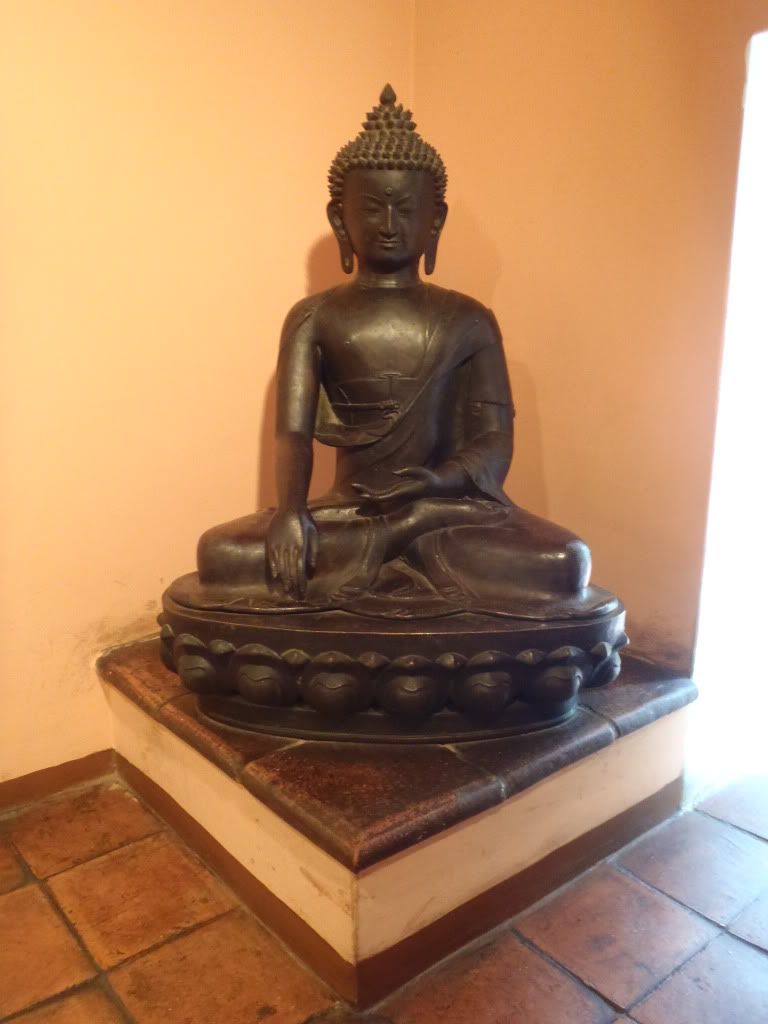
Above you see the image of the Buddha which you’ve probably seen a gazillion times if you’ve traveled through Asia. First look at the Buddha’s feet and legs. Are the legs crossed? Are the feet upturned towards the sky? This is known as the Diamond/Thunderbolt/Lotus position. If Buddha’s legs had been folded, but not crossed, he would be in the ‘noble attitude’ position instead. More importantly, now look at the Buddha’s hands. Here, Buddha has his right hand hanging down while his left is palm upward in front of him. This particular gesture signifies that Buddha is “calling the earth” to witness his persistence in continuing to meditate despite disruptions by a Mara demon. If, for example, his hands had instead been forming a circular motion while being intertwined, this would be a sign that in this image Buddha would have been teaching or calling upon the Wheel of Law.
The next deities we looked at were various avatar (incarnations representing aspects/traits of popular deities) pairings done by 12th century stone sculptures. The first was “Uma-Mahesvara.” Mahesvara is an avatar of the Hindu deity Shiva and Uma is an avatar of Parvati, Shiva’s wife or female form. The pair is famed for living on Mount Kailash back in Tibet, which is why Hindus as well as Buddhist consider the mountain sacred. Mahesvara, being more important than Uma, is depicted as larger than her in size. We also see Shiva’s vehicle, the bull Nandi, to Mahesvara’s right hand side. Further to the right of Nandi we see one of Shiva’s two sons, Kumara, holding a lance. Also in the sculpture is Shiva’s other son, the elephant-headed Ganesha. A side-note to this particular sculpture told us that it was stolen from the town Dhulikhel near Kathmandu and ended up in a German museum before eventually makings its way back to Nepal after its stolen image was published. It is absolutely insane to me how those in the “business” of historical treasures can simply disregard all sense of duty to future generations by moving around sacred and ancient objects as if they were simply chess pieces to be played with. How much potential knowledge we have lost due to them must be staggering… I can’t even think about the consequences, but they are no better than China’s former Red Guard in their actions.
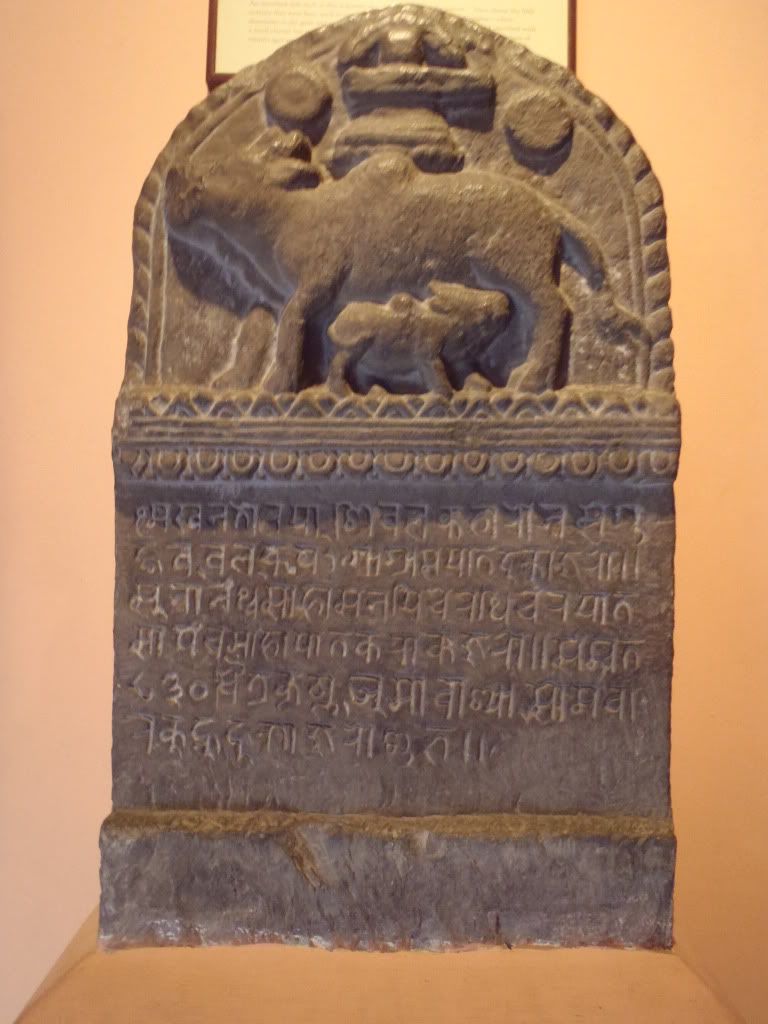
I’ve already given an example of how the divine Shiva can have multiple forms – in his female version of Parvati and in his Mount Kailash-dwelling Mahesvara – but it is not just Shiva who can have avatars. Stepping back to understand some of the general aspects of Hindu deities’, the museum gave a great overview in the next room, which I’ll quote here:
“Hindu deities have numerous manifestations; the same deity can be benign in one aspect and fierce in another. They are frequently portrayed with multiple heads and limbs. [Francesca Note: This is common in ‘Tantric Buddhist’ art.] This distinguishes them as superhuman and permits them to hold a variety of emblems that define their personality and assist in their identification. With multiple hands the gods can hold multiple weapons. All are needed to combat malevolent forces in engagements that bear cosmic consequences.”

Nepali, while worshipping the entire pantheon of Hindu gods/goddesses, have a special fondness for Shiva – even referring to their beliefs as the “Way of Shiva” or “Shivamarga.” Because of this, I’ll choose Shiva as the deity to focus on for the next example. As explained by the museum quote, various deities in Hinduism hold objects to explain their personality. For Shiva, he may hold the trident, the crescent moon, the seed rosary, the double-headed drum, and the hand-held water pot. Shiva’s trident has three spikes representing the three aspects of the divine as creator, preserver, and destroyer. Furthermore the trident is a weapon against evil. The crescent moon represents Shiva’s peaceful side, since it is often a symbol of a yogi. Both the seed rosary and the hand-held water pot are also yogi symbols, with the water pot representing the sacred waters of India’s Ganges River or Nepal’s Bagmati River. The last symbol is Shiva’s double-headed drum. I find Shiva’s drum the most interesting of all his objects because it represents the ‘fundamental creative force.’ Since the drum is ‘double-headed,’ it also serves as a symbolic representation of male and female principles.
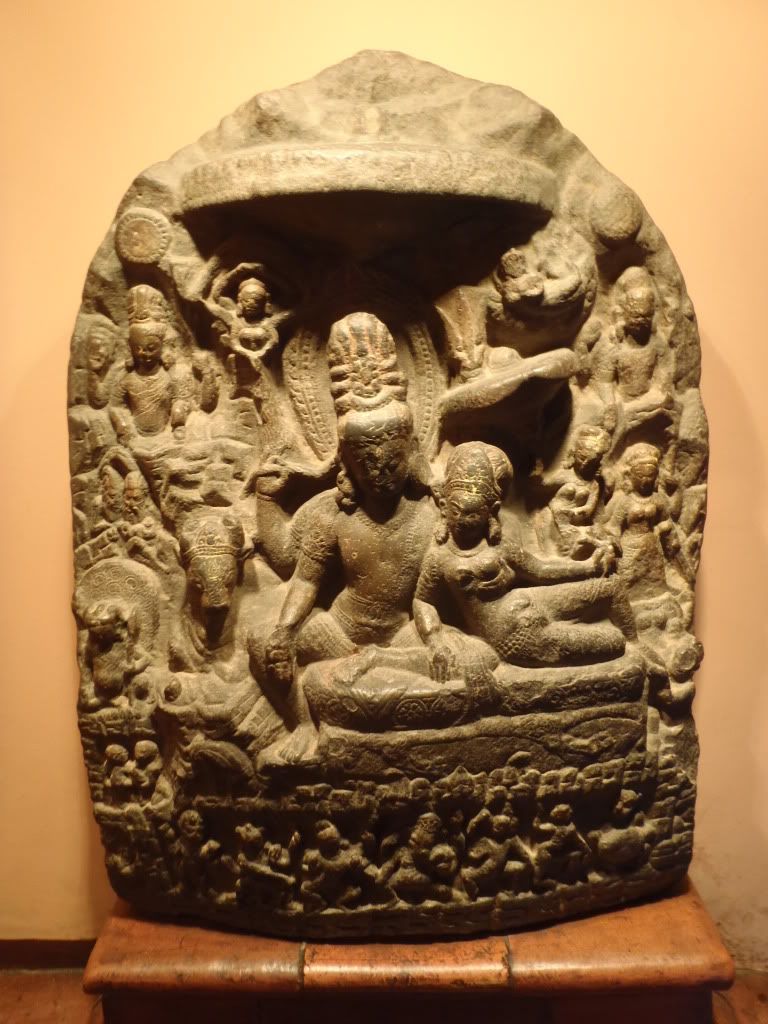
Next we came across a four-faced Shivalinga, which is specifically popular to Nepal. A relatively new object (17th to 18th century) the Shivalinga actually has five faces since there is a ‘hidden fifth’ face on the top of the linga. The four visible faces are each aspects of Shiva’s personality. In our picture you can see two faces—to the right is Bhairava, a wrathful avatar of Shiva, distinguishable by his curly head of hair. On the left is Nandi, which is not only Shiva’s vehicle but an aspect of Shiva himself as well. The other two faces are hidden from view.
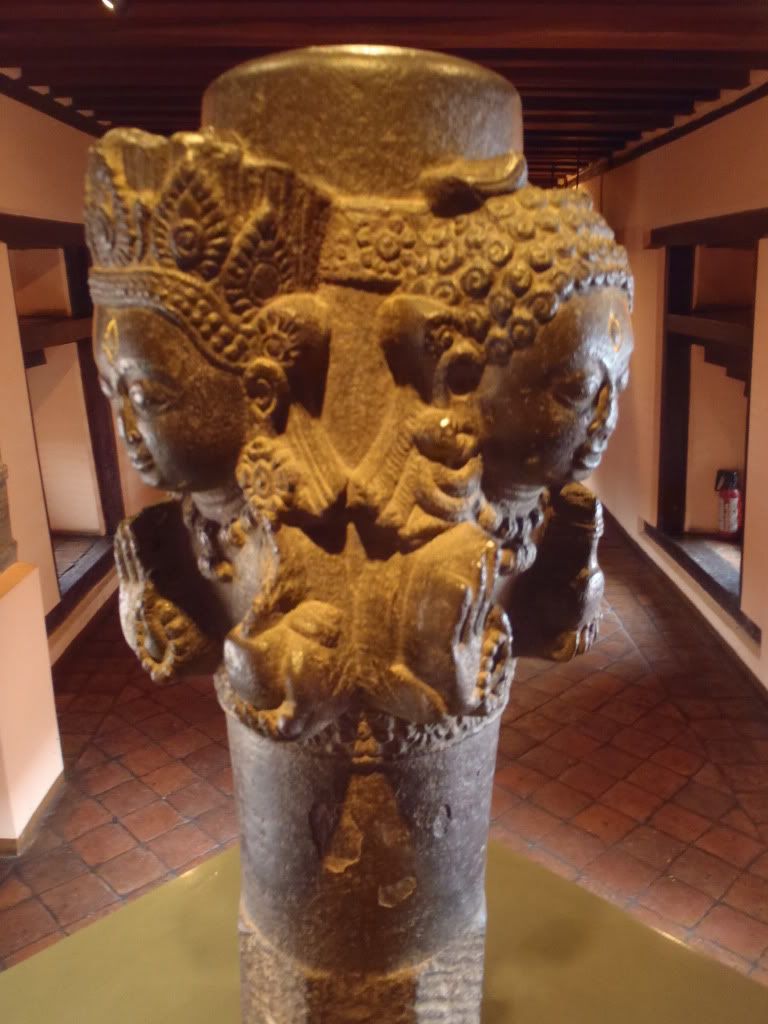
We moved through the next sections slow and steady, as there was a lot to read and take in. I’ll just give a brief overview of the more interesting characters/images we encountered.
Ganesha (Shiva and Parvati’s son) is one of the most recognizable Hindu deities since he has the head of an elephant. He is the remover of obstacles, and often holds a radish which was, as the museum sign told us, “an alternate for the broken tusk he once hurled at the mocking moon.” (The moon was mocking Ganesha’s heavy weight.) In the plaque I selected to show below, Ganesha has six arms and six heads and has dancing bells on his legs similar, as the description read, to male Nepalese dancers. His vehicle, humorously, is a small rat which you can see here holding a laddu ball (sweet treat that represents wisdom) for Ganesha.
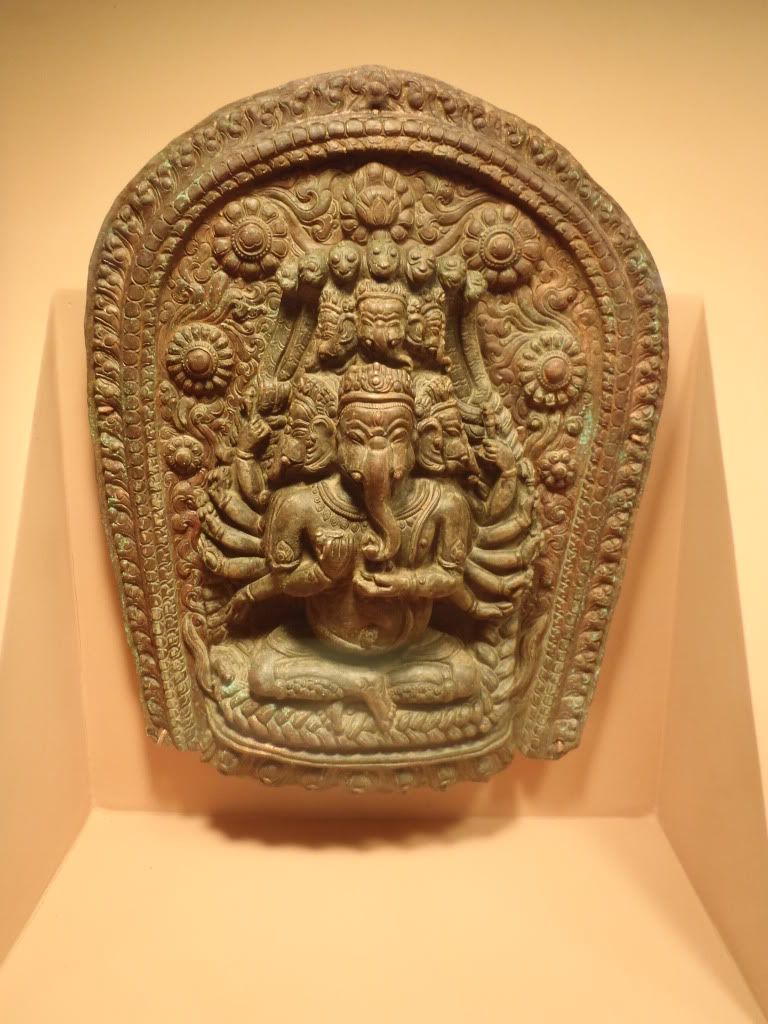
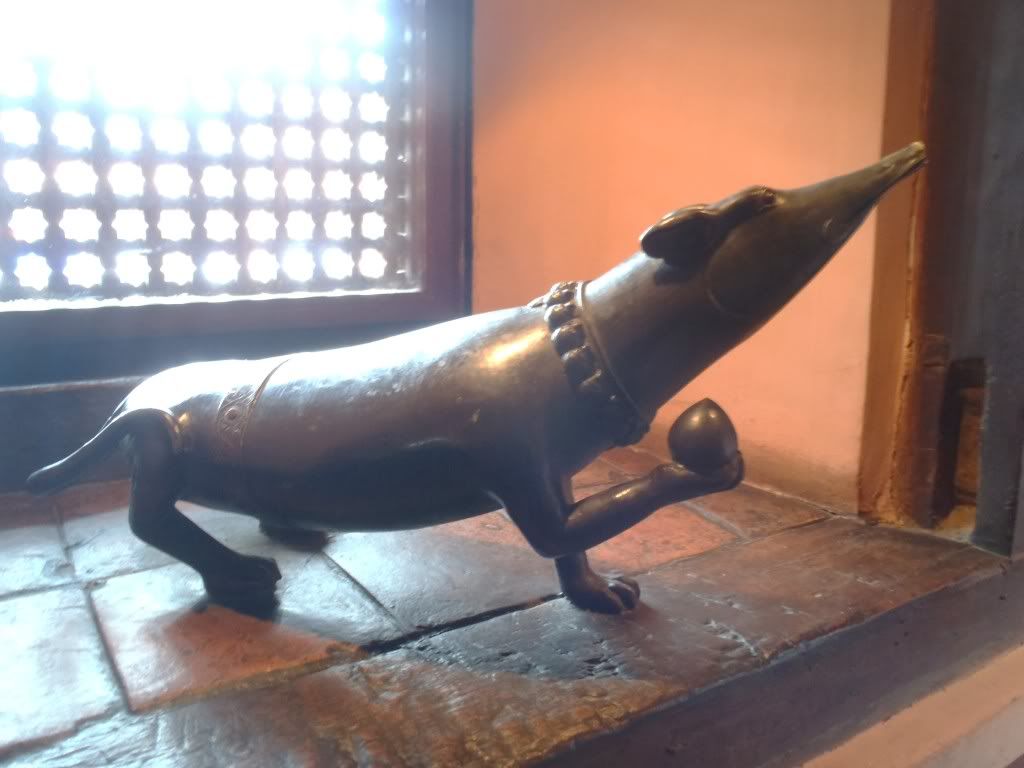
Vishnu is one of the main representations of the three divine aspects, along with Shiva and Brahma. While Shiva is the Creator, Vishnu is the Preserver of all things. His mount is Garuda, a ‘bird-man,’ and his symbolic objects are a powerful yet destructive royal mace, a lotus/ball, a discus representing both a royal weapon and the sun, and a conch shell representing both a royal battle trumpet and water. Here is a popular example of a stone carving with Vishnu and his objects, along with (on his left-hand side) the human form of Garuda (notice the wings sprouting from Garuda’s back draped around him) and (on his right-hand side) one of his wives, Lakshmi. Vishnu is also uniquely seen in Nepal as half Vishnu (right side) /half Lakshmi (left side) in statues. Here you can see their bodies are meshed together – half male dress, half female dress. Each unique male/female side also holds all of its specific objects with its many arms.
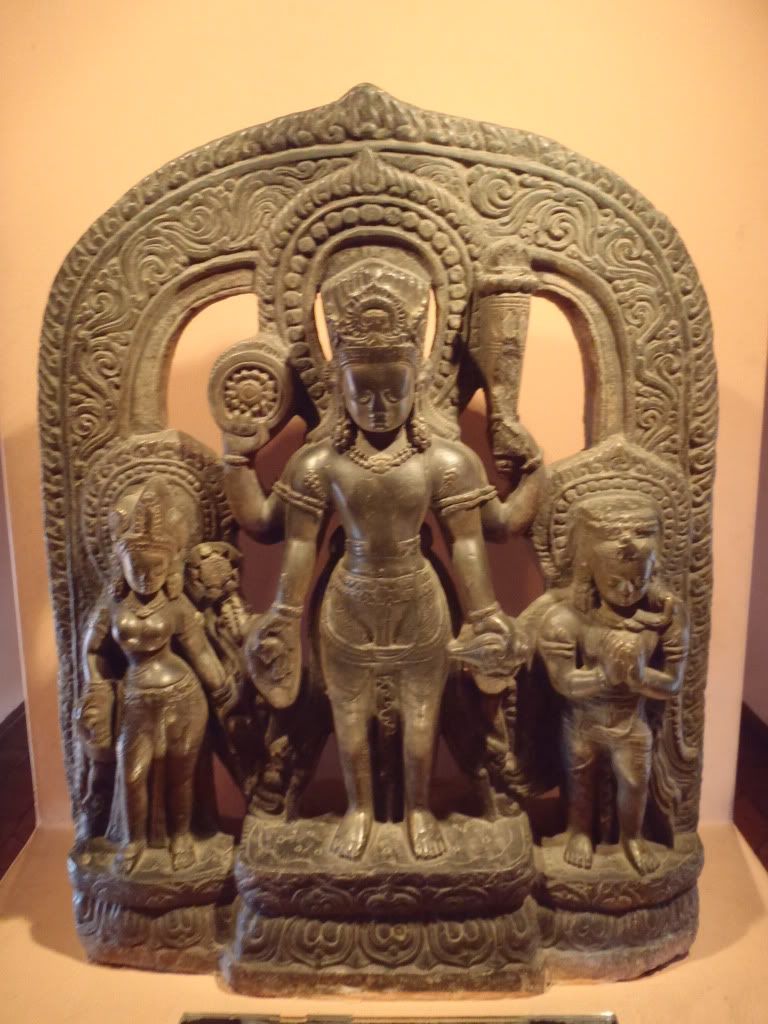
There was a brief break in the Hindu deities for a few Patan-centric artifacts. There were some ivory pieces, but most importantly the royal throne of Patan Kings for over a hundred years of their reigns. The sign nearby explained to us that all Kings of Nepal were considered to be incarnations of Vishnu. This being the case, the throne “creates the illusion” of Vishnu seated on his vehicle Garuda when the King (as Vishnu) sits on it. An inscription on the bottom of the throne reads: “May it be good. On Thursday, the eighth of the waxing moon of the lunar month Shravana, Nepal Era 787 [about August 8th, 1966] His Majesty King Shrinivasa Malla was offered an alms bowl and a golden throne attached with kadamba trees. Anybody can hire this throne on payment of two rupees to the families of coppersmith and carpenter. Let it be auspicious.”
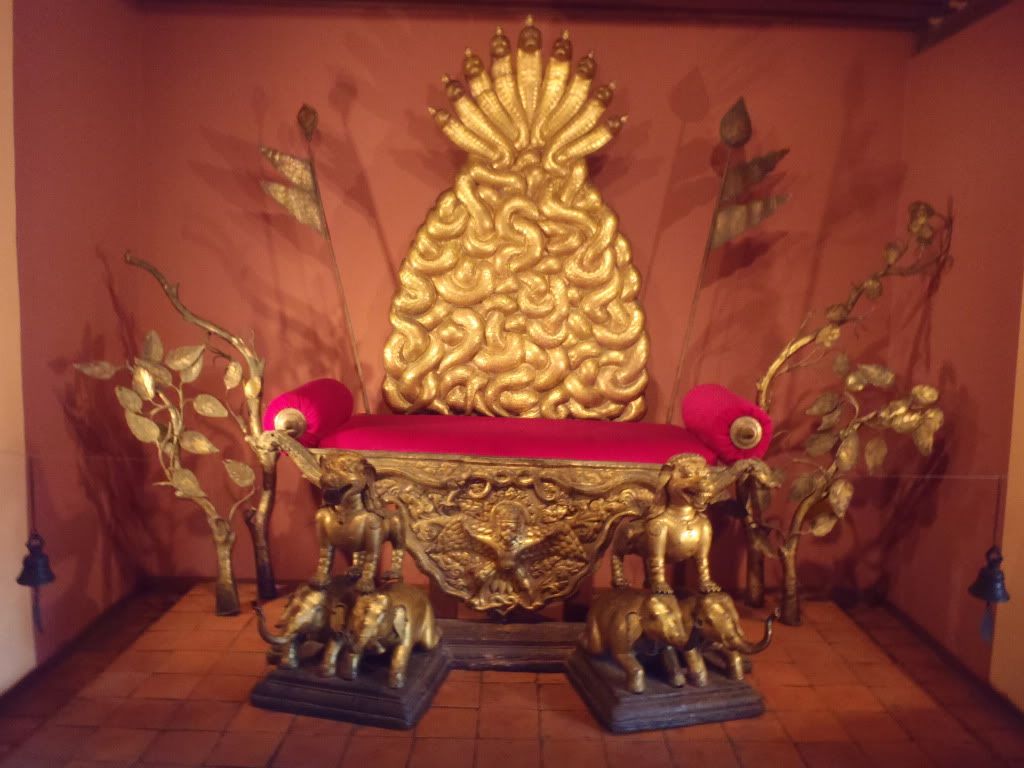
Returning back to Hindu deities, Henk and I saw an interesting description associating the Vedic Gods with forces of nature. Indra is the god of rain, (and he is celebrated during the Indra Festival we will attend later at the end of the monsoon season in Kathmandu) Surya represents the sun, Chandra is the moon, and Agri represents fire. Below is a plaque of the sun god Surya. He is in the center holding two lotus flowers. On his right is the scribe Pingala and on his left is the staff bearer Dandi. Each of these so-called “nature gods” becomes more important during festivals that represent them throughout the year. There are also representations of the planets which are believed to control human lives.
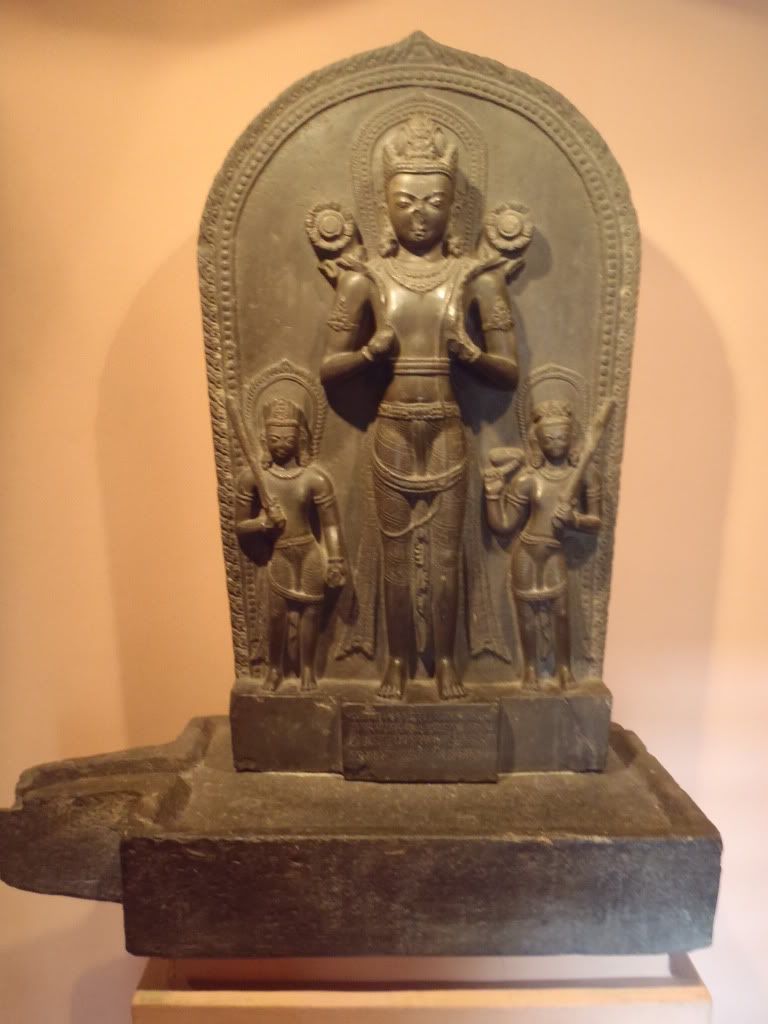
Another interesting combination deity distinctly Nepali is that of Hanuman (Vishnu’s monkey god) plus Bhairava (Shiva’s avatar) – you can see in statues of this image that the Hanuman image is dominant but there are also four additional animal heads (boar, Garuda, tiger, horse.) The multiple heads and multiple arms on this esoteric Hanuman-mixed deity are quite common in Tantric Hindu belief. The Tantric doctrines give a method of ‘release’ from the cycle of rebirth in a single lifetime, if their practices are followed correctly. The methodology holds that it is only through the union of male and female energies that true ‘release’ from rebirth can be achieved. The male element is passive while the female element is active (representing power) and the male can only tap into that power via union with the female. We viewed an ancient esoteric manuscript (painting) which was formerly used by tantric practitioners in their studies, as well as some Buddhist tantric ‘union’ statues showing male-female sexual union.
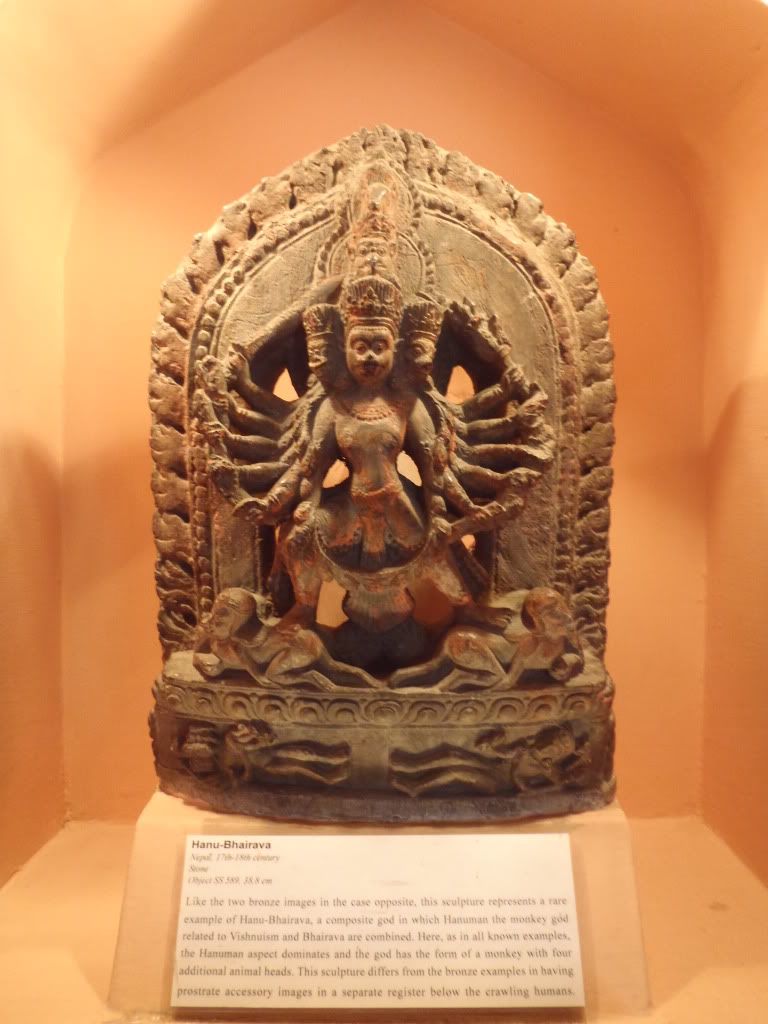
The next section of the museum told us about Buddhism in Nepal, and the different ‘characters’ – such as Tara and the Indian Buddhist master who brought the knowledge to Tibet. Since our time in Tibet gave us much of that information already (which we’ve already discussed) we won’t go into that again here. I’ll just give you a little information about Buddhism that is specific to Nepal. For example, in Nepal there aren’t nearly as many monastic schools as in Tibet; most monks are part-timers and thus don’t need the space to study together. Additionally, in Nepal, it is believed that the ‘future Buddha’ or Maitreya is already present on earth and has just not been ‘found’ yet. Also popular with Nepalese Buddhist is the Dipankara, the Buddha of fixed light (protector of merchants), who they believe pre-dates the historical Buddha. Basically Dipankara is to Shakyamuni what John the Baptist was to Jesus – he pre-dated him, resembled him in action, and foretold the latter’s coming.
Henk and I crossed into the next set of galleries which explored a few mystery statues found in Nepal (but origin and deity unknown) as well as the process of metallurgy in Nepal. We saw step-by-step examples of Kathmandu Valley crafted metal figures. We learned that in Patan Newari people made their metalwork in their home – no matter if the object was for personal use or export. There was a famous ‘lost wax’ technique where, as we learned from the signboards posted, “… a wax model is encased in clay then melted out to be replaced by molten metal.” Another technique used was that of relief/embossing (hammer metal sheets to obtain designs), which is still popular in Patan.
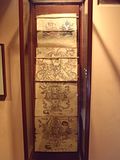

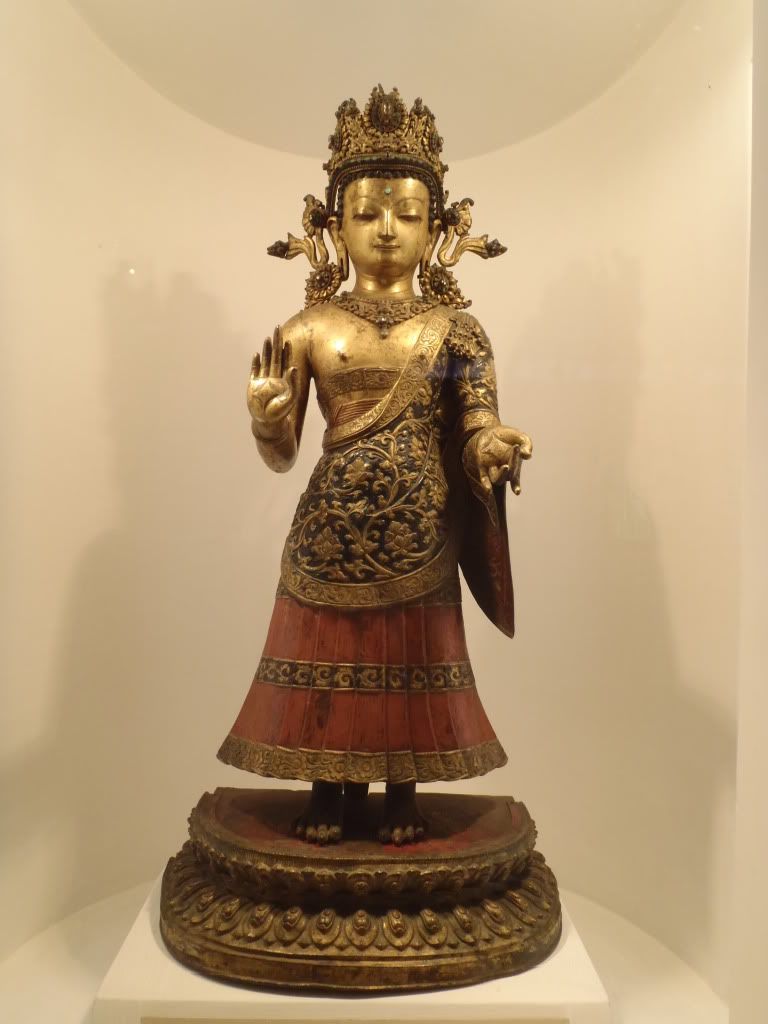
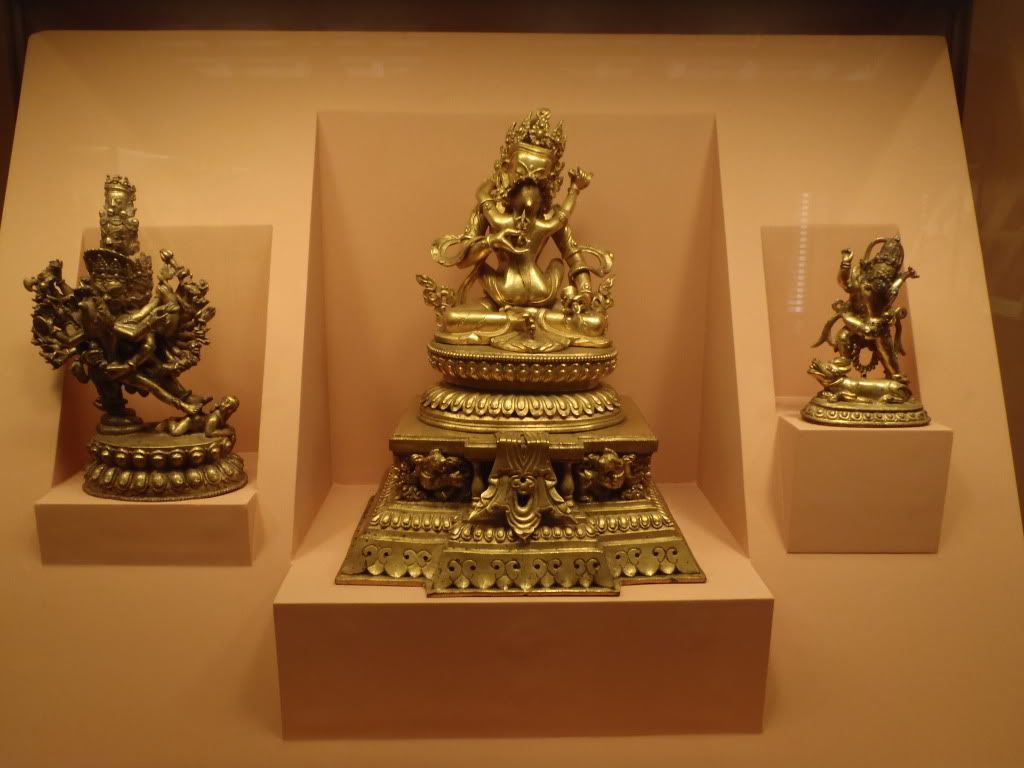
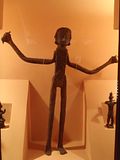
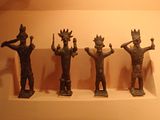
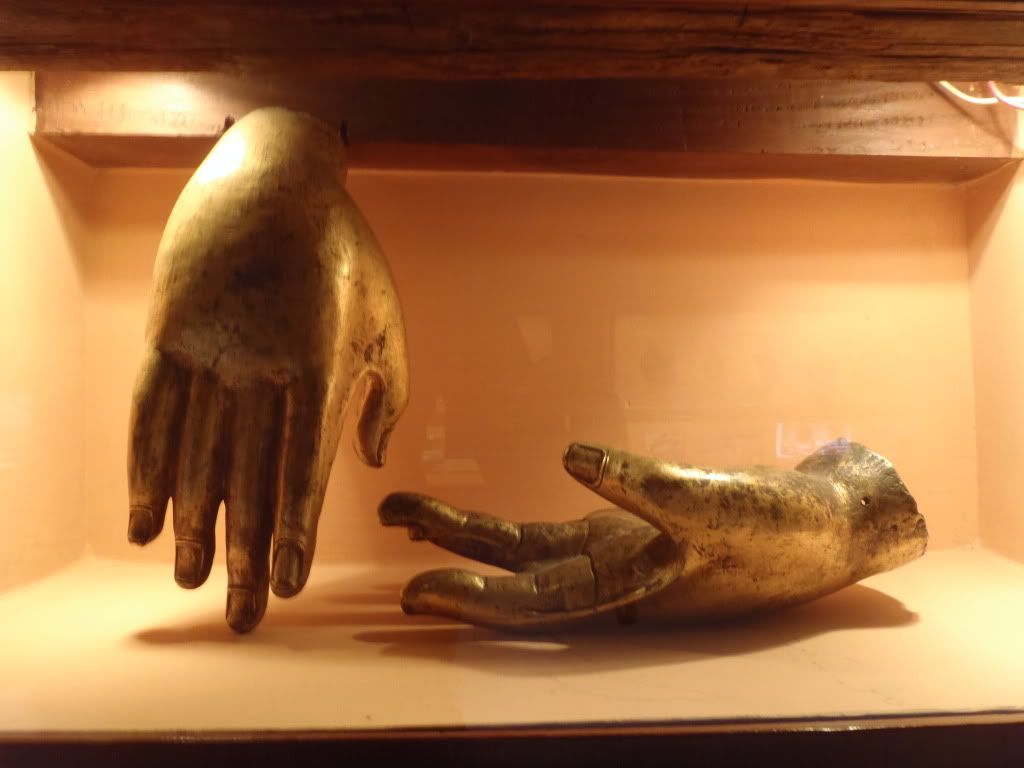
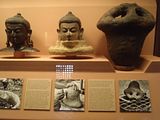
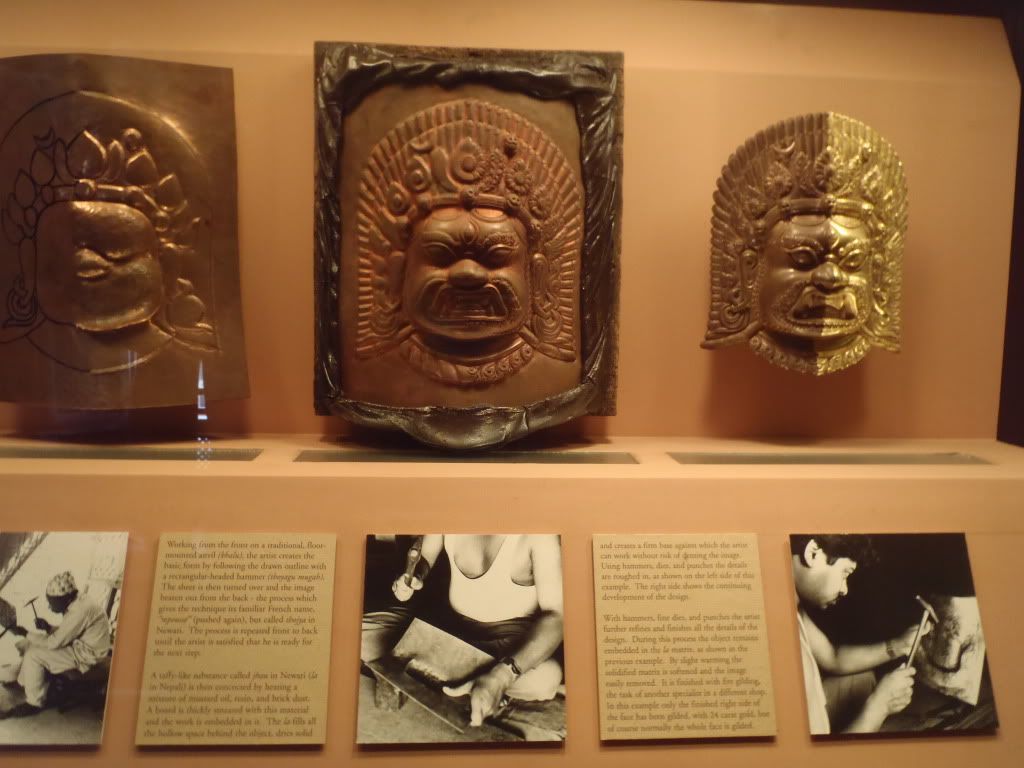
Finally we went into the ‘former Nepal’ area of the museum where we encountered tons of black and white photos of what certain towns in Nepal used to look like. Thankfully due to preservation, reconstruction, and lack of intense war, it is very much the same as what we see today! Here were a few of the more striking photos, including a photo of the first CAR in Nepal (before there were even any streets) being carried over a river by Nepali men:
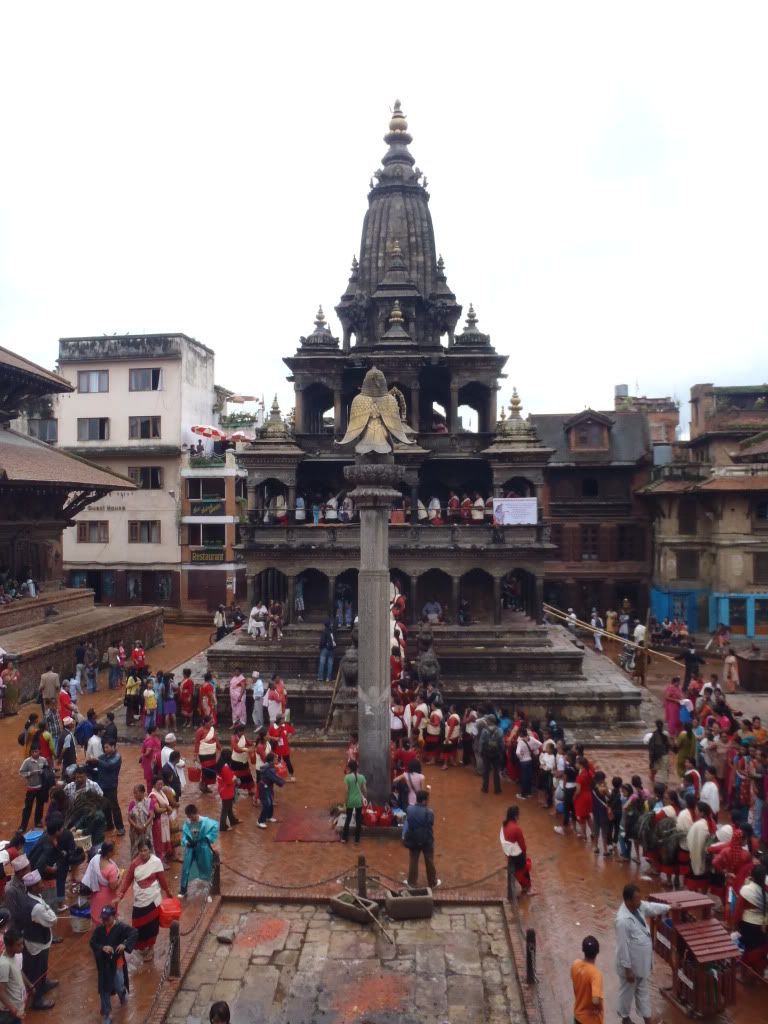
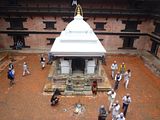
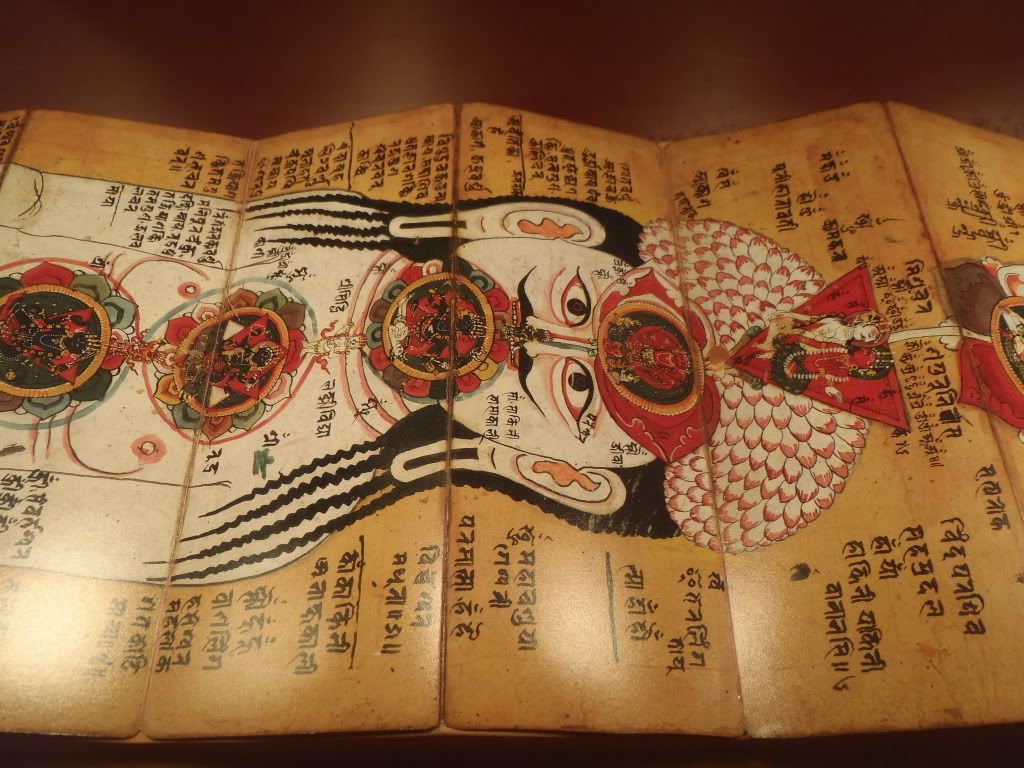
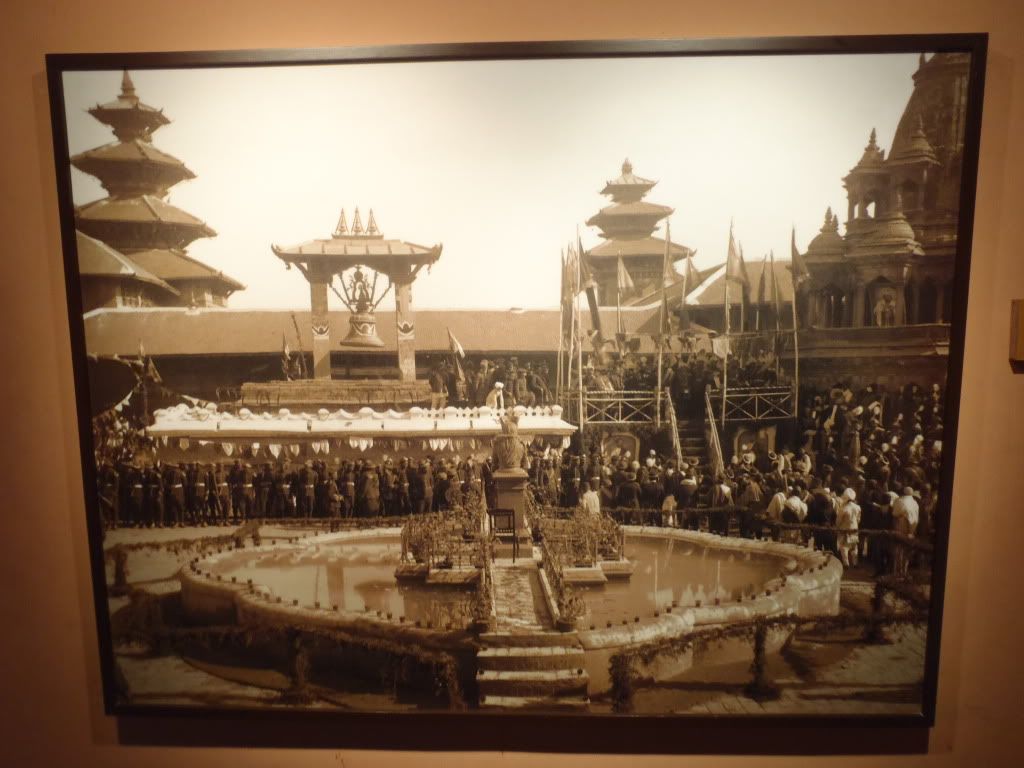
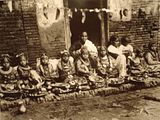
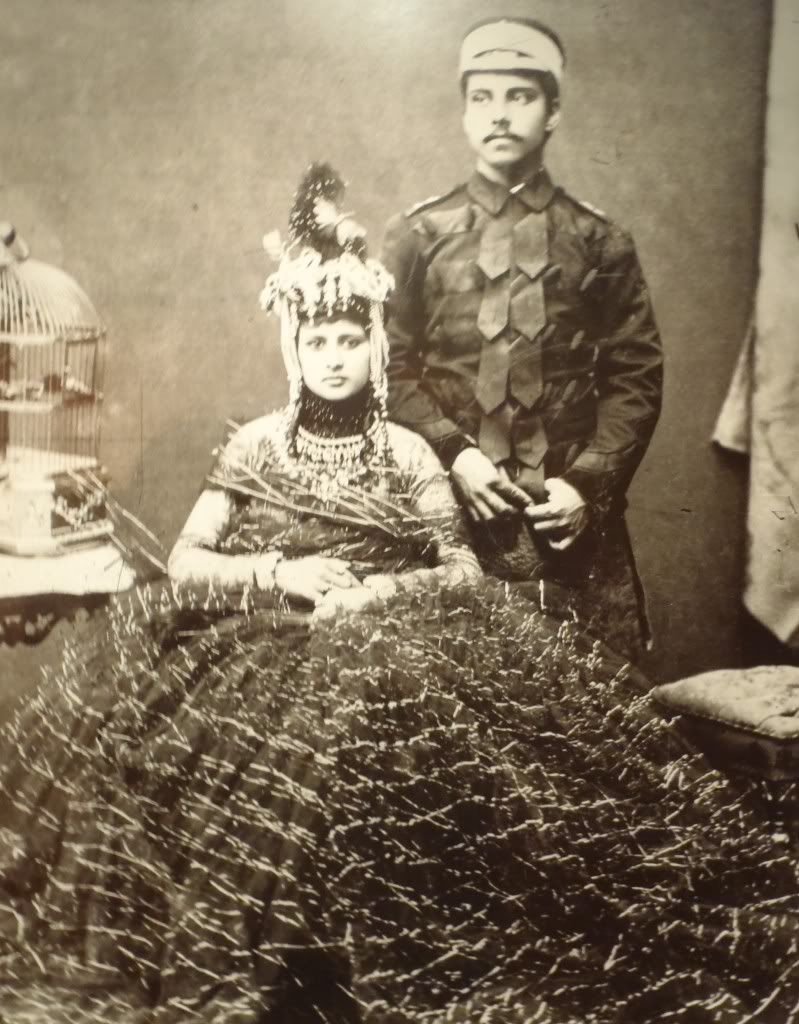
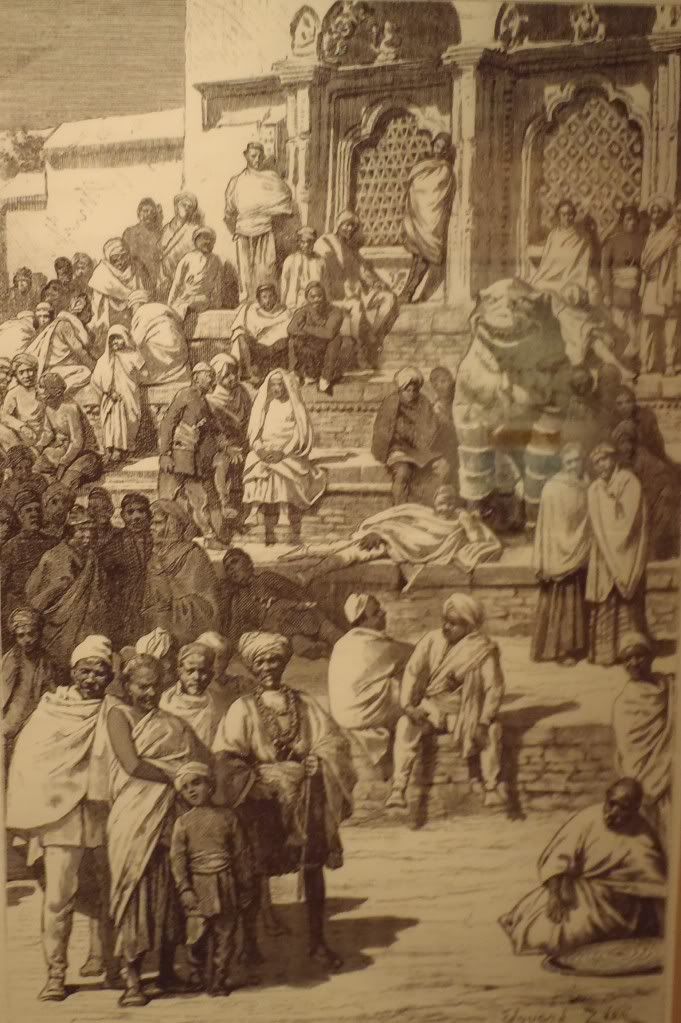
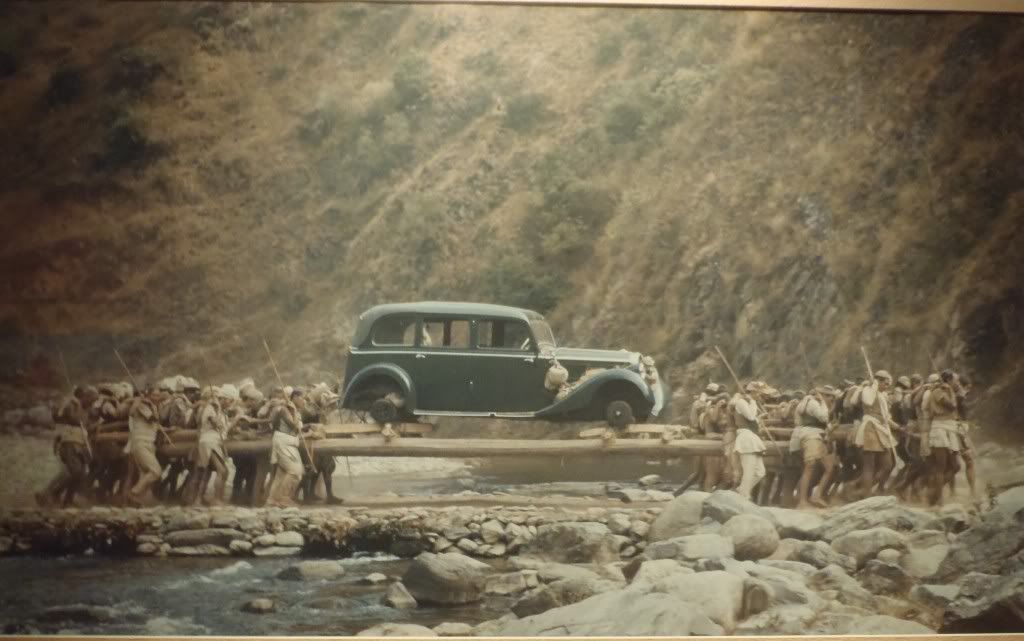
Once we finished with the museum, I remembered there was a little section at the beginning we hadn’t seen yet. It was just examples of decorative wooden window and roof carvings, which we’d seen all over the ancient buildings still standing in the Kathmandu Valley. We took a couple pictures before checking out the cafe in the back garden. Pretty, but overpriced, we decided to go out into the Durbar Square of Patan. Entering the square, we noticed many women dressed up in colorful red saris, carrying offerings in baskets with them. We realized that Patan was also celebrating Krishna’s birthday, and the women and men were lining up to leave the deity some honorary gifts, such as peacock feathers. The first place we went into was Sundari Chowk, an area that had a water tank in the center. The tank, known as Tusha Hiti, was beautifully carved with Hindu images and, while we couldn’t go any further than the tank itself, was worth a look. There were even small dollhouse-like replicas of temples on the edge of the water tank! Right across from the tank was a tiered octagonal Krishna Temple with banners hanging on it for the day’s festival.

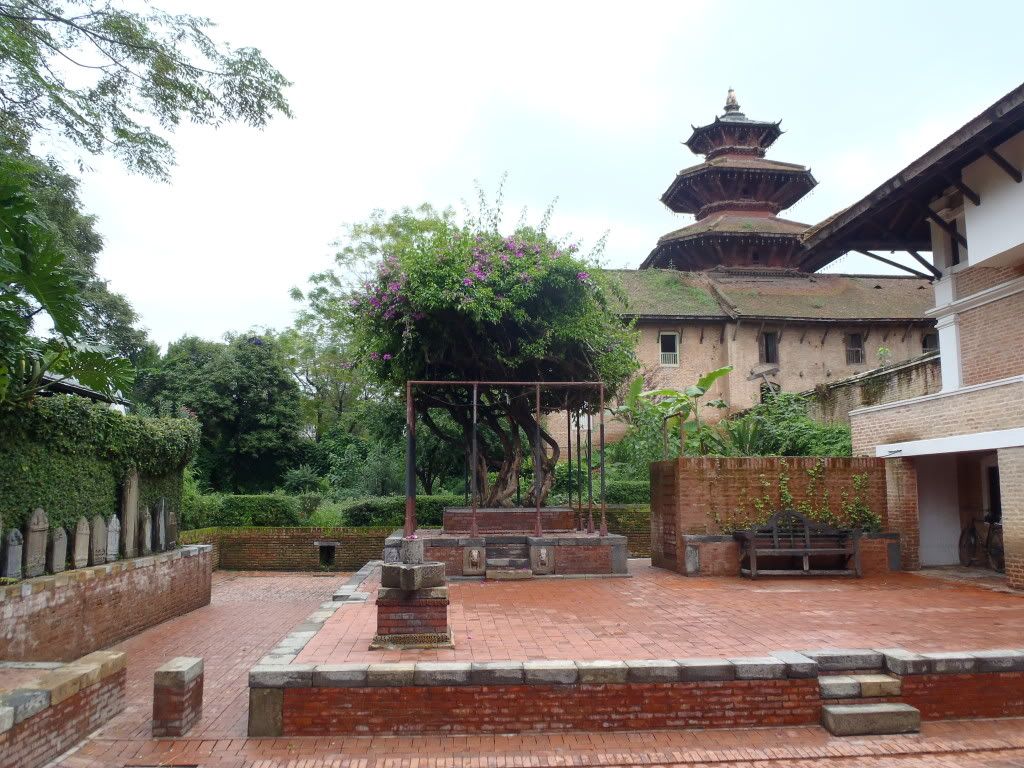
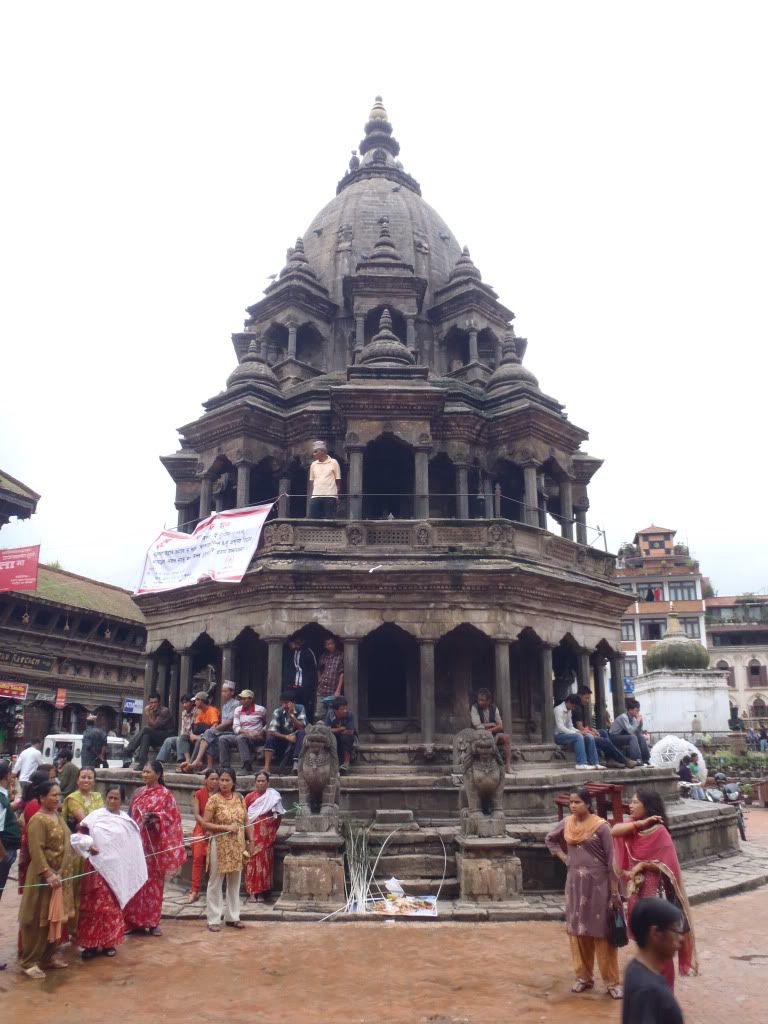
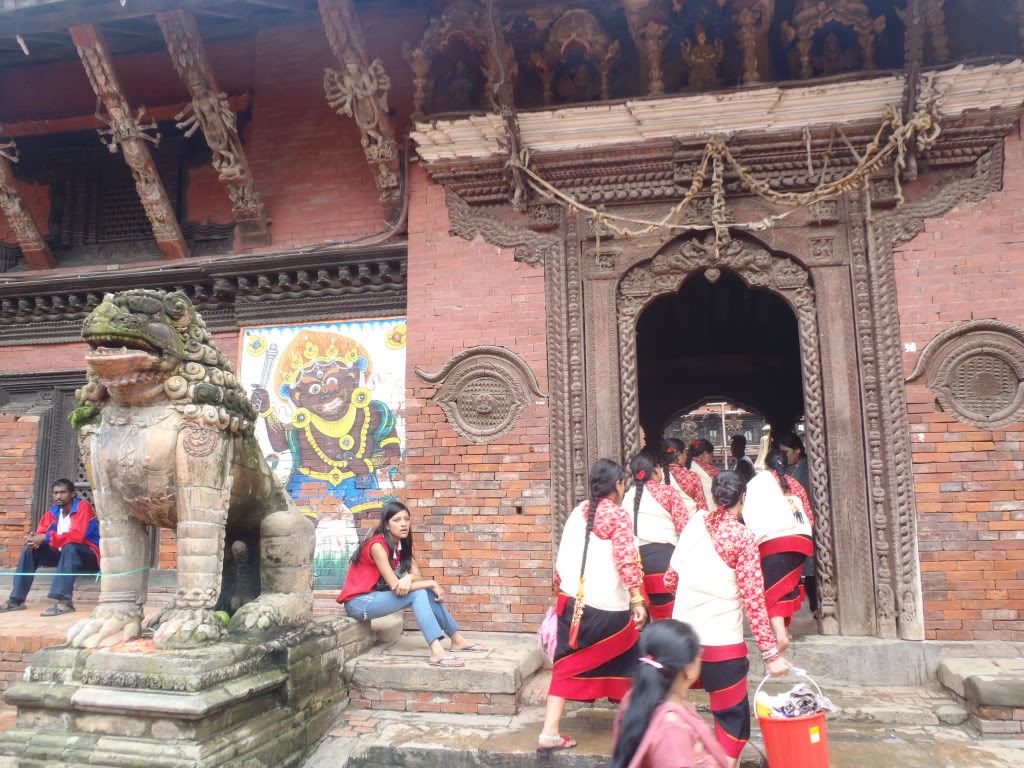
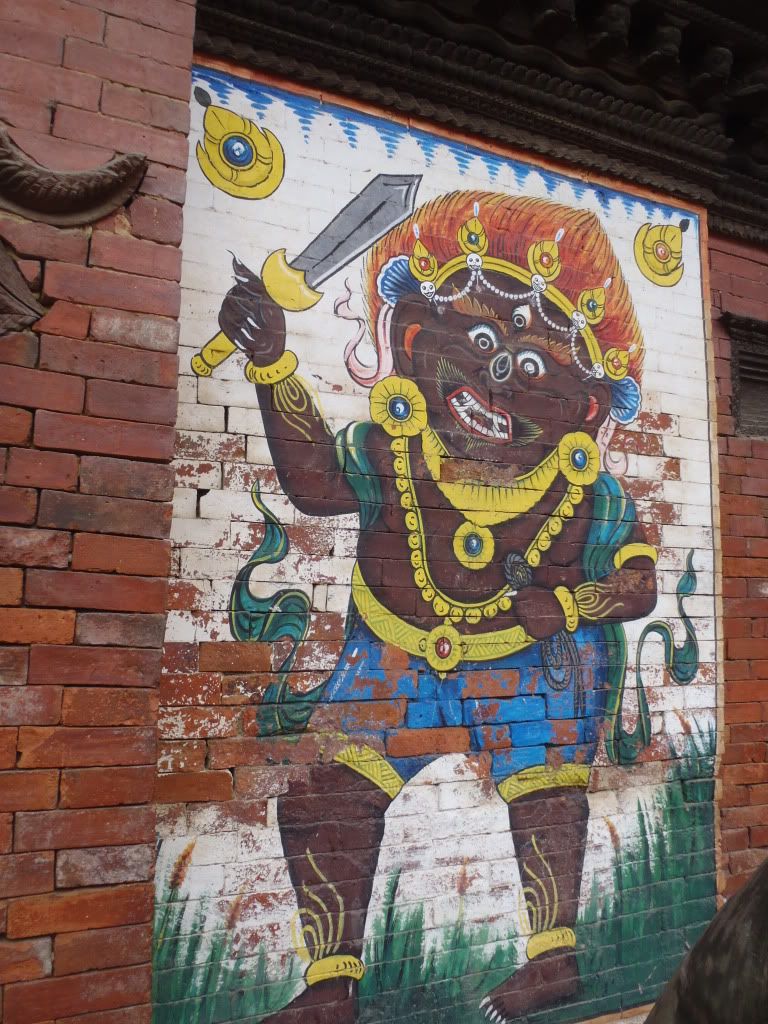

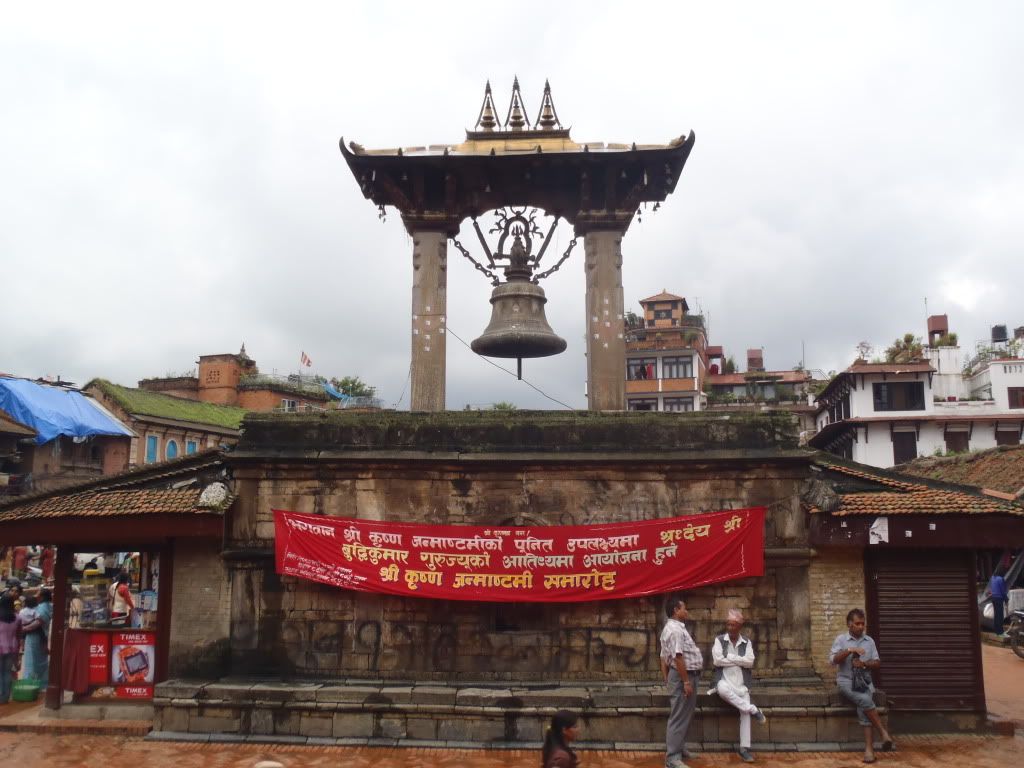
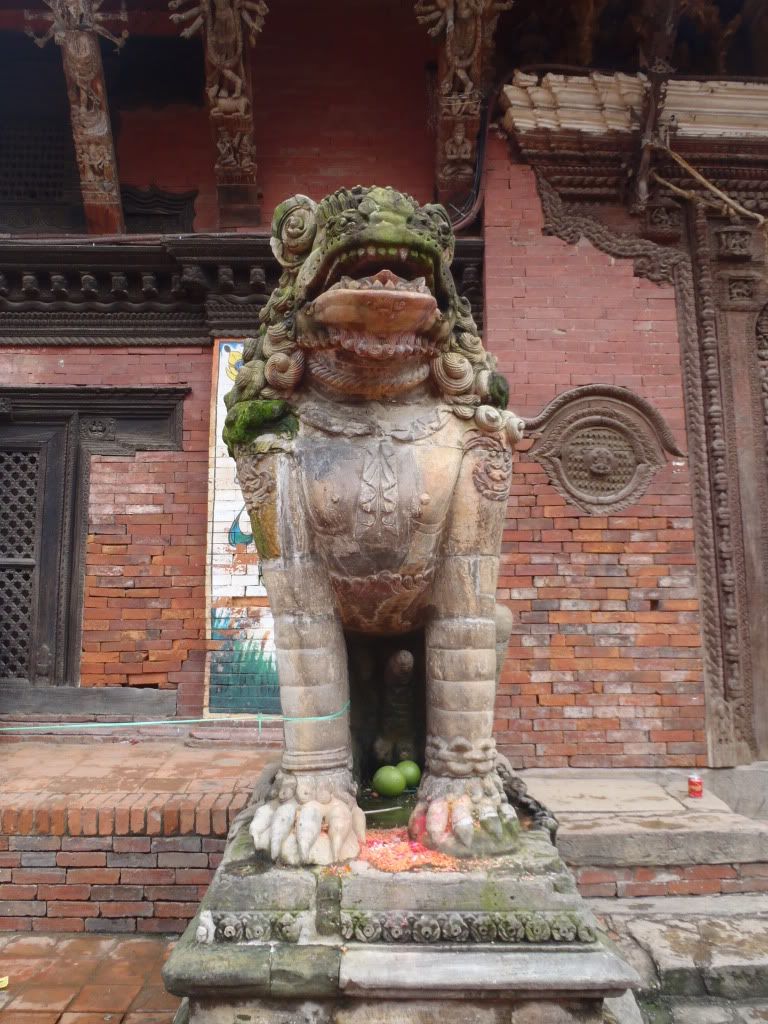
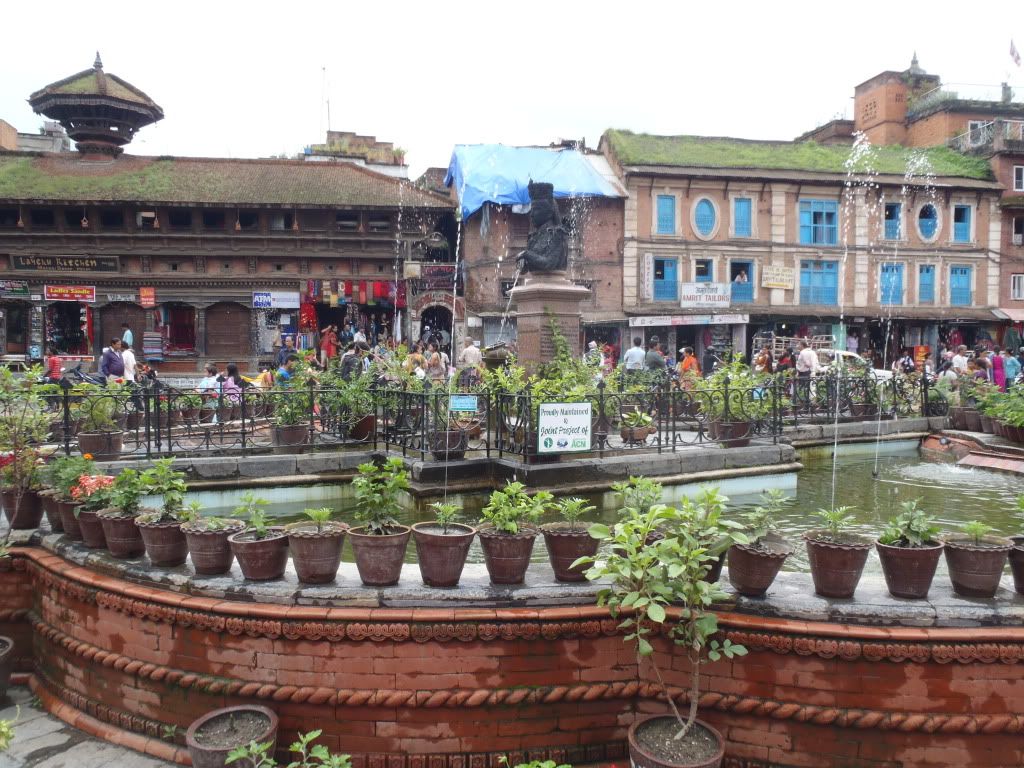
The next major temple of note was the impressive multi-tiered Hari Shankar Temple built in the 1700’s by the King’s daughter in honor of a hybrid Shiva-Vishnu deity. This temple looked similar to many others we’d seen by now, but we noticed the detailed ‘hell-torture’ carvings on it. Nearby was the mandatory tall statue of King Malla himself and further down the square was the large building containing the Patan Museum which had a doorway framed by a golden gate known as the Sun Dhoka. There was one main window on the top floor covered in gold foil. A similar looking window in Kathmandu has the Kumari (living goddess) appearing from it, but Patan’s window sometimes had appearances from the King himself. Another small temple we encountered was the brick Vishnu-dedicated Jagannarayan Temple which was covered on top in the same green mold we had seen on other structures in the square. Except this one had stone lions guarding it! Plus this temple is in honor of Vishnu’s incarnation Narayan, who was the creator of the universe and is probably the oldest in Patan’s Durbar Square. Finally we made our way past the Krishna Mandir, where the worshippers were also honoring Krishna on his birthday. It was almost 2:30 PM at this point and Henk and I were getting hungry for something to snack on. Plus it looked quite overcast (it IS still the monsoon season after all) and was starting to sprinkle on us, so we wanted to head for cover. After a couple sandwiches at the rooftop restaurant Cafe Du Temple, vegetable for Henk and a grilled chicken for me, we headed for our walking tour around Patan.
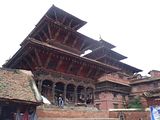
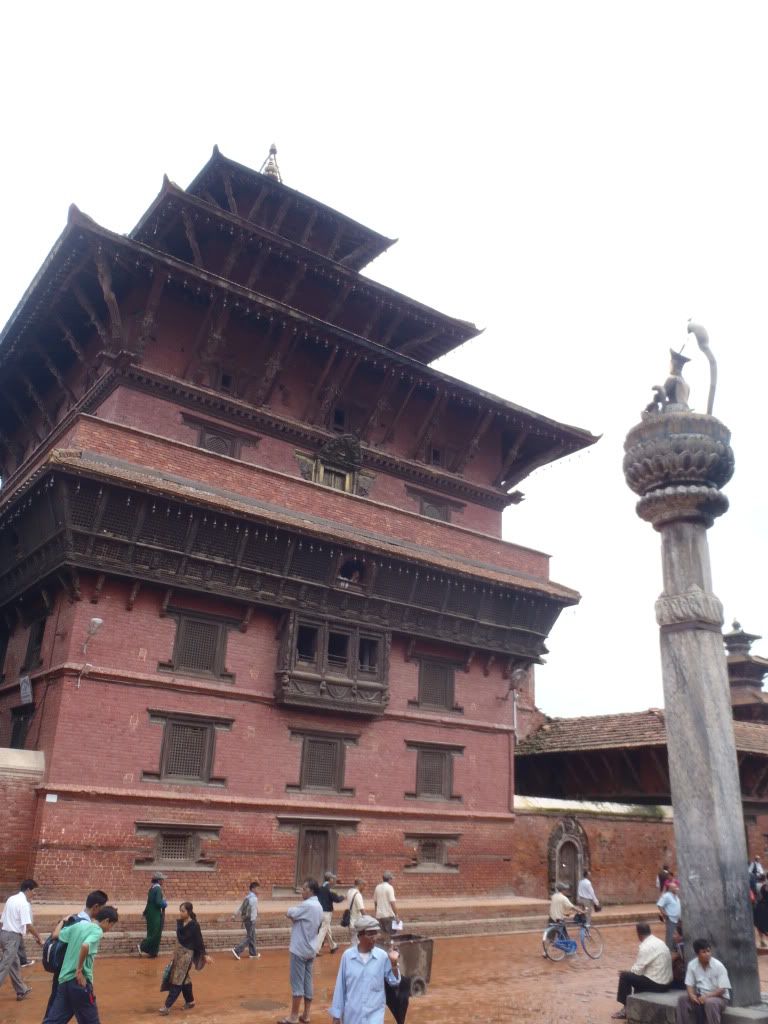
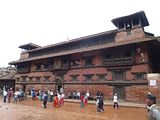
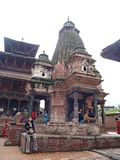

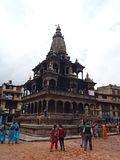
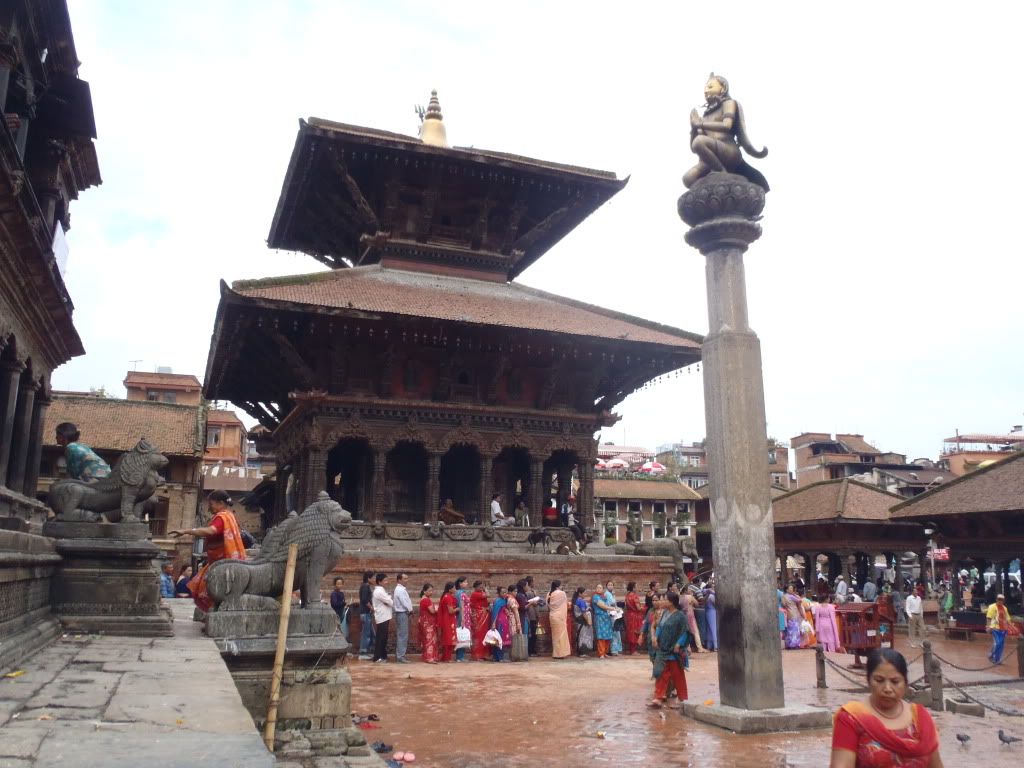

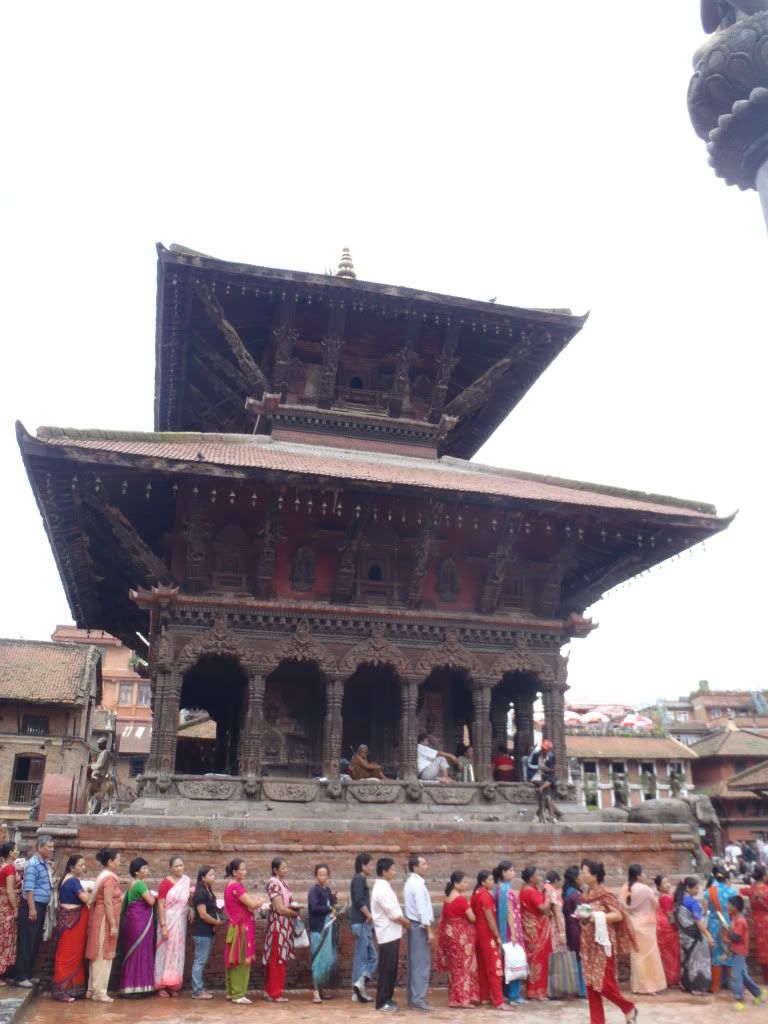
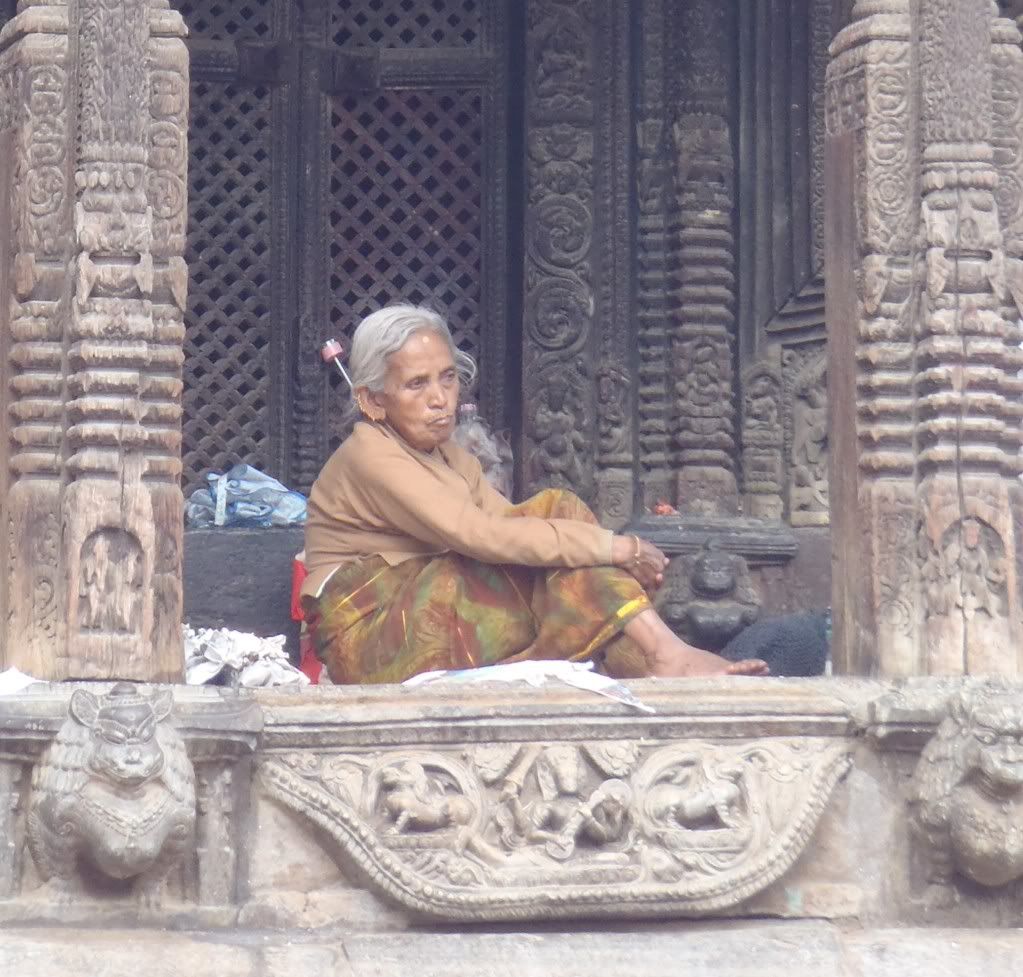
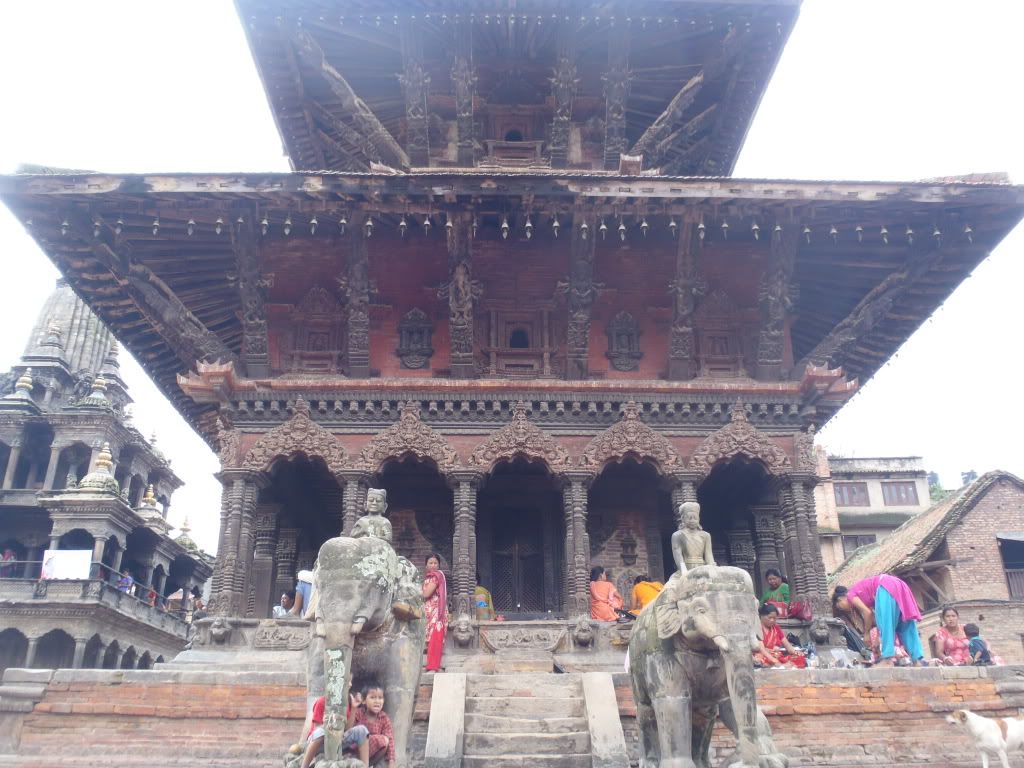
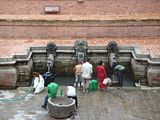
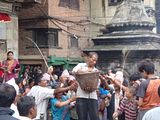
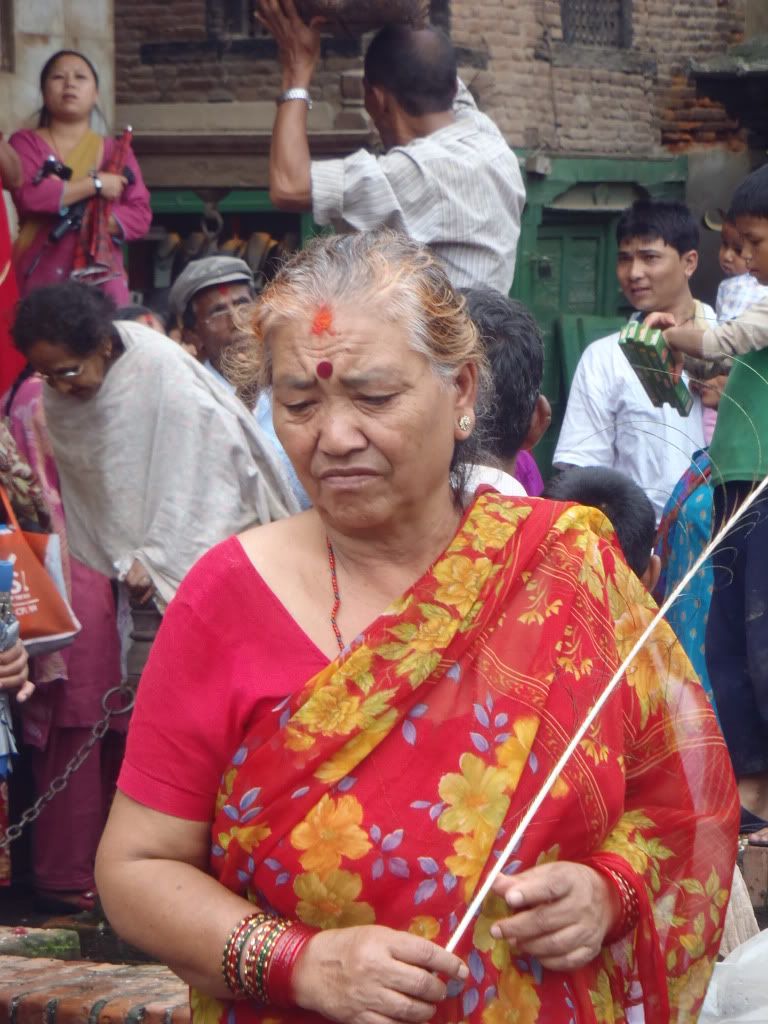
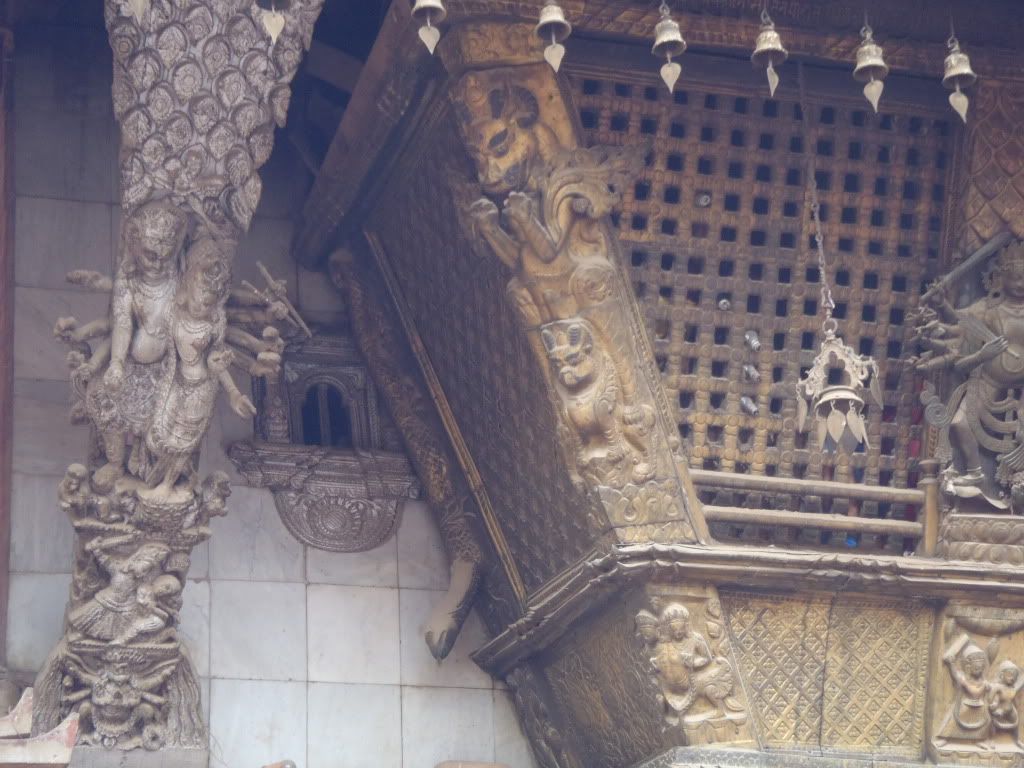
This began at the Ganesh shrine in southeast Patan, which we took a quick look at before turning right to cross into Sulima Square. The Lonely Planet describes the square as a, “crumbling brick-lined square with a 17th century Mahadev (Shiva) shrine” but that sounded more interesting than it looked once we got there. Anyways, what was of interest to us what a really old looking door on the east of the square which we learned used to be the house of a 16th century Tantric master. We admired the windows before passing the Chandeswari Temple which we recognized by the bell in front of it and the 600-year-old white stupa. The detail of the wood carving on this simple temple was just impressive – but it’s difficult to appreciate unless one makes the effort to get a really close look.
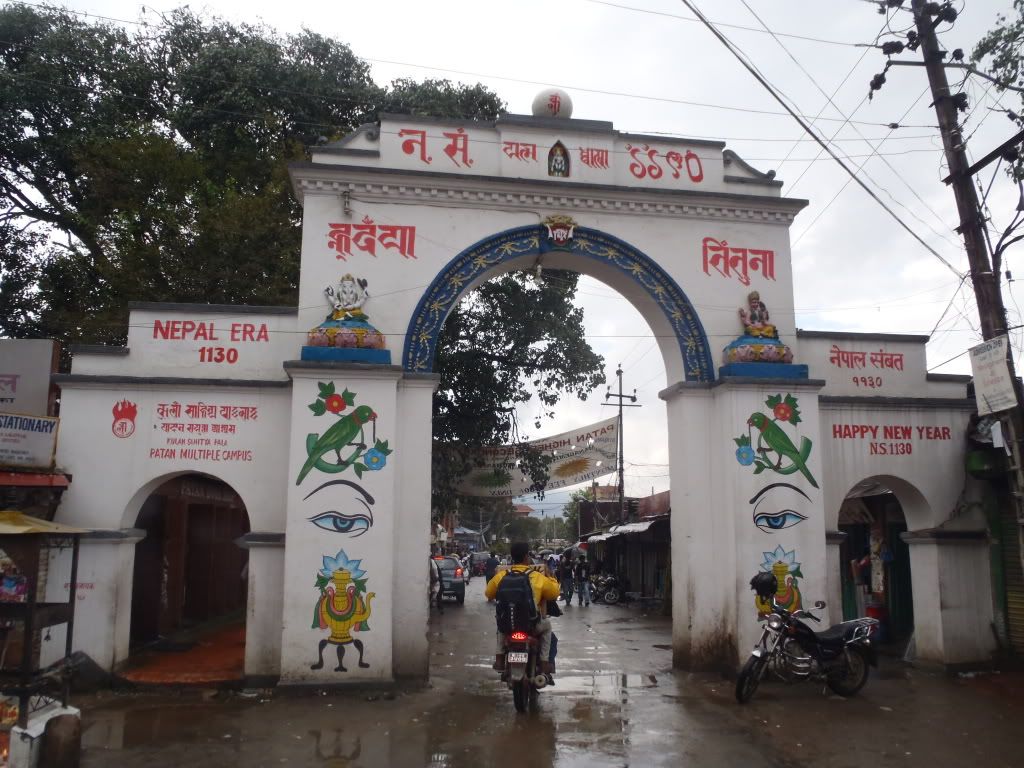

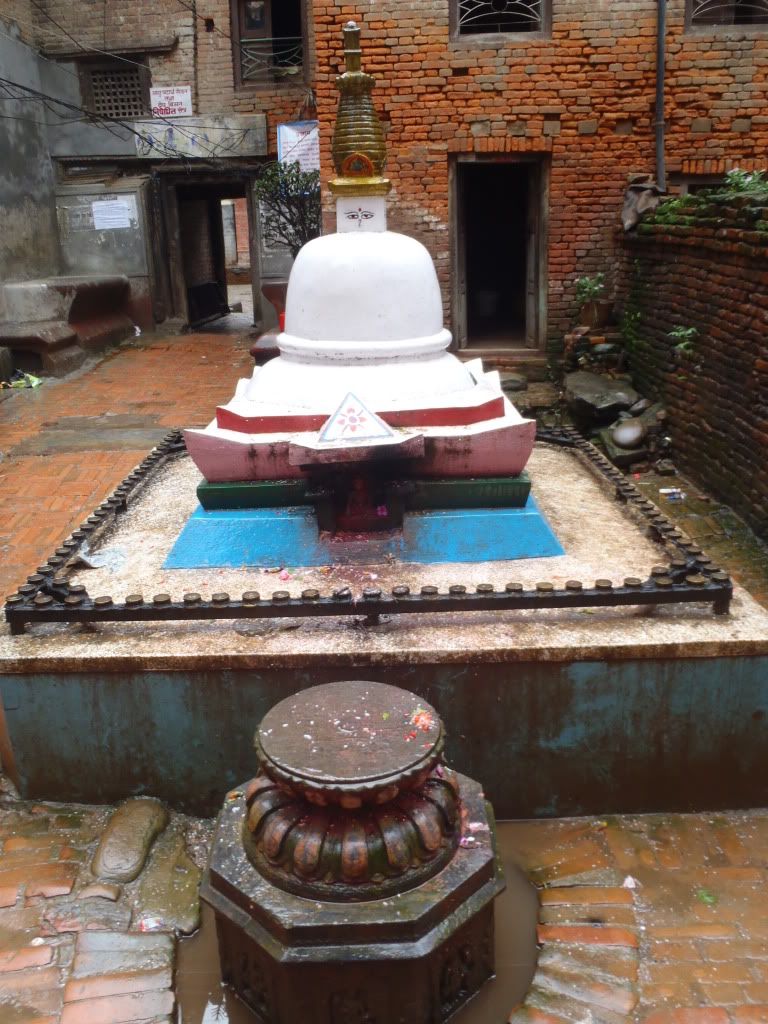
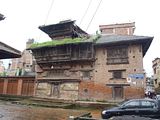
Next we found another square to explore – Nakabhil. This one was larger than the last square, and even included a monastery known as the Lokakirti Mahavihar. While we didn’t see a ton of monks like in Tibet (we’re pretty sure it was a former monastery as there were people camped out all over) but we did find some interesting murals and creepy festival masks. Not wanting to slow down our pace (who knew if the rain would come back!) we continued to yet another courtyard, this one with another, significantly larger, white stupa plus a Buddha statue. In this area we noticed some of the buildings looked incredibly old – like on the verge of crumbling – with their shape twisted and falling. Some of these smaller, older buildings were sandwiched in between slightly stronger, newer ones and the captured image turned out quite interesting in our photos. Walking across the courtyard and into a side-alley, we came to a bull (Nandi) – a place where we were supposed to spot a painting of a naga somewhere on the walls. Not seeing any nagas, kept walking past another courtyard and monastery to the Golden Temple.
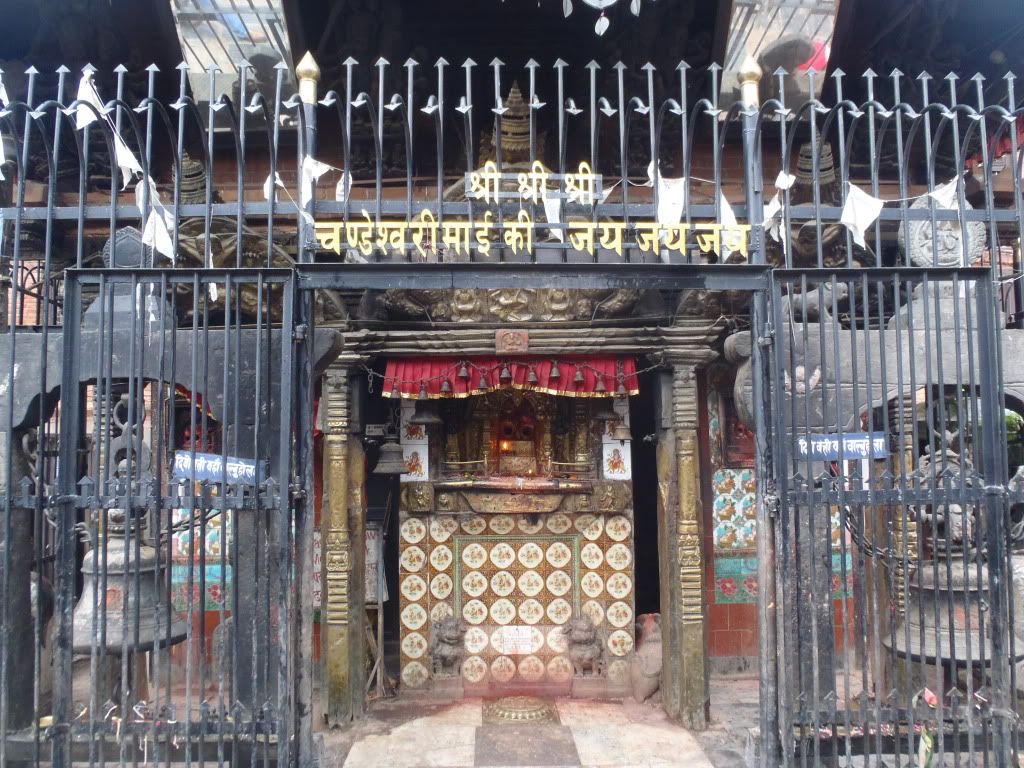
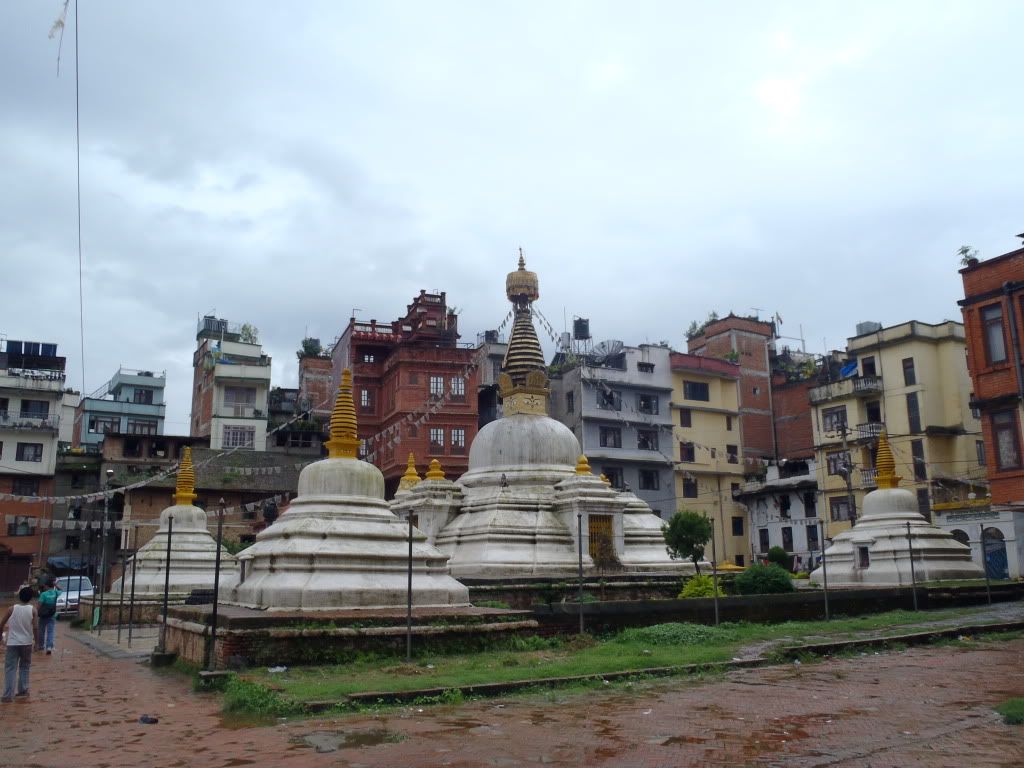
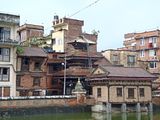
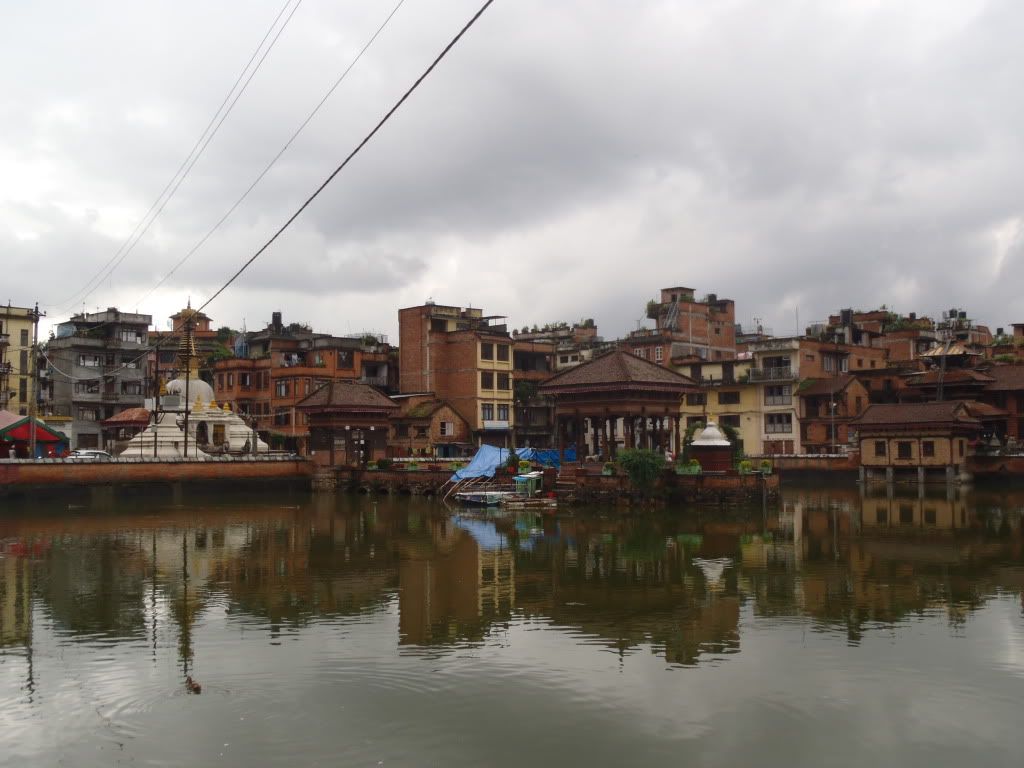
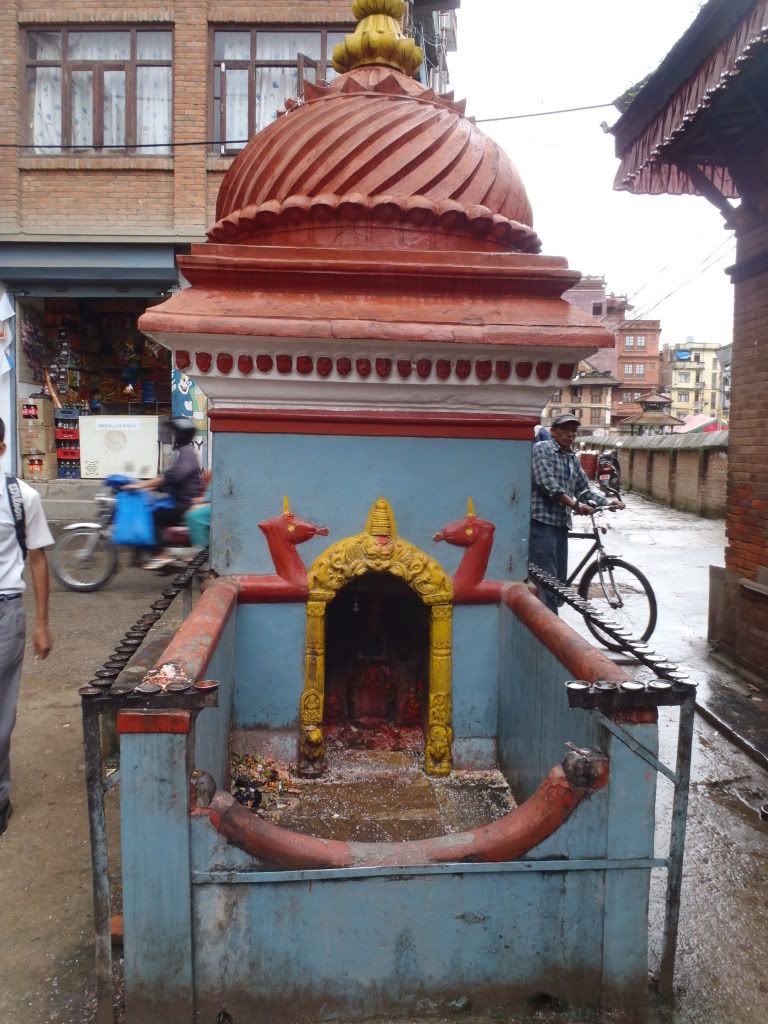
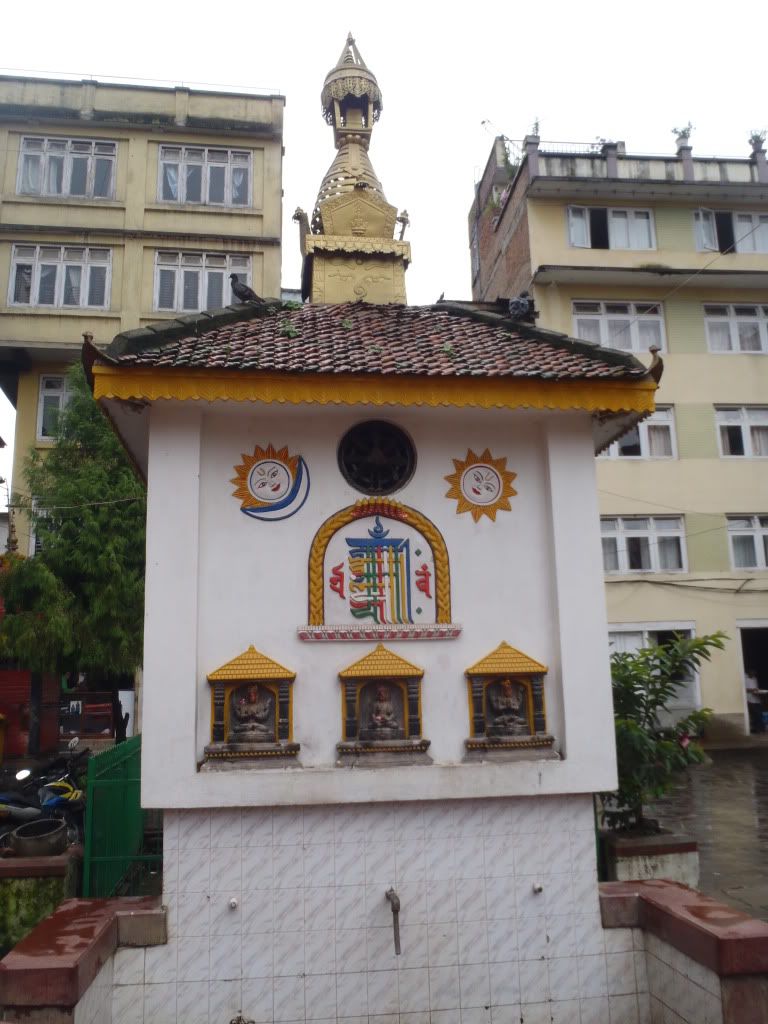
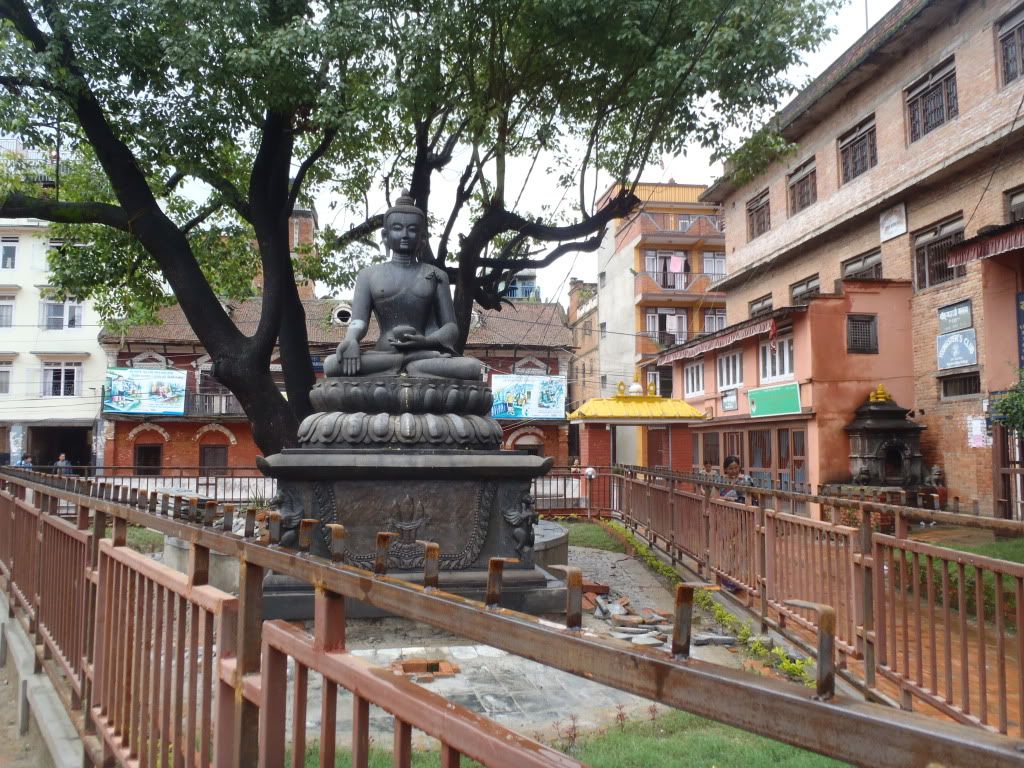
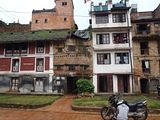
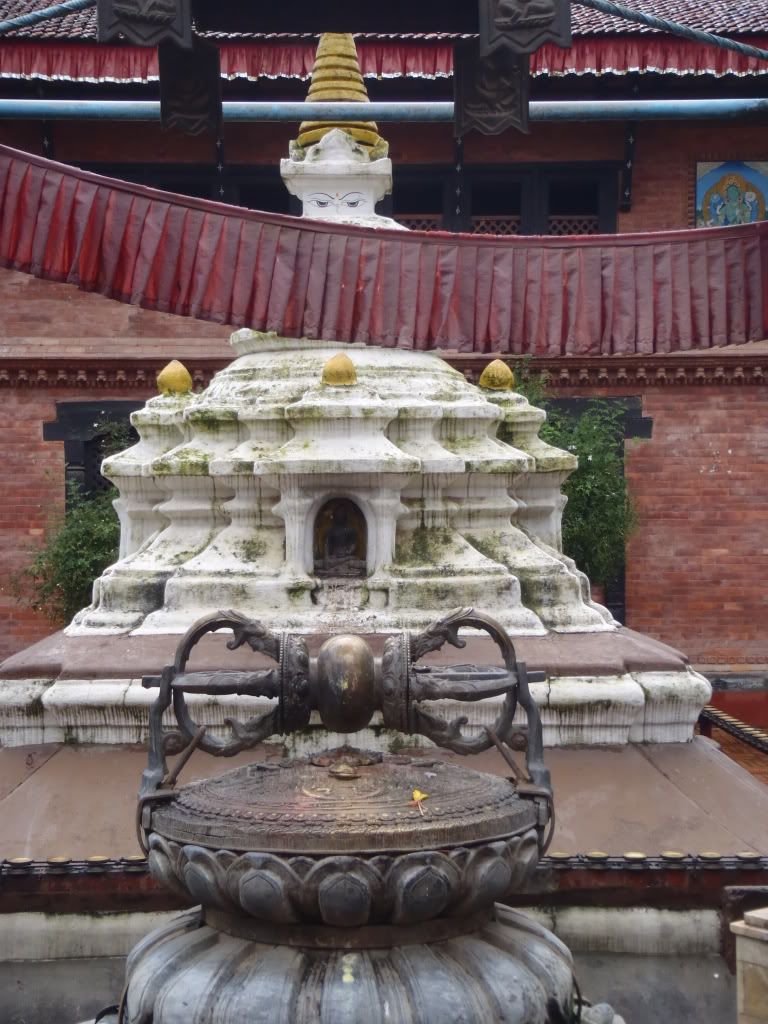
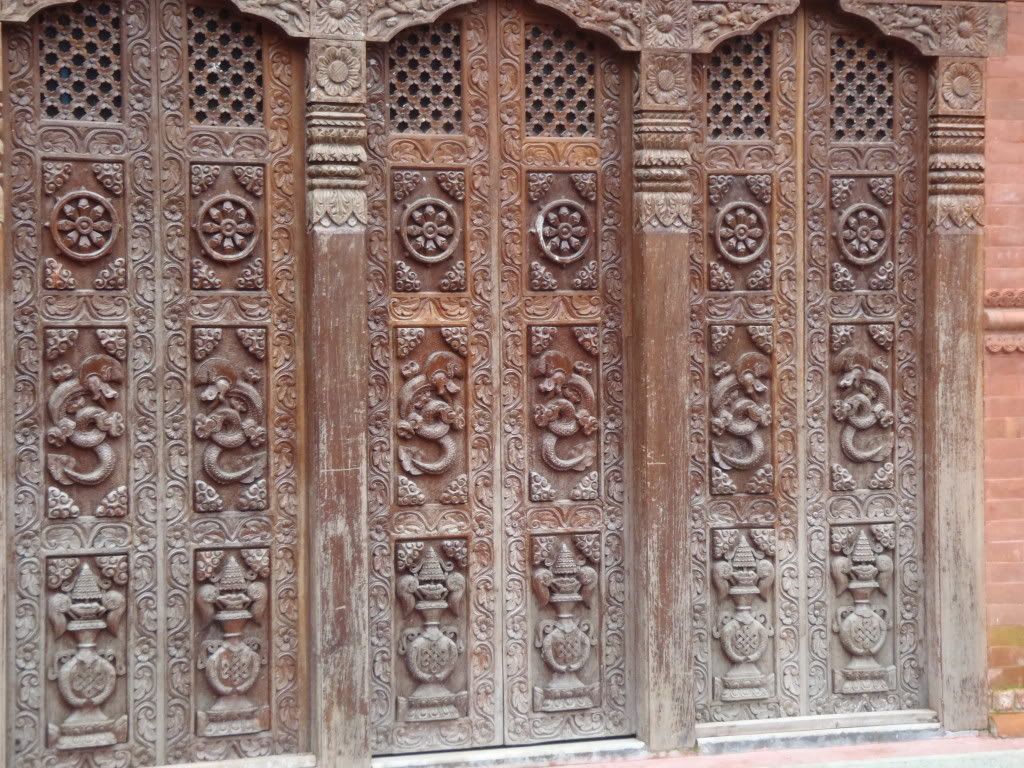
The Golden Temple was founded in the 12th century and its doors remain open in a gesture of acceptance to all religions. At the center of the temple complex stands a rectangular gold temple with lions guarding it. Small details like the intricate bird and Buddha-head sculptures or that of a monkey holding a jackfruit really gave the place a unique charm. Henk waited for the ‘keepers’ of the temple to allow him to take some pictures of the various jeweled, gold and/or silver Buddha statues, and we wandered around admiring bronze sculptures of dragons and elephants. Before leaving the temple, we made sure to look up at the ceiling of the exit – there carved into the top was an extremely detailed (including many small figurine-like images) black and red mandala!
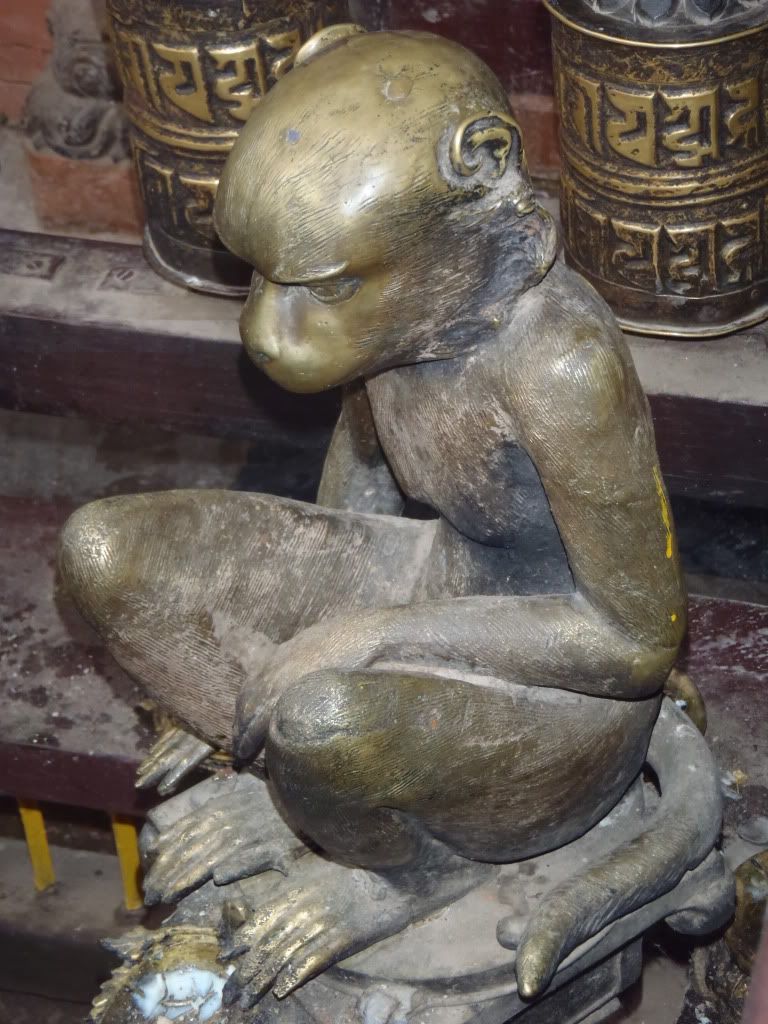
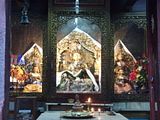
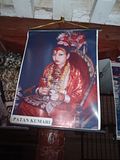
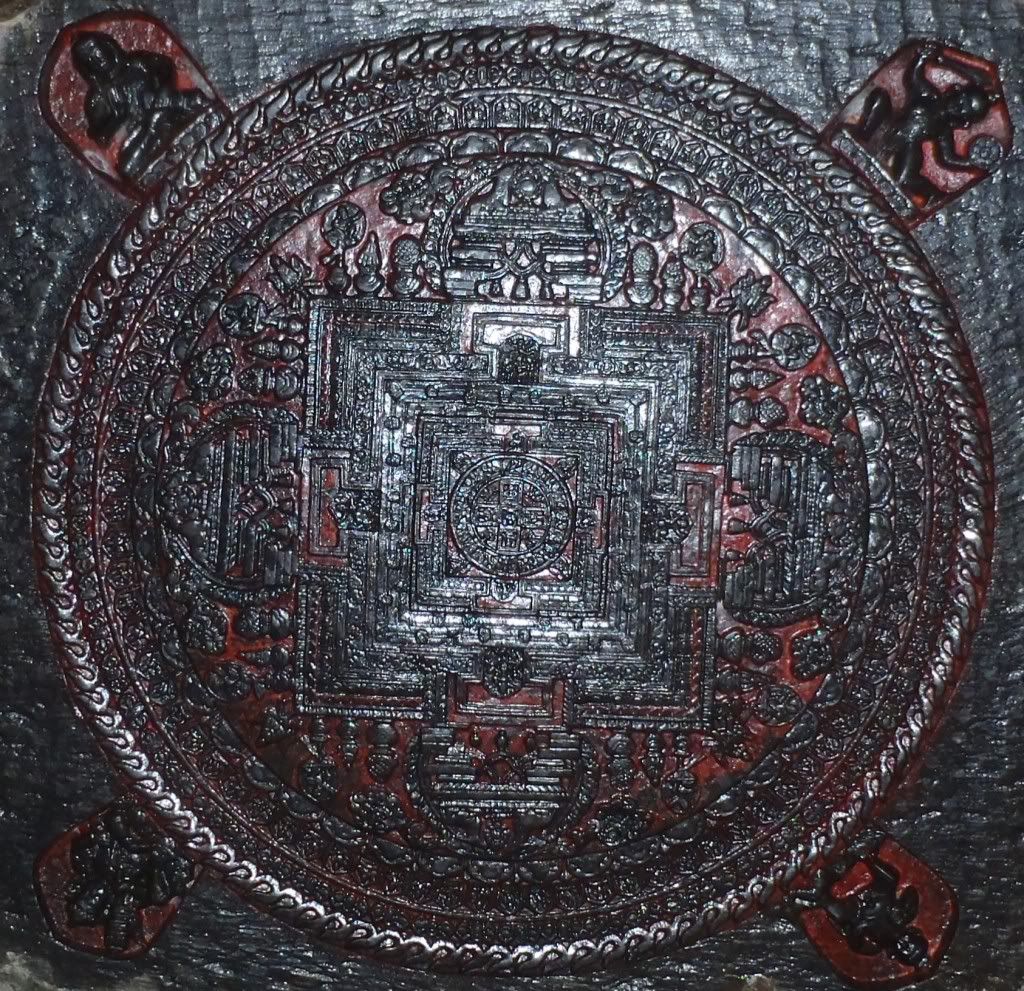
Once exiting the Golden Temple we turned left, down another narrow street that led us to a few more ‘mini’ temples. There were also some strange large yet simple ‘megaliths’ the Lonely Planet told us about which are supposedly the oldest objects of worship in the area. After we passed some amazingly beautiful and detailed carved windows, we spotted a similar set of faces – a standing Vishnu, and on either side of him were his consort (probably Lakshmi) and the human-form of his winged-vehicle Garuda. The most exciting part about seeing this small image was realizing that we could instantly recognize who the characters were! The museum really did teach us something. On our way back to Durbar Square we passed a bunch more Vishnu temples, but none of these really stood out too much.
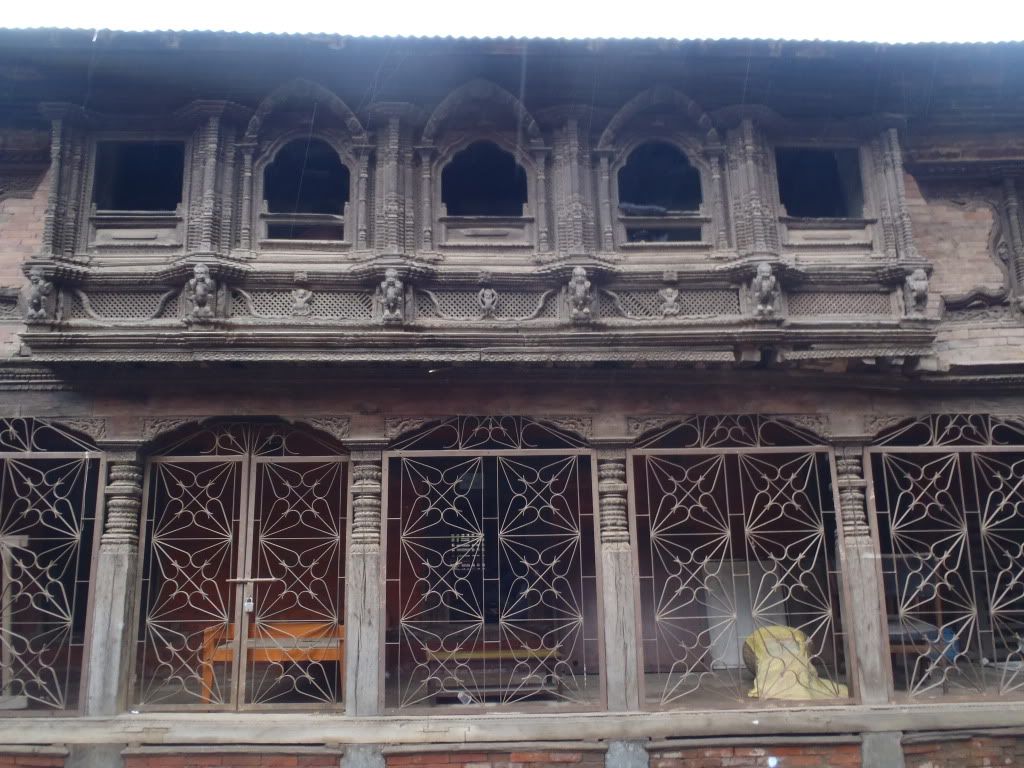
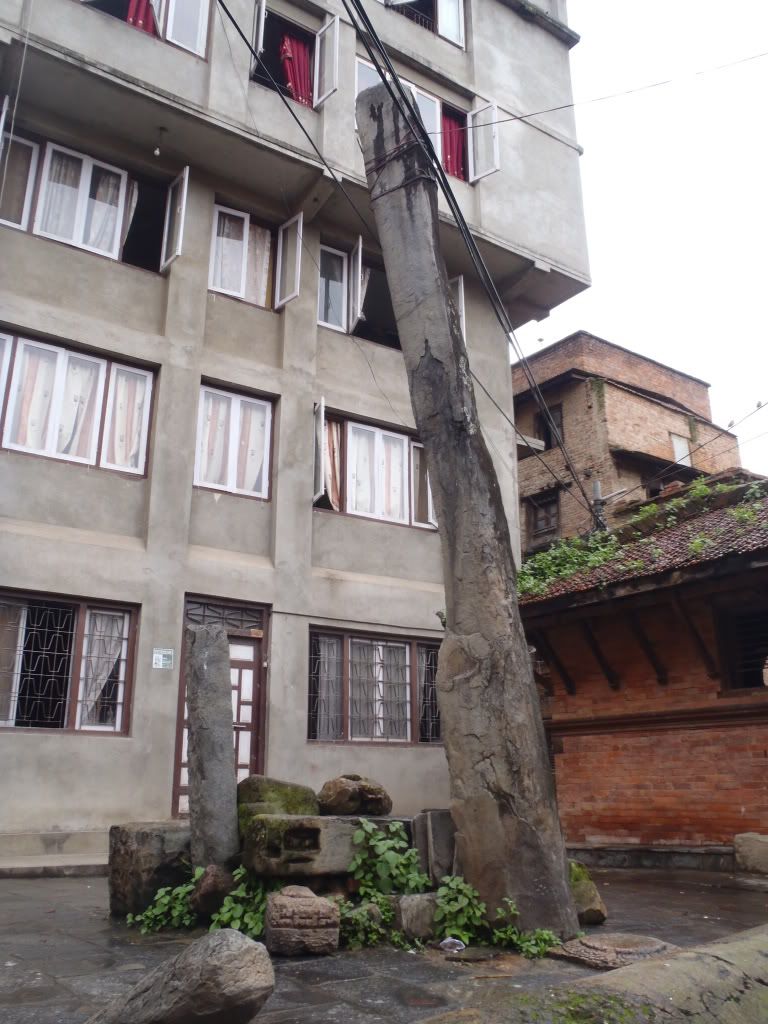
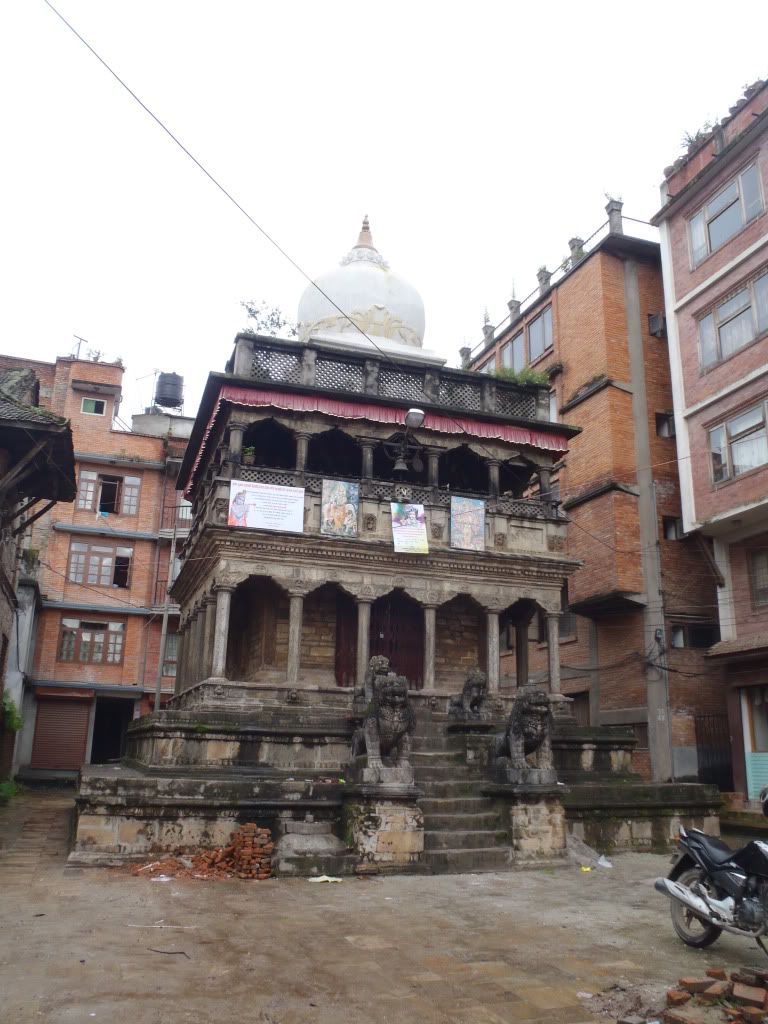
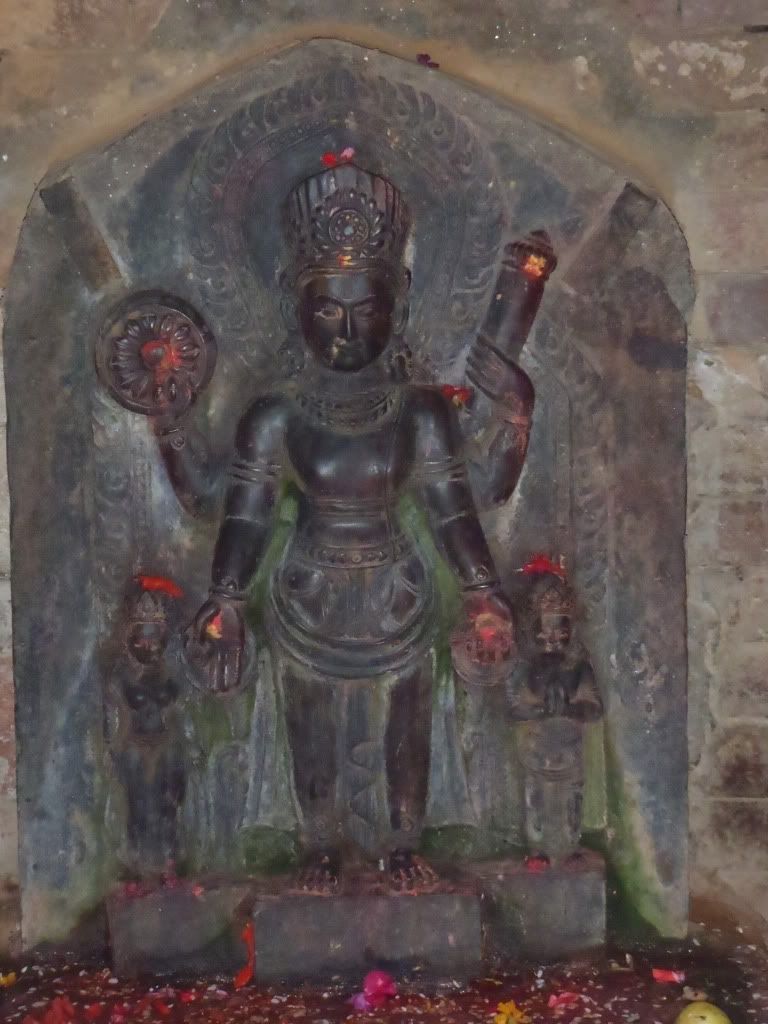
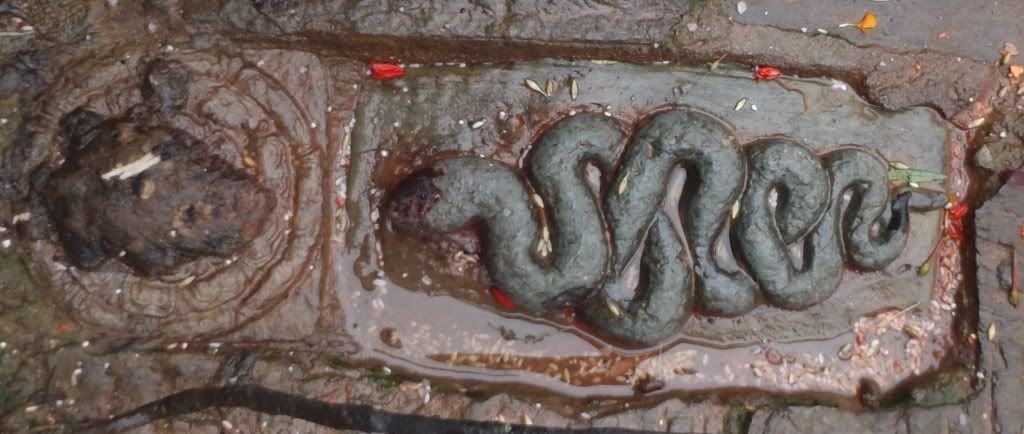
Passing through Durbar Square yet again, we decided to start on the second walking tour through southwest Patan that we had read about. However, since we had already done so much walking, and it was still quite rainy out, we cut it a bit short. We did get to see the Bishwakarma Temple as well as some brightly painted animal statues so popular in Nepal. After our little walk we jumped into a taxi pretty exhausted. We did make one stop on the way back to the hotel through… at a beautiful secluded garden known as the ‘Garden of Dreams.’ The pristine white building and lush grass were a huge contrast to the crumbling, shabby buildings surrounding them.
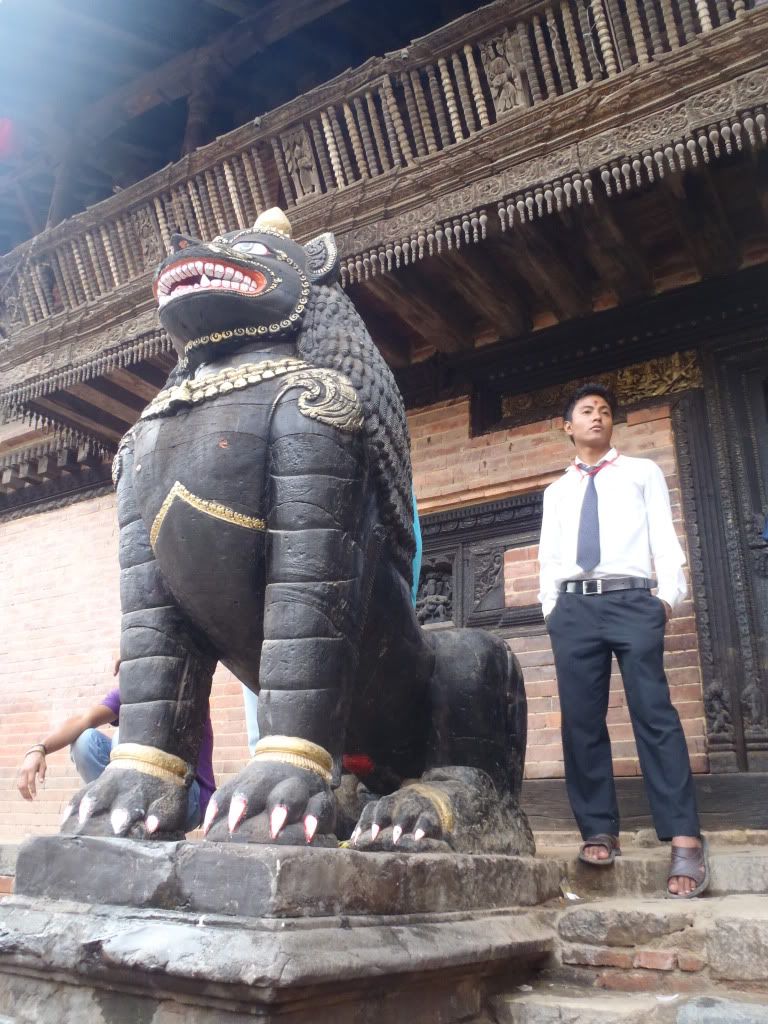
We explored the gardens, finding little hidden pathways and water displays around the corners – even a photo gallery of the gardens’ restoration. There were some secondary gardens, but they weren’t too impressive. We did like the statue of Lakshmi, which looked more Greek than Nepalese to us. Upon reading the description we realized our instincts were right! The statue was originally of Nike, the Greek goddess of victory. It had to go through some remodeling to ‘become’ symbolic of the Hindu goddess of wealth – including adding symbols of Lakshmi such as coins and lotus flowers in her hands.
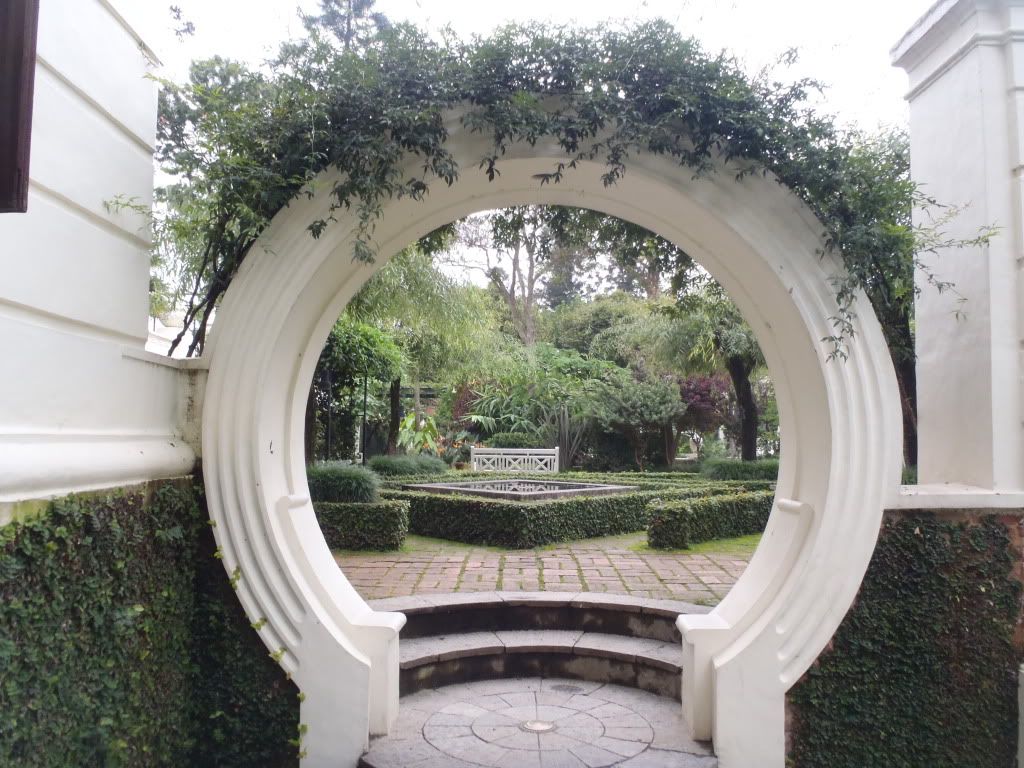
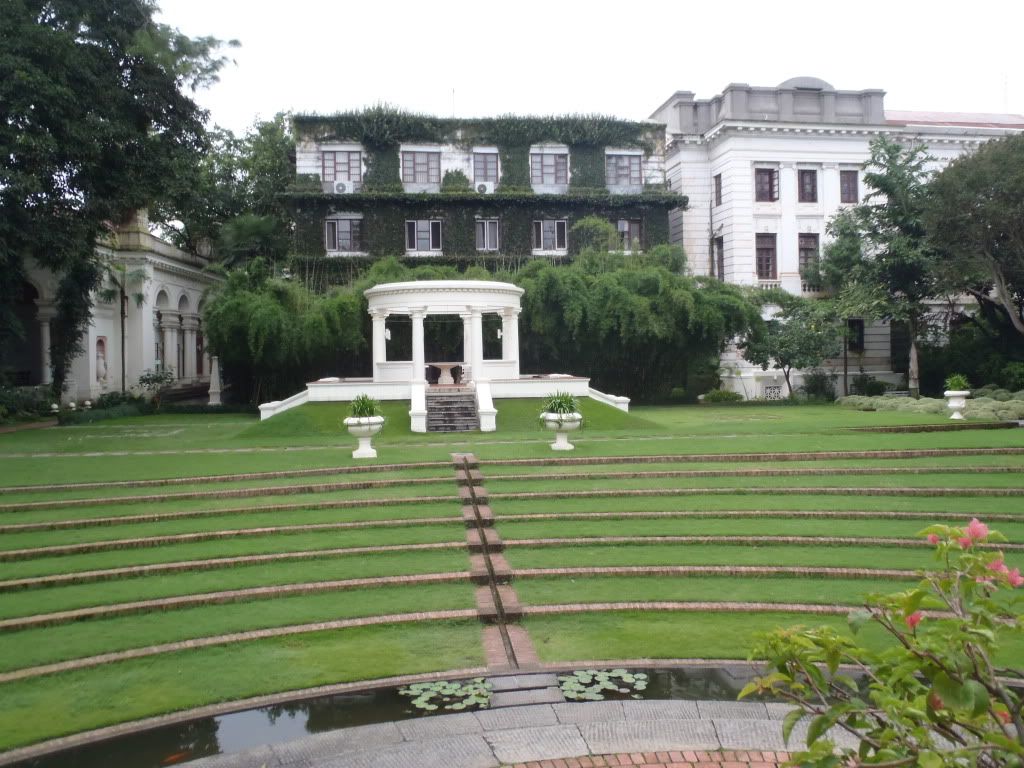
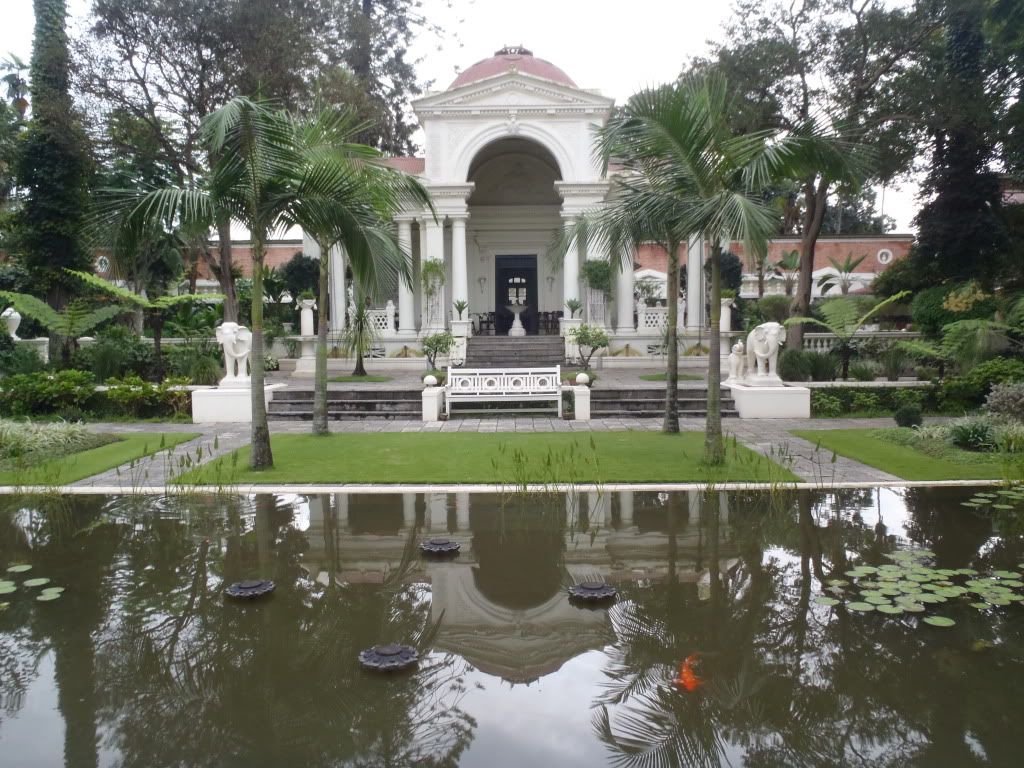
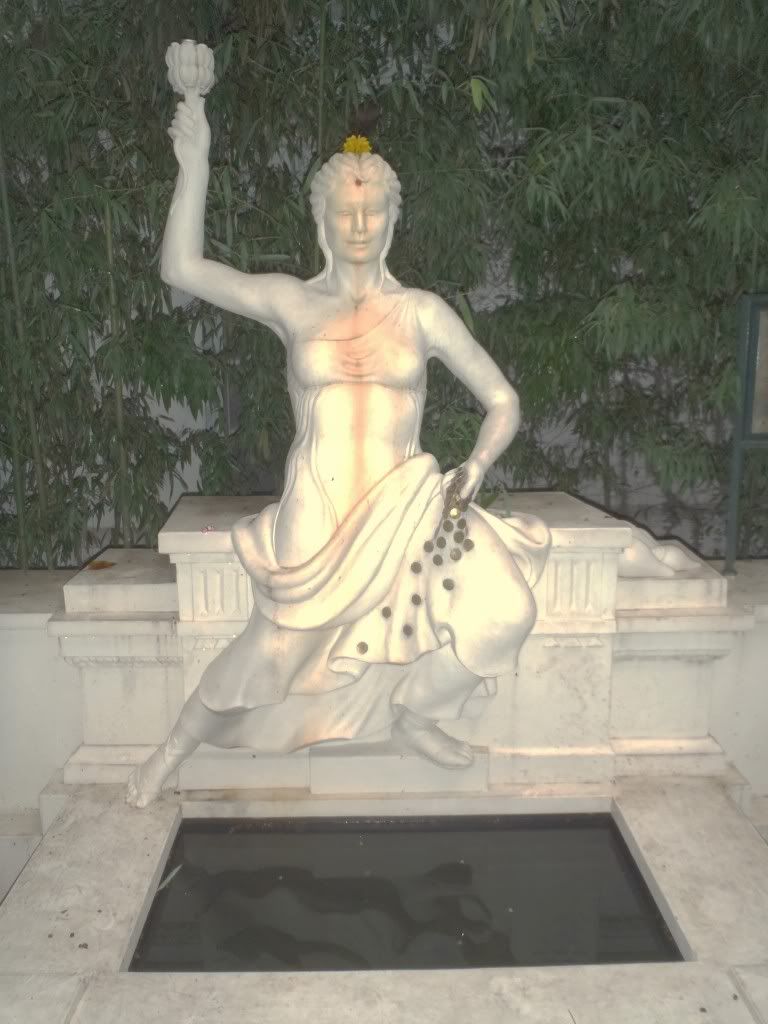
We considered eating there at the gardens but it was quite expensive so we headed back to Thamel to pick up some food instead and relax after our intensive day.
Francesca
One thing to note – the spiritual concepts of Hinduism and Buddhism are often mixed in Nepali religious belief. While most people self-identify as Hindus, they also accept many Buddhist ideas as their own and vice-versa with the Nepali self-identified Buddhists. Thus many of the sites Henk and I explored in and around the Kathmandu Valley included both Hindu and Buddhist aspects. Swayambhunath is a Buddhist site, specifically special to Tibetan Buddhists but at the same time the site is sacred in Hinduism as well, so we saw plenty of Hindus there.
Henk and I viewed the ‘World Peace Pond’ complete with Buddha statue in the center before we walked up the right-hand stairway, making sure to walk clockwise, keeping the stupa on our right side. And of course there are the monkeys – which happen to be holy monkeys! According to Wiki: “They are holy because Manjushree, the bodhisattva of wisdom and learning was raising the hill which the Swayambhunath Temple stands on. He was supposed to leave his hair short but he made it grow long and head lice grew. It is said that the head lice had transformed into these monkeys.” We maneuvered our way past them, bought a bottle of water, and continued until we could see an amazing view of the valley below.


First we explored the grounds, walking to all corners of the complex and noticing an interesting game called “Tiger Moving” for sale involving a game-board and miniature tigers and goat figures. The object of the game is for the ‘tiger player’ to be on the offensive with the ‘goat player’ on the defensive. While we wanted to purchase one the prices, even after haggling, were still too high – but we did find out they are manufactured somewhere on Freak Street and made a mental note to try and get one later. The one purchase we did make at the temple was miniature versions of ‘Buddha’s Eyes’ necklaces for our collection of little charms from different countries.
There was a tiny museum at the temple which housed some statues which we ducked into first, but the main ‘event’ at Swayambhunath is a large, white stupa sitting in the center of the raised platform. The stupa has both “Buddha’s Eyes” and the swirling symbol of “Unity” in Nepali in between the eyes. While we had seen these Buddha Eye stupas quite a few times now in Kathmandu, this was particularly striking because of its size. It was quite eerie to know that no matter where you walked in the complex, you could look back and see the ‘all-seeing’ staring back at you. The large dome recently had 20 kgs of gold added to it, as part of a renovation project.


As we walked around the stupa, we noticed a bunch of ‘mini stupas’ to the side… an entire army of them! On our way to explore them we came across a curious monkey who was trying to get inside a large, white bag. Another monkey joined the first and they managed to rip a hole to get to the contents inside. As we were taking pictures of the valley below, we encounter monkeys yet again. One decided to jump onto the banister separating everyone from the long drop down, which caused both us tourists and local Nepali to jump back a little. But thankfully, someone managed to satisfy the monkey with a cucumber slice and he soon let everyone return!












Once we finished at the temple, Henk negotiated with a taxi driver to take us to Durbar Square for the day’s festival. We weren’t really sure what to expect, but we knew the festival was going to be going on all afternoon and it would be cool to see some of it. Nepali, like Filipinos, are infamous for their huge number of festivals – pretty much something going on every other week during the ‘busy’ times – and we wanted to experience some of the fun! Once the taxi dropped us off in the square, we immediately noticed a difference from our first visit to the square; first of all everyone was decked out in beautiful, colorful clothing, especially the women in their bright red, sparkly saris! Every single one of them had jewelry – rings, earrings, necklaces, bangles! Walking around without anything dangling off or jingling on yourself would seem quite plain in Nepal! All of the action was located at Krishna’s (an avatar or incarnation of Vishnu) temple in the square where colorful strings of banners had been put up.



There were men sitting on the streets with sheets laid out in front of themselves and women surrounded them. Once we saw colorful bowls, we figured out that they were men who could apply a ‘fancy tika’ (the red marking over the third eye) to those who wanted one for the event. And of course, in front of Krishna’s temple, was a long line of people waiting to give their respects to the divine on his birthday. They would enter the temple, go up the stairs swinging a basket, perhaps for the god’s attention or well-wishes, and then leave offerings before the image inside. After watching the line of devotees for a while, we followed the sounds of music to a spot across from the temple where tons of local Nepali were gathering together to dance. People would just get up randomly to start a dance or join in and it was entertaining to watch those in the colorful outfits dance traditionally along with the music. But the people dancing in jeans the T-shirts – well, that wasn’t so special, so we soon moved on.








We then took a rickshaw from Durbar Square back towards our hotel before walking the rest of the way in search of a Tibetan flag. Not seeing anything we liked, we picked up some falafels (well, they are actually the chicken wraps) from the Or2k stand outside their restaurant and some groceries. Once we got back to our room we simply chilled out for the rest of the evening.
September 2nd was the day to explore the last of the 3 former city-states which competed for power back in the day: Patan. After another sumptuous breakfast that morning, we had a taxi drop us off in the heart of the city, and rather than get a guide, we decided to follow the Lonely Planet’s walking tour advice. Listed as a World Heritage Site, Patan’s entire make-up is of 16th century+ buildings that are jaw-dropping in their completeness. Much like Bhaktapur, this ancient city really gives visitors a glimpse back into Nepal’s glorious past and rich culture. Most of the Palace Complex monuments are located in Patan’s Durbar Square, having been built in the early 1600’s by King Siddhi Narsingh Malla. King Malla conquered the city, which had previously been ruled by local noblemen.
Henk and I decided to visit the popular Patan Museum first, and then after walking around the square, head out on our tour around the rest of the city. Well, the Patan Museum deserves its famed reputation for sure! It was extremely detailed in its description of various Hindu Gods and Goddesses, while at the same time clear in its explanations and informative. After going through this museum, I really feel like I have both a far better understanding of the pantheon of deities Hindus worship and the ability to look at a stone or bronze carving and actually understand what is going on without a guide or book! In fact, most of the motifs used in Hindu art are quite repetitive, so once you get the gist of the characters it isn’t too hard to recognize them once you see them again. Most characters have the same ‘position’ they are usually in (sitting a certain way or standing; fierce manifestations take active poses whereas peaceful manifestations hold meditative poses) plus the same objects in their hands or the same ‘vehicle’ (usually an animal companion they ride on) accompanying them. The way the figures’ hands are positioned is so important (since it conveys that deity’s particular emotions or personality) that it has a special name: mudra.
The stone slabs were the first items we saw, which had some ancient stone documents describing various dedications by rulers or donations by rich ancients. These have been in use, we read, since the 5th century in Nepal. One interesting example we saw was of a stone document inscription with a shivalinga, and a cow suckling her calf. This section wasn’t too interesting though, so we moved on to the Buddhist/Hindu deity section which informed us of the positions and descriptions I noted above. I’ll give an example of how to put such information to use when you look at a statue:

Above you see the image of the Buddha which you’ve probably seen a gazillion times if you’ve traveled through Asia. First look at the Buddha’s feet and legs. Are the legs crossed? Are the feet upturned towards the sky? This is known as the Diamond/Thunderbolt/Lotus position. If Buddha’s legs had been folded, but not crossed, he would be in the ‘noble attitude’ position instead. More importantly, now look at the Buddha’s hands. Here, Buddha has his right hand hanging down while his left is palm upward in front of him. This particular gesture signifies that Buddha is “calling the earth” to witness his persistence in continuing to meditate despite disruptions by a Mara demon. If, for example, his hands had instead been forming a circular motion while being intertwined, this would be a sign that in this image Buddha would have been teaching or calling upon the Wheel of Law.
The next deities we looked at were various avatar (incarnations representing aspects/traits of popular deities) pairings done by 12th century stone sculptures. The first was “Uma-Mahesvara.” Mahesvara is an avatar of the Hindu deity Shiva and Uma is an avatar of Parvati, Shiva’s wife or female form. The pair is famed for living on Mount Kailash back in Tibet, which is why Hindus as well as Buddhist consider the mountain sacred. Mahesvara, being more important than Uma, is depicted as larger than her in size. We also see Shiva’s vehicle, the bull Nandi, to Mahesvara’s right hand side. Further to the right of Nandi we see one of Shiva’s two sons, Kumara, holding a lance. Also in the sculpture is Shiva’s other son, the elephant-headed Ganesha. A side-note to this particular sculpture told us that it was stolen from the town Dhulikhel near Kathmandu and ended up in a German museum before eventually makings its way back to Nepal after its stolen image was published. It is absolutely insane to me how those in the “business” of historical treasures can simply disregard all sense of duty to future generations by moving around sacred and ancient objects as if they were simply chess pieces to be played with. How much potential knowledge we have lost due to them must be staggering… I can’t even think about the consequences, but they are no better than China’s former Red Guard in their actions.

I’ve already given an example of how the divine Shiva can have multiple forms – in his female version of Parvati and in his Mount Kailash-dwelling Mahesvara – but it is not just Shiva who can have avatars. Stepping back to understand some of the general aspects of Hindu deities’, the museum gave a great overview in the next room, which I’ll quote here:
“Hindu deities have numerous manifestations; the same deity can be benign in one aspect and fierce in another. They are frequently portrayed with multiple heads and limbs. [Francesca Note: This is common in ‘Tantric Buddhist’ art.] This distinguishes them as superhuman and permits them to hold a variety of emblems that define their personality and assist in their identification. With multiple hands the gods can hold multiple weapons. All are needed to combat malevolent forces in engagements that bear cosmic consequences.”

Nepali, while worshipping the entire pantheon of Hindu gods/goddesses, have a special fondness for Shiva – even referring to their beliefs as the “Way of Shiva” or “Shivamarga.” Because of this, I’ll choose Shiva as the deity to focus on for the next example. As explained by the museum quote, various deities in Hinduism hold objects to explain their personality. For Shiva, he may hold the trident, the crescent moon, the seed rosary, the double-headed drum, and the hand-held water pot. Shiva’s trident has three spikes representing the three aspects of the divine as creator, preserver, and destroyer. Furthermore the trident is a weapon against evil. The crescent moon represents Shiva’s peaceful side, since it is often a symbol of a yogi. Both the seed rosary and the hand-held water pot are also yogi symbols, with the water pot representing the sacred waters of India’s Ganges River or Nepal’s Bagmati River. The last symbol is Shiva’s double-headed drum. I find Shiva’s drum the most interesting of all his objects because it represents the ‘fundamental creative force.’ Since the drum is ‘double-headed,’ it also serves as a symbolic representation of male and female principles.

Next we came across a four-faced Shivalinga, which is specifically popular to Nepal. A relatively new object (17th to 18th century) the Shivalinga actually has five faces since there is a ‘hidden fifth’ face on the top of the linga. The four visible faces are each aspects of Shiva’s personality. In our picture you can see two faces—to the right is Bhairava, a wrathful avatar of Shiva, distinguishable by his curly head of hair. On the left is Nandi, which is not only Shiva’s vehicle but an aspect of Shiva himself as well. The other two faces are hidden from view.

We moved through the next sections slow and steady, as there was a lot to read and take in. I’ll just give a brief overview of the more interesting characters/images we encountered.
Ganesha (Shiva and Parvati’s son) is one of the most recognizable Hindu deities since he has the head of an elephant. He is the remover of obstacles, and often holds a radish which was, as the museum sign told us, “an alternate for the broken tusk he once hurled at the mocking moon.” (The moon was mocking Ganesha’s heavy weight.) In the plaque I selected to show below, Ganesha has six arms and six heads and has dancing bells on his legs similar, as the description read, to male Nepalese dancers. His vehicle, humorously, is a small rat which you can see here holding a laddu ball (sweet treat that represents wisdom) for Ganesha.


Vishnu is one of the main representations of the three divine aspects, along with Shiva and Brahma. While Shiva is the Creator, Vishnu is the Preserver of all things. His mount is Garuda, a ‘bird-man,’ and his symbolic objects are a powerful yet destructive royal mace, a lotus/ball, a discus representing both a royal weapon and the sun, and a conch shell representing both a royal battle trumpet and water. Here is a popular example of a stone carving with Vishnu and his objects, along with (on his left-hand side) the human form of Garuda (notice the wings sprouting from Garuda’s back draped around him) and (on his right-hand side) one of his wives, Lakshmi. Vishnu is also uniquely seen in Nepal as half Vishnu (right side) /half Lakshmi (left side) in statues. Here you can see their bodies are meshed together – half male dress, half female dress. Each unique male/female side also holds all of its specific objects with its many arms.

There was a brief break in the Hindu deities for a few Patan-centric artifacts. There were some ivory pieces, but most importantly the royal throne of Patan Kings for over a hundred years of their reigns. The sign nearby explained to us that all Kings of Nepal were considered to be incarnations of Vishnu. This being the case, the throne “creates the illusion” of Vishnu seated on his vehicle Garuda when the King (as Vishnu) sits on it. An inscription on the bottom of the throne reads: “May it be good. On Thursday, the eighth of the waxing moon of the lunar month Shravana, Nepal Era 787 [about August 8th, 1966] His Majesty King Shrinivasa Malla was offered an alms bowl and a golden throne attached with kadamba trees. Anybody can hire this throne on payment of two rupees to the families of coppersmith and carpenter. Let it be auspicious.”

Returning back to Hindu deities, Henk and I saw an interesting description associating the Vedic Gods with forces of nature. Indra is the god of rain, (and he is celebrated during the Indra Festival we will attend later at the end of the monsoon season in Kathmandu) Surya represents the sun, Chandra is the moon, and Agri represents fire. Below is a plaque of the sun god Surya. He is in the center holding two lotus flowers. On his right is the scribe Pingala and on his left is the staff bearer Dandi. Each of these so-called “nature gods” becomes more important during festivals that represent them throughout the year. There are also representations of the planets which are believed to control human lives.

Another interesting combination deity distinctly Nepali is that of Hanuman (Vishnu’s monkey god) plus Bhairava (Shiva’s avatar) – you can see in statues of this image that the Hanuman image is dominant but there are also four additional animal heads (boar, Garuda, tiger, horse.) The multiple heads and multiple arms on this esoteric Hanuman-mixed deity are quite common in Tantric Hindu belief. The Tantric doctrines give a method of ‘release’ from the cycle of rebirth in a single lifetime, if their practices are followed correctly. The methodology holds that it is only through the union of male and female energies that true ‘release’ from rebirth can be achieved. The male element is passive while the female element is active (representing power) and the male can only tap into that power via union with the female. We viewed an ancient esoteric manuscript (painting) which was formerly used by tantric practitioners in their studies, as well as some Buddhist tantric ‘union’ statues showing male-female sexual union.

The next section of the museum told us about Buddhism in Nepal, and the different ‘characters’ – such as Tara and the Indian Buddhist master who brought the knowledge to Tibet. Since our time in Tibet gave us much of that information already (which we’ve already discussed) we won’t go into that again here. I’ll just give you a little information about Buddhism that is specific to Nepal. For example, in Nepal there aren’t nearly as many monastic schools as in Tibet; most monks are part-timers and thus don’t need the space to study together. Additionally, in Nepal, it is believed that the ‘future Buddha’ or Maitreya is already present on earth and has just not been ‘found’ yet. Also popular with Nepalese Buddhist is the Dipankara, the Buddha of fixed light (protector of merchants), who they believe pre-dates the historical Buddha. Basically Dipankara is to Shakyamuni what John the Baptist was to Jesus – he pre-dated him, resembled him in action, and foretold the latter’s coming.
Henk and I crossed into the next set of galleries which explored a few mystery statues found in Nepal (but origin and deity unknown) as well as the process of metallurgy in Nepal. We saw step-by-step examples of Kathmandu Valley crafted metal figures. We learned that in Patan Newari people made their metalwork in their home – no matter if the object was for personal use or export. There was a famous ‘lost wax’ technique where, as we learned from the signboards posted, “… a wax model is encased in clay then melted out to be replaced by molten metal.” Another technique used was that of relief/embossing (hammer metal sheets to obtain designs), which is still popular in Patan.









Finally we went into the ‘former Nepal’ area of the museum where we encountered tons of black and white photos of what certain towns in Nepal used to look like. Thankfully due to preservation, reconstruction, and lack of intense war, it is very much the same as what we see today! Here were a few of the more striking photos, including a photo of the first CAR in Nepal (before there were even any streets) being carried over a river by Nepali men:








Once we finished with the museum, I remembered there was a little section at the beginning we hadn’t seen yet. It was just examples of decorative wooden window and roof carvings, which we’d seen all over the ancient buildings still standing in the Kathmandu Valley. We took a couple pictures before checking out the cafe in the back garden. Pretty, but overpriced, we decided to go out into the Durbar Square of Patan. Entering the square, we noticed many women dressed up in colorful red saris, carrying offerings in baskets with them. We realized that Patan was also celebrating Krishna’s birthday, and the women and men were lining up to leave the deity some honorary gifts, such as peacock feathers. The first place we went into was Sundari Chowk, an area that had a water tank in the center. The tank, known as Tusha Hiti, was beautifully carved with Hindu images and, while we couldn’t go any further than the tank itself, was worth a look. There were even small dollhouse-like replicas of temples on the edge of the water tank! Right across from the tank was a tiered octagonal Krishna Temple with banners hanging on it for the day’s festival.









The next major temple of note was the impressive multi-tiered Hari Shankar Temple built in the 1700’s by the King’s daughter in honor of a hybrid Shiva-Vishnu deity. This temple looked similar to many others we’d seen by now, but we noticed the detailed ‘hell-torture’ carvings on it. Nearby was the mandatory tall statue of King Malla himself and further down the square was the large building containing the Patan Museum which had a doorway framed by a golden gate known as the Sun Dhoka. There was one main window on the top floor covered in gold foil. A similar looking window in Kathmandu has the Kumari (living goddess) appearing from it, but Patan’s window sometimes had appearances from the King himself. Another small temple we encountered was the brick Vishnu-dedicated Jagannarayan Temple which was covered on top in the same green mold we had seen on other structures in the square. Except this one had stone lions guarding it! Plus this temple is in honor of Vishnu’s incarnation Narayan, who was the creator of the universe and is probably the oldest in Patan’s Durbar Square. Finally we made our way past the Krishna Mandir, where the worshippers were also honoring Krishna on his birthday. It was almost 2:30 PM at this point and Henk and I were getting hungry for something to snack on. Plus it looked quite overcast (it IS still the monsoon season after all) and was starting to sprinkle on us, so we wanted to head for cover. After a couple sandwiches at the rooftop restaurant Cafe Du Temple, vegetable for Henk and a grilled chicken for me, we headed for our walking tour around Patan.















This began at the Ganesh shrine in southeast Patan, which we took a quick look at before turning right to cross into Sulima Square. The Lonely Planet describes the square as a, “crumbling brick-lined square with a 17th century Mahadev (Shiva) shrine” but that sounded more interesting than it looked once we got there. Anyways, what was of interest to us what a really old looking door on the east of the square which we learned used to be the house of a 16th century Tantric master. We admired the windows before passing the Chandeswari Temple which we recognized by the bell in front of it and the 600-year-old white stupa. The detail of the wood carving on this simple temple was just impressive – but it’s difficult to appreciate unless one makes the effort to get a really close look.




Next we found another square to explore – Nakabhil. This one was larger than the last square, and even included a monastery known as the Lokakirti Mahavihar. While we didn’t see a ton of monks like in Tibet (we’re pretty sure it was a former monastery as there were people camped out all over) but we did find some interesting murals and creepy festival masks. Not wanting to slow down our pace (who knew if the rain would come back!) we continued to yet another courtyard, this one with another, significantly larger, white stupa plus a Buddha statue. In this area we noticed some of the buildings looked incredibly old – like on the verge of crumbling – with their shape twisted and falling. Some of these smaller, older buildings were sandwiched in between slightly stronger, newer ones and the captured image turned out quite interesting in our photos. Walking across the courtyard and into a side-alley, we came to a bull (Nandi) – a place where we were supposed to spot a painting of a naga somewhere on the walls. Not seeing any nagas, kept walking past another courtyard and monastery to the Golden Temple.










The Golden Temple was founded in the 12th century and its doors remain open in a gesture of acceptance to all religions. At the center of the temple complex stands a rectangular gold temple with lions guarding it. Small details like the intricate bird and Buddha-head sculptures or that of a monkey holding a jackfruit really gave the place a unique charm. Henk waited for the ‘keepers’ of the temple to allow him to take some pictures of the various jeweled, gold and/or silver Buddha statues, and we wandered around admiring bronze sculptures of dragons and elephants. Before leaving the temple, we made sure to look up at the ceiling of the exit – there carved into the top was an extremely detailed (including many small figurine-like images) black and red mandala!




Once exiting the Golden Temple we turned left, down another narrow street that led us to a few more ‘mini’ temples. There were also some strange large yet simple ‘megaliths’ the Lonely Planet told us about which are supposedly the oldest objects of worship in the area. After we passed some amazingly beautiful and detailed carved windows, we spotted a similar set of faces – a standing Vishnu, and on either side of him were his consort (probably Lakshmi) and the human-form of his winged-vehicle Garuda. The most exciting part about seeing this small image was realizing that we could instantly recognize who the characters were! The museum really did teach us something. On our way back to Durbar Square we passed a bunch more Vishnu temples, but none of these really stood out too much.





Passing through Durbar Square yet again, we decided to start on the second walking tour through southwest Patan that we had read about. However, since we had already done so much walking, and it was still quite rainy out, we cut it a bit short. We did get to see the Bishwakarma Temple as well as some brightly painted animal statues so popular in Nepal. After our little walk we jumped into a taxi pretty exhausted. We did make one stop on the way back to the hotel through… at a beautiful secluded garden known as the ‘Garden of Dreams.’ The pristine white building and lush grass were a huge contrast to the crumbling, shabby buildings surrounding them.

We explored the gardens, finding little hidden pathways and water displays around the corners – even a photo gallery of the gardens’ restoration. There were some secondary gardens, but they weren’t too impressive. We did like the statue of Lakshmi, which looked more Greek than Nepalese to us. Upon reading the description we realized our instincts were right! The statue was originally of Nike, the Greek goddess of victory. It had to go through some remodeling to ‘become’ symbolic of the Hindu goddess of wealth – including adding symbols of Lakshmi such as coins and lotus flowers in her hands.




We considered eating there at the gardens but it was quite expensive so we headed back to Thamel to pick up some food instead and relax after our intensive day.
Francesca

0 Comments:
Post a Comment
<< Home